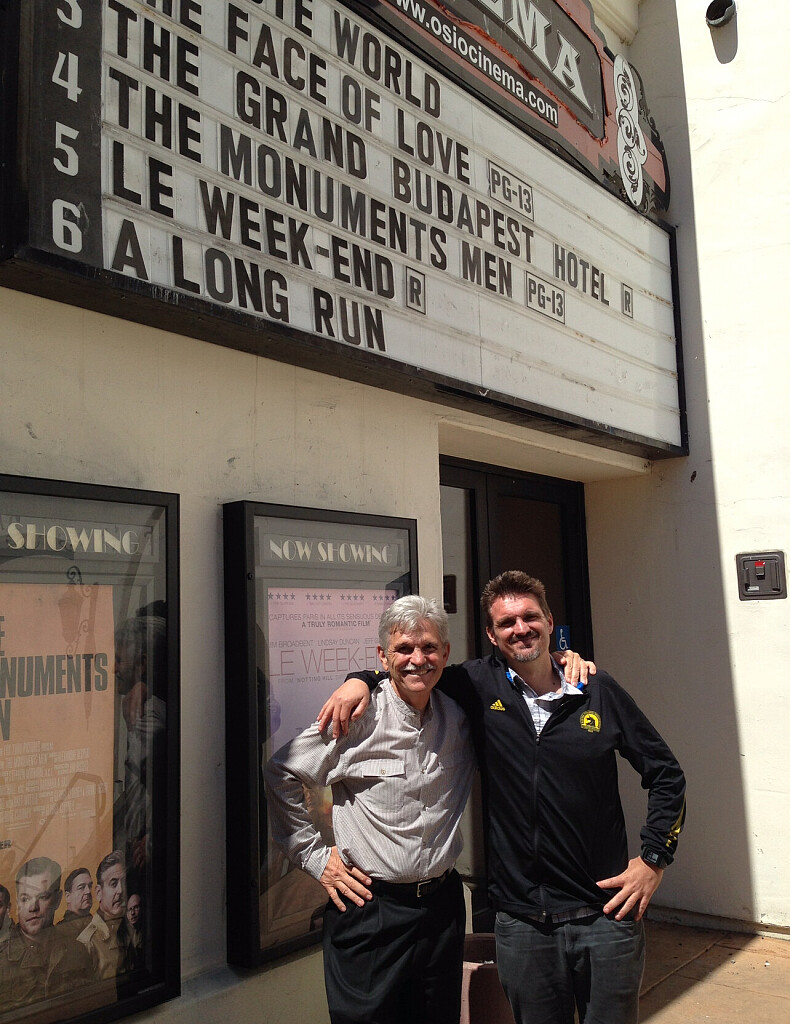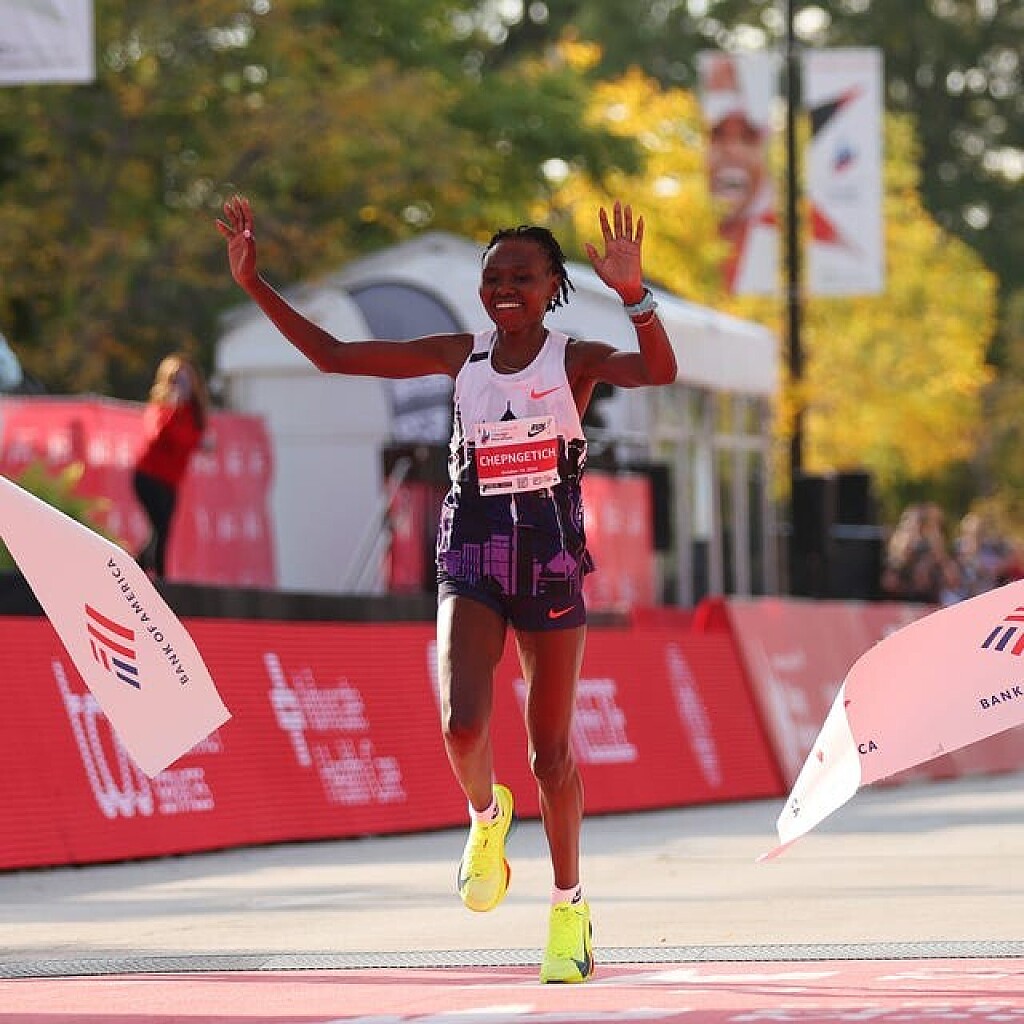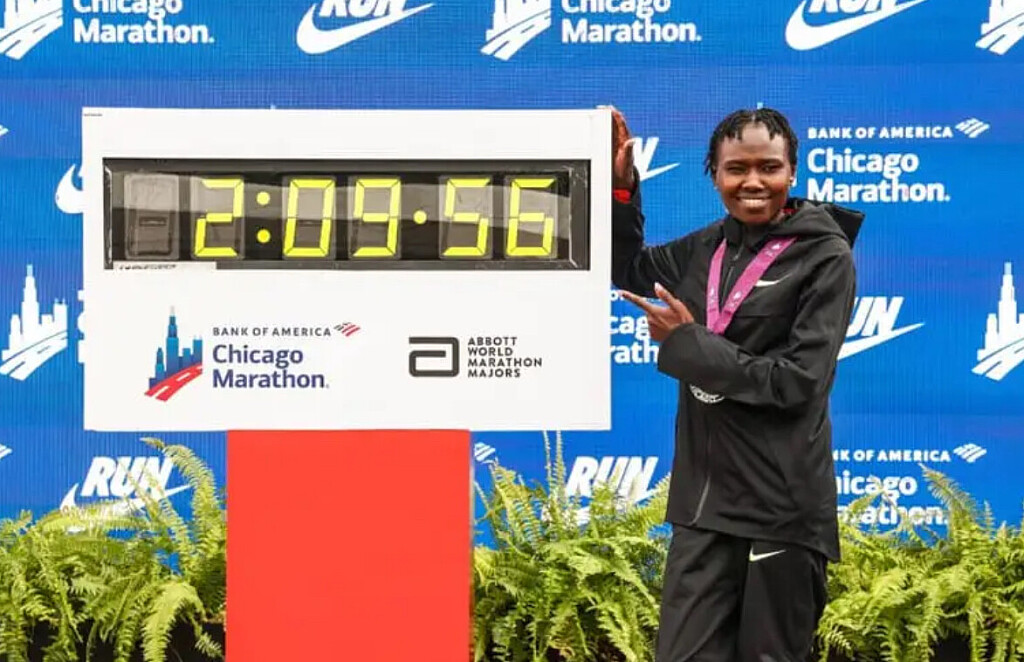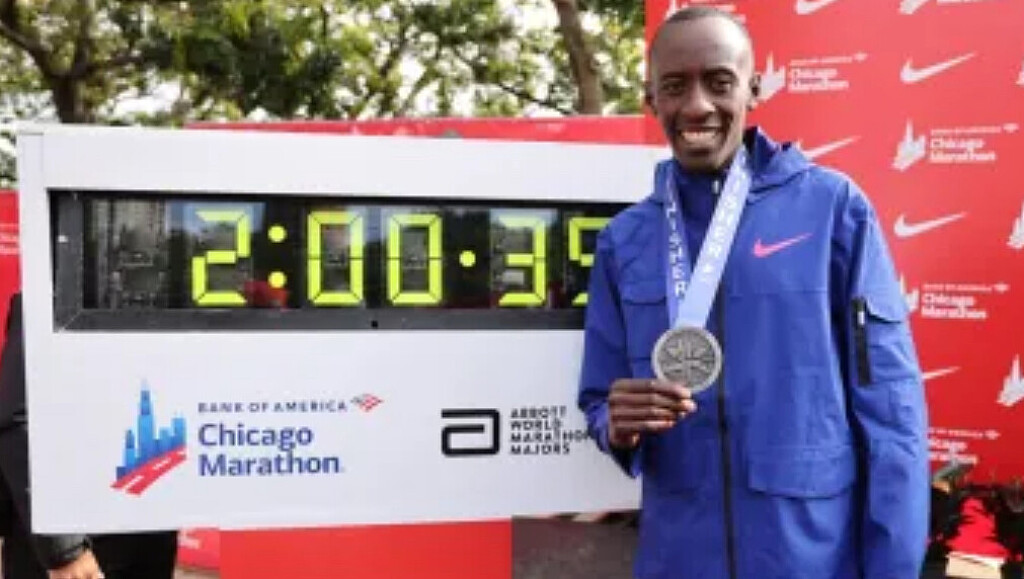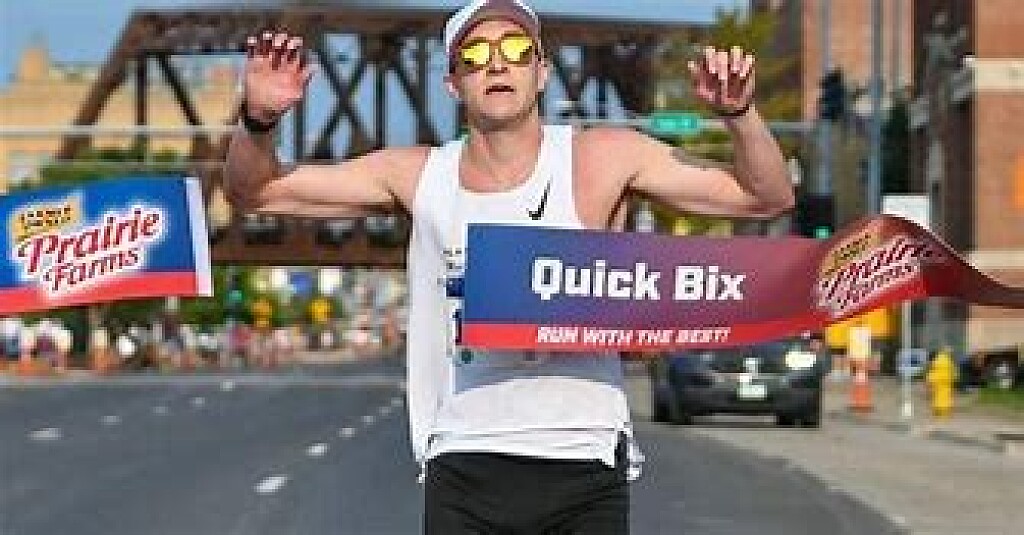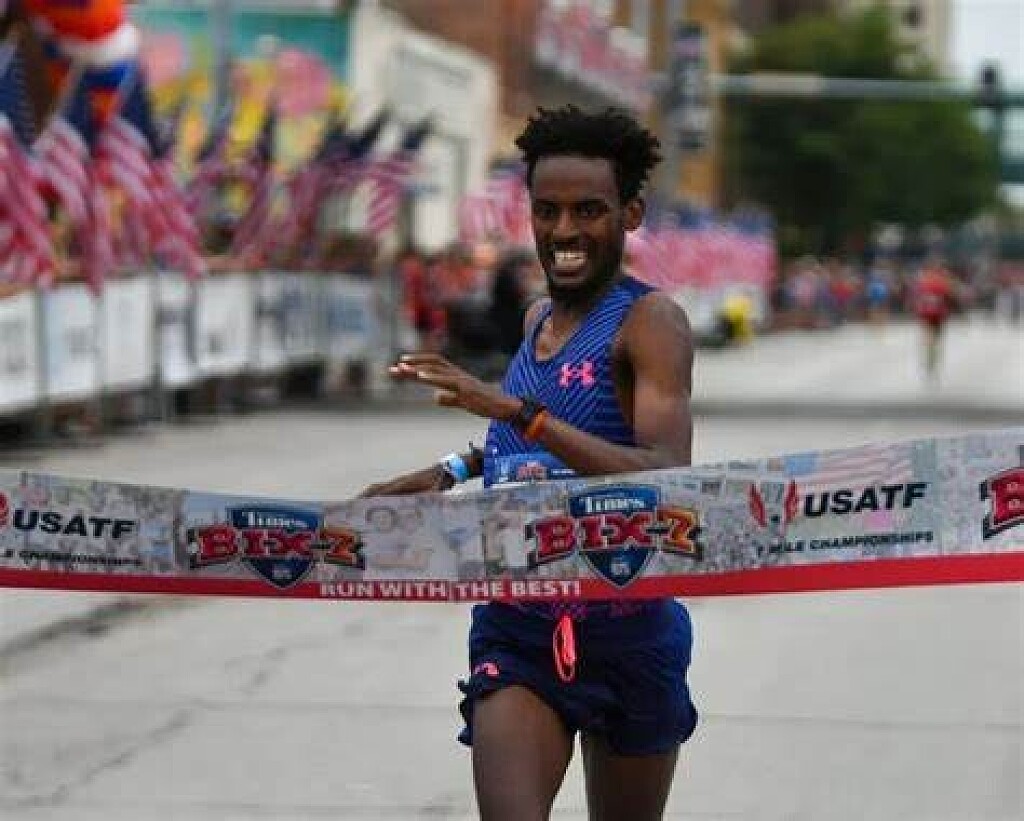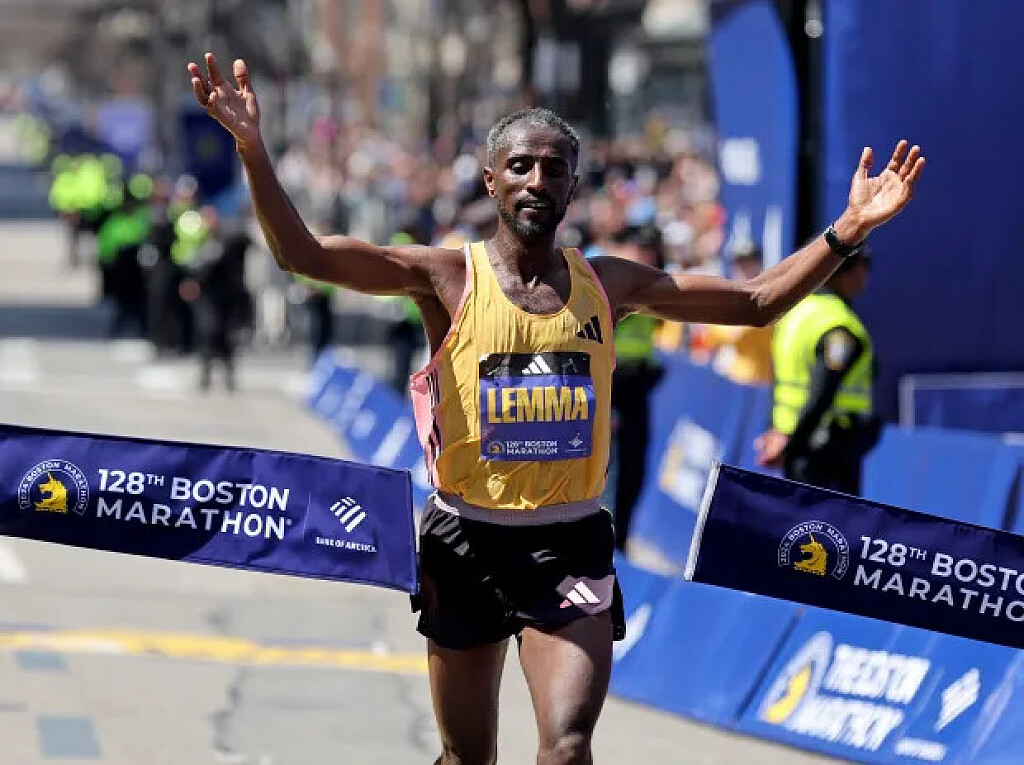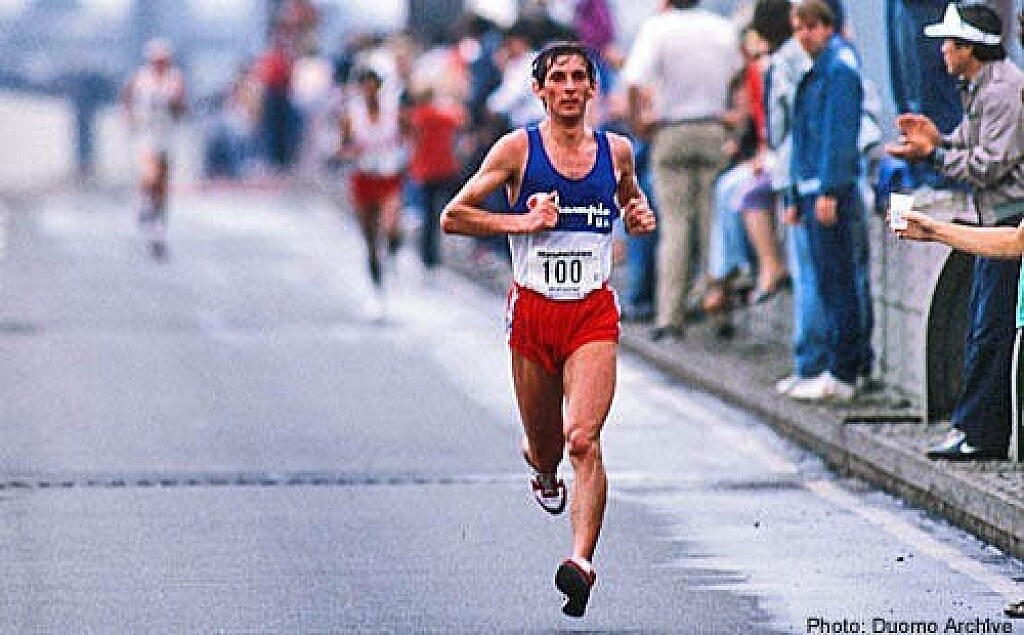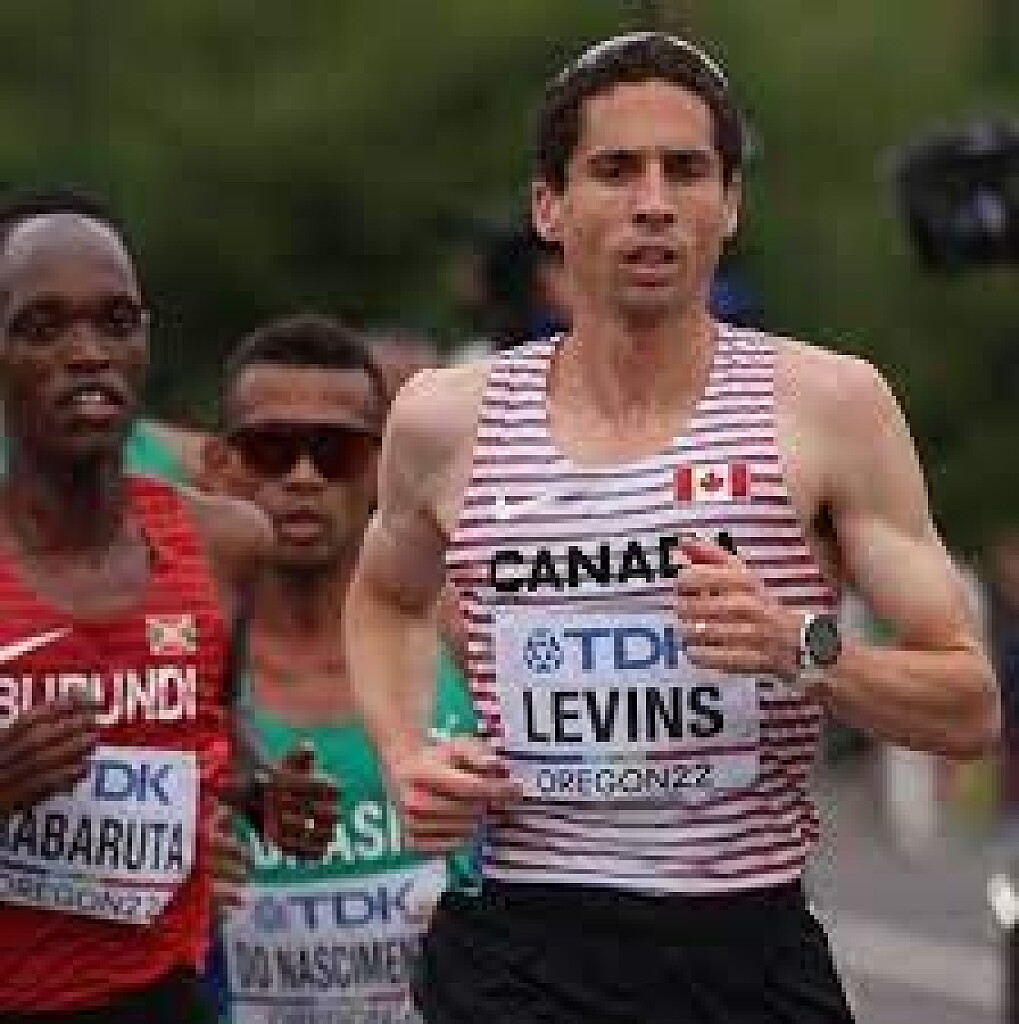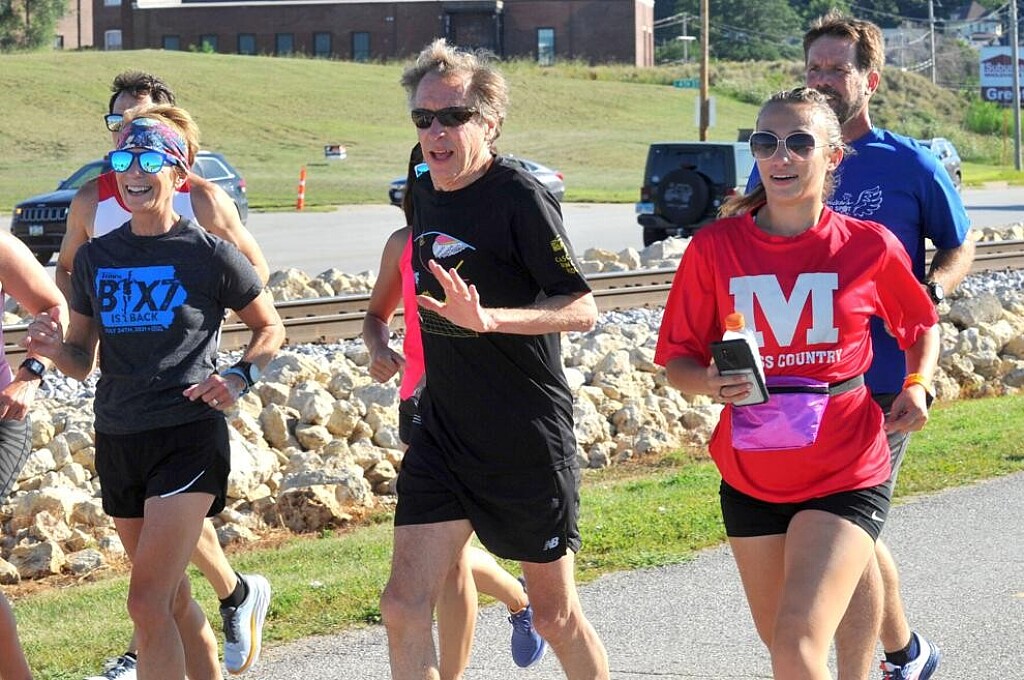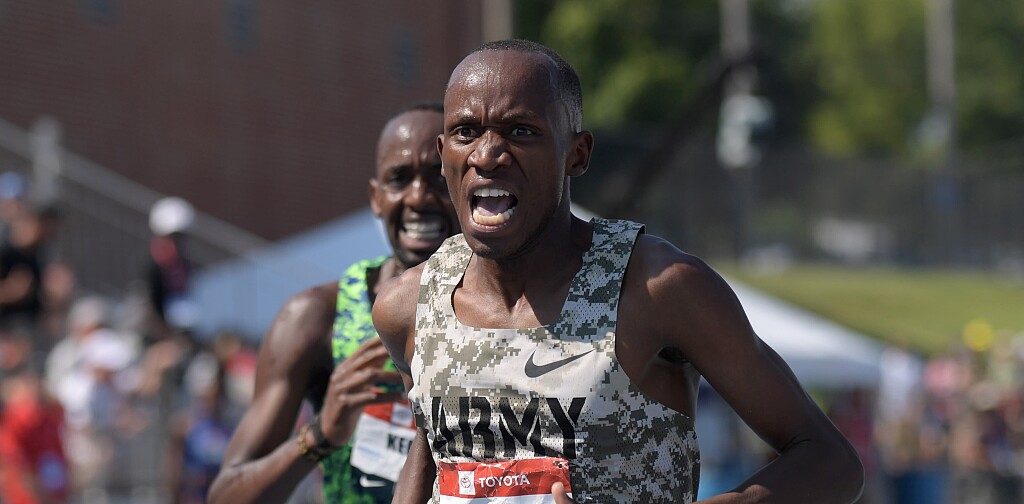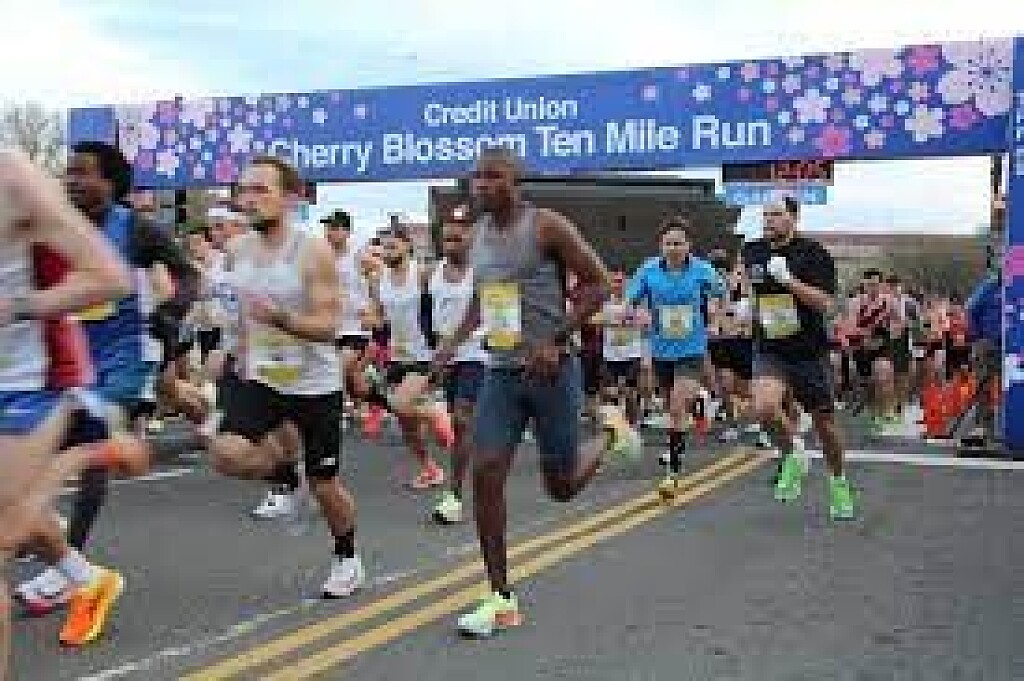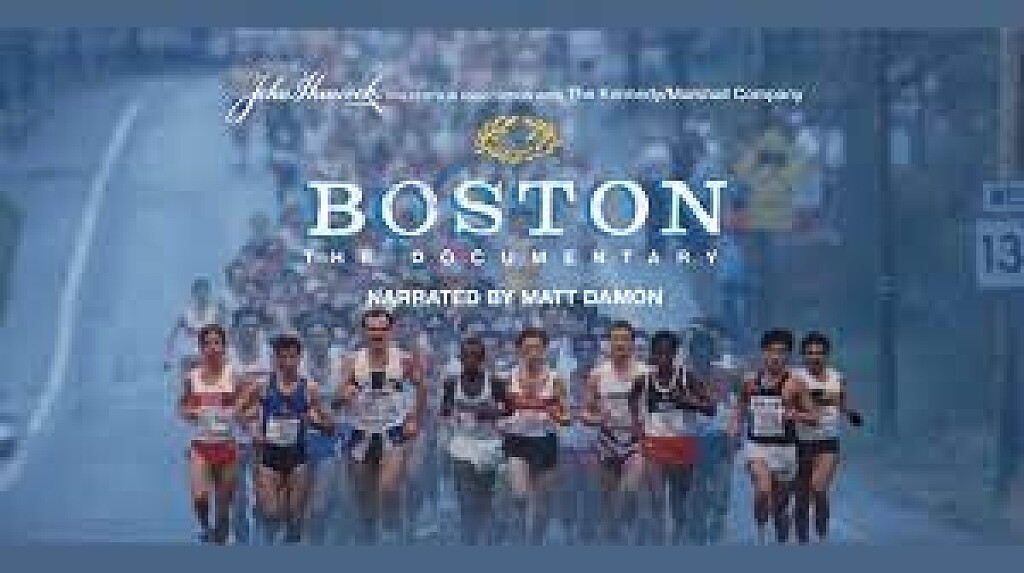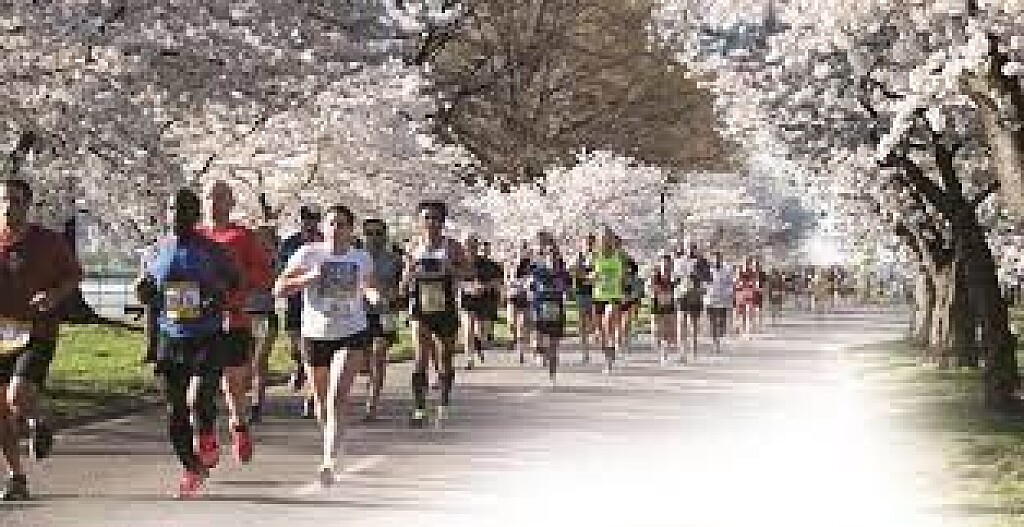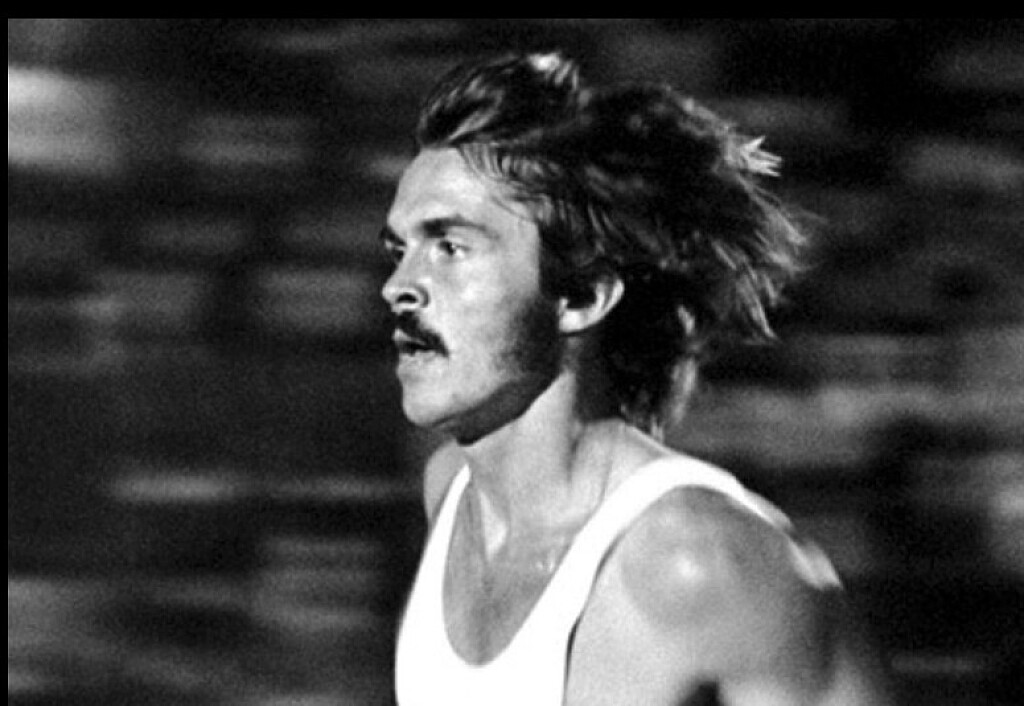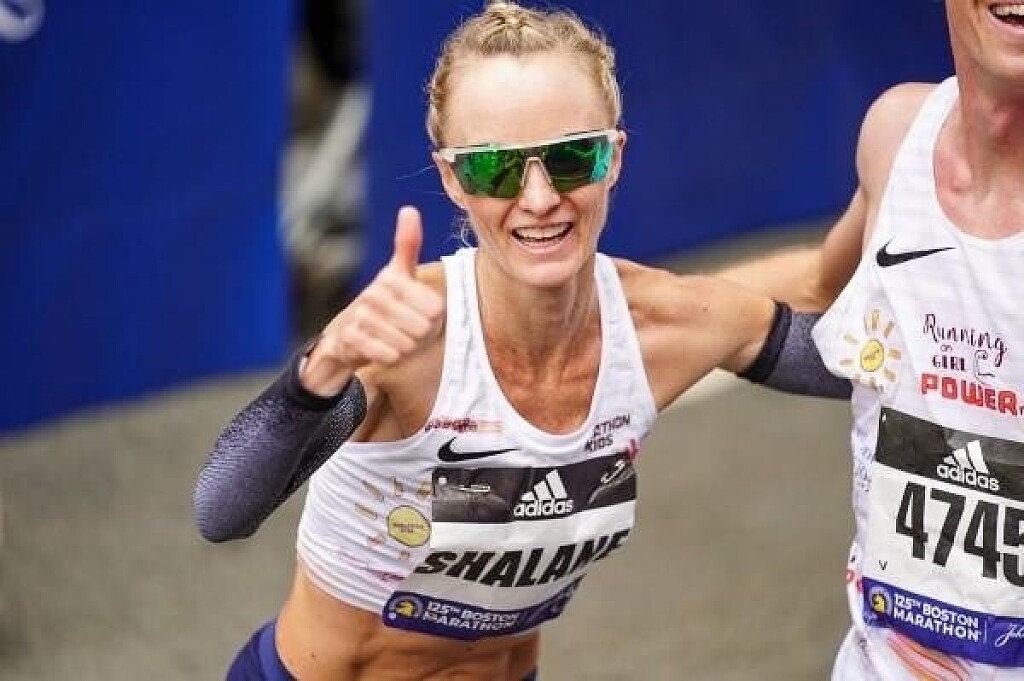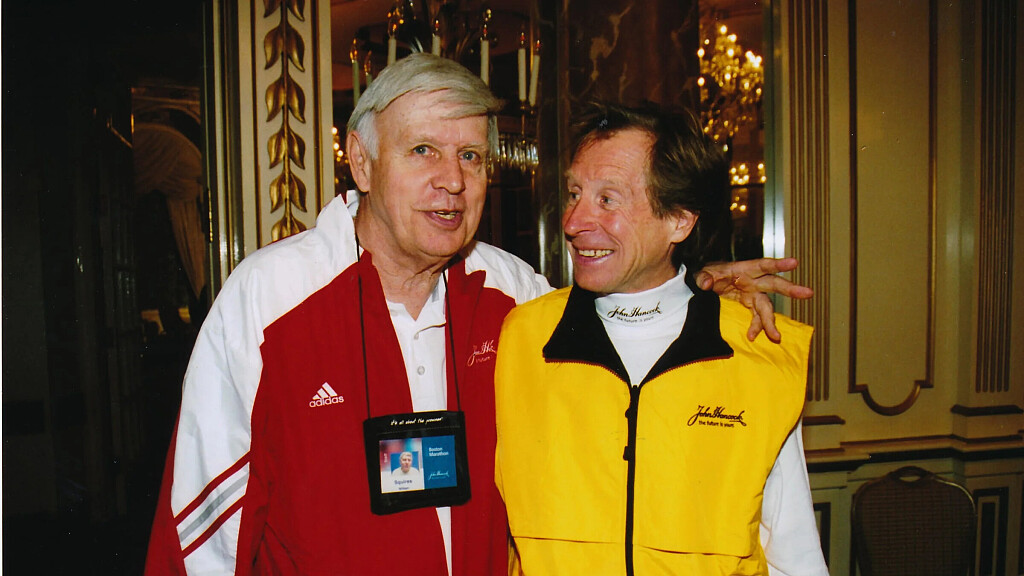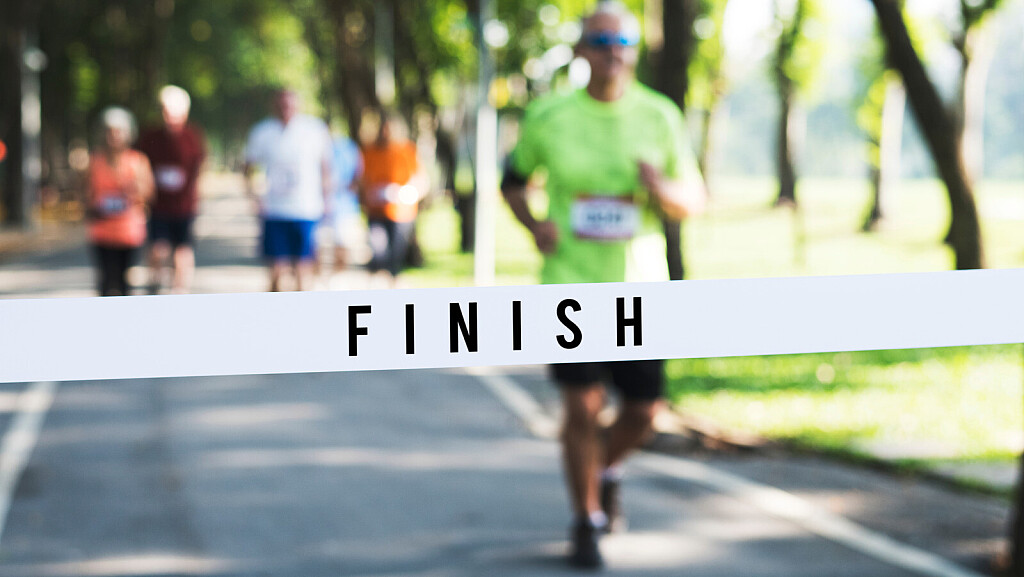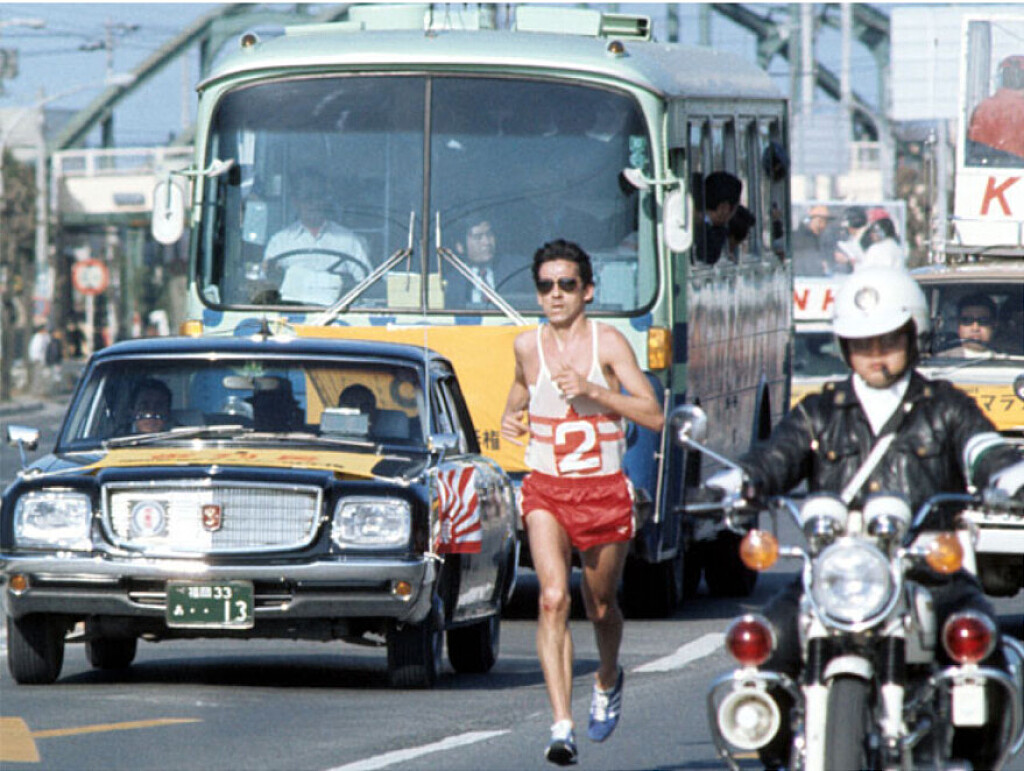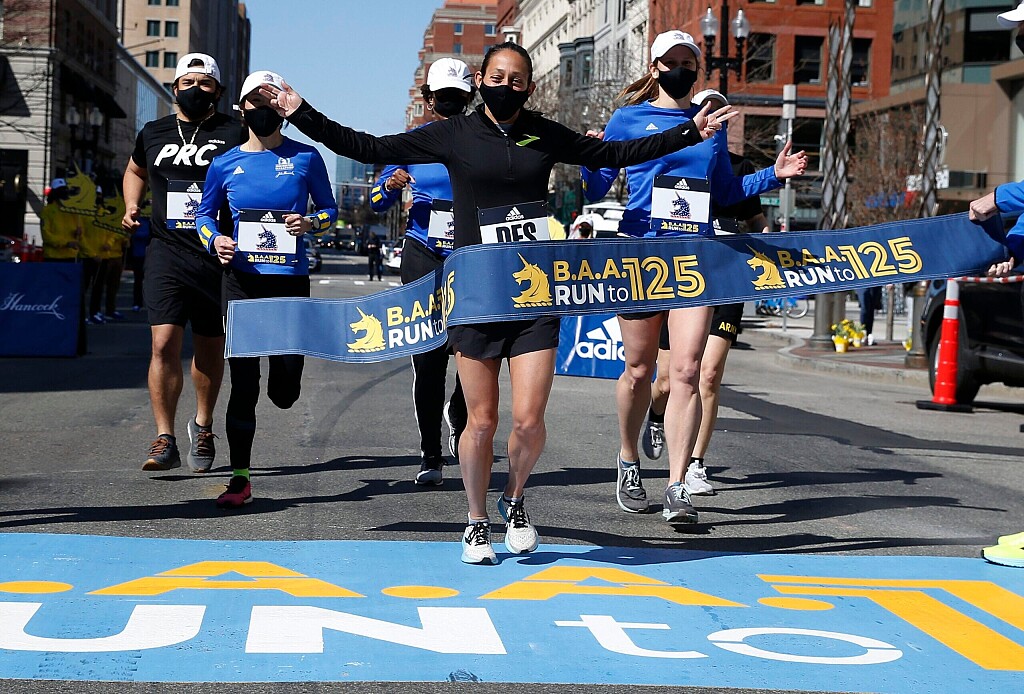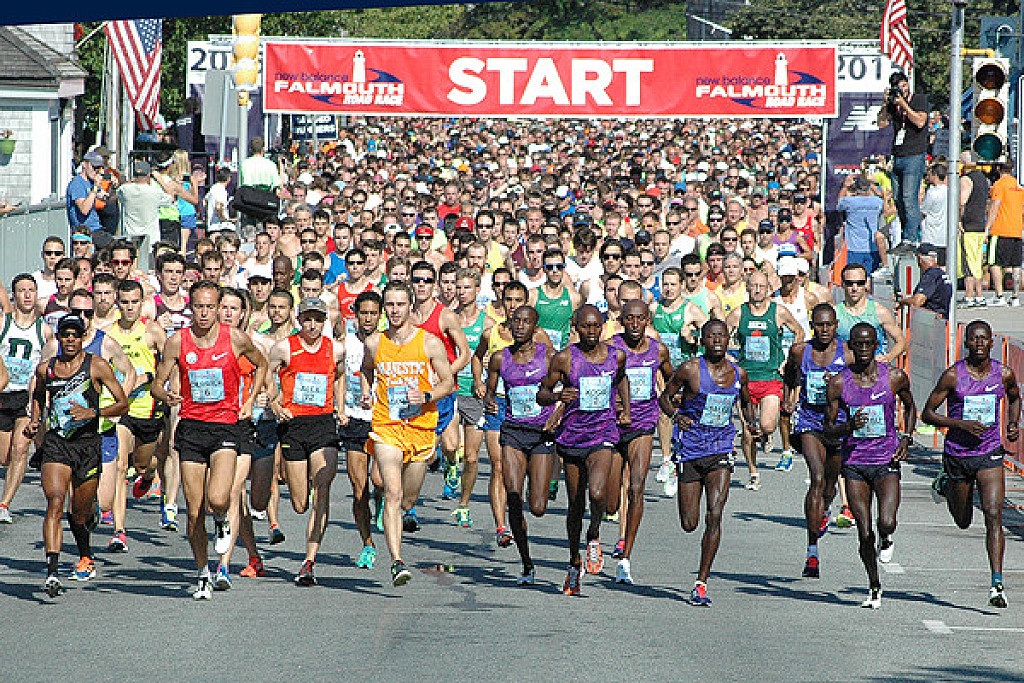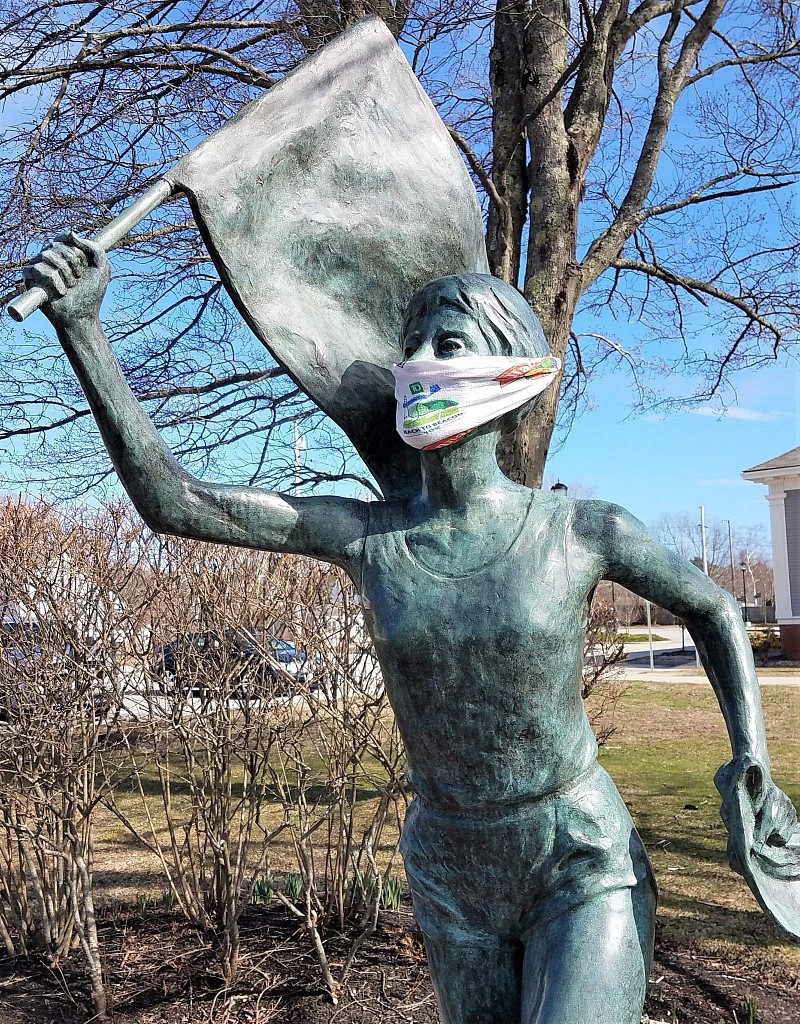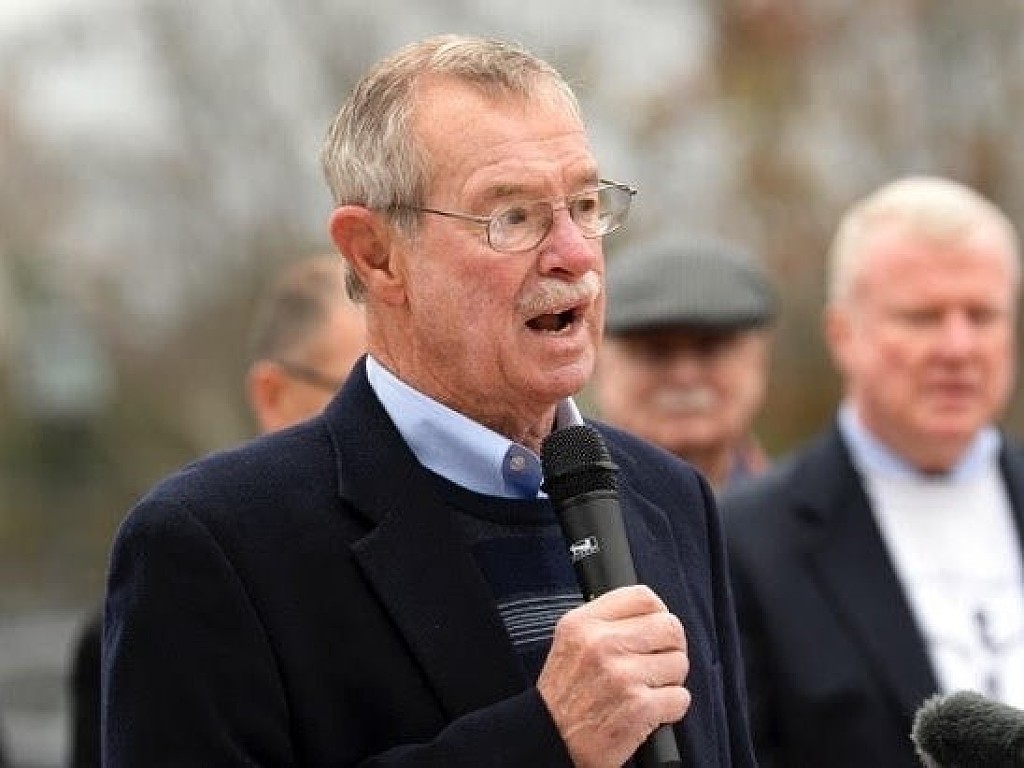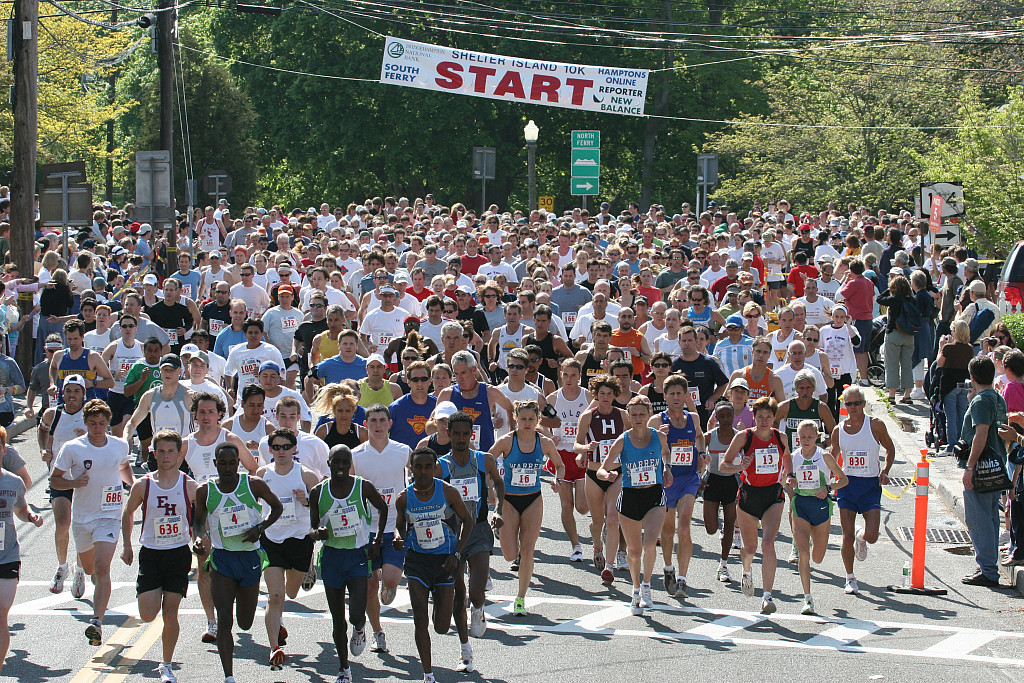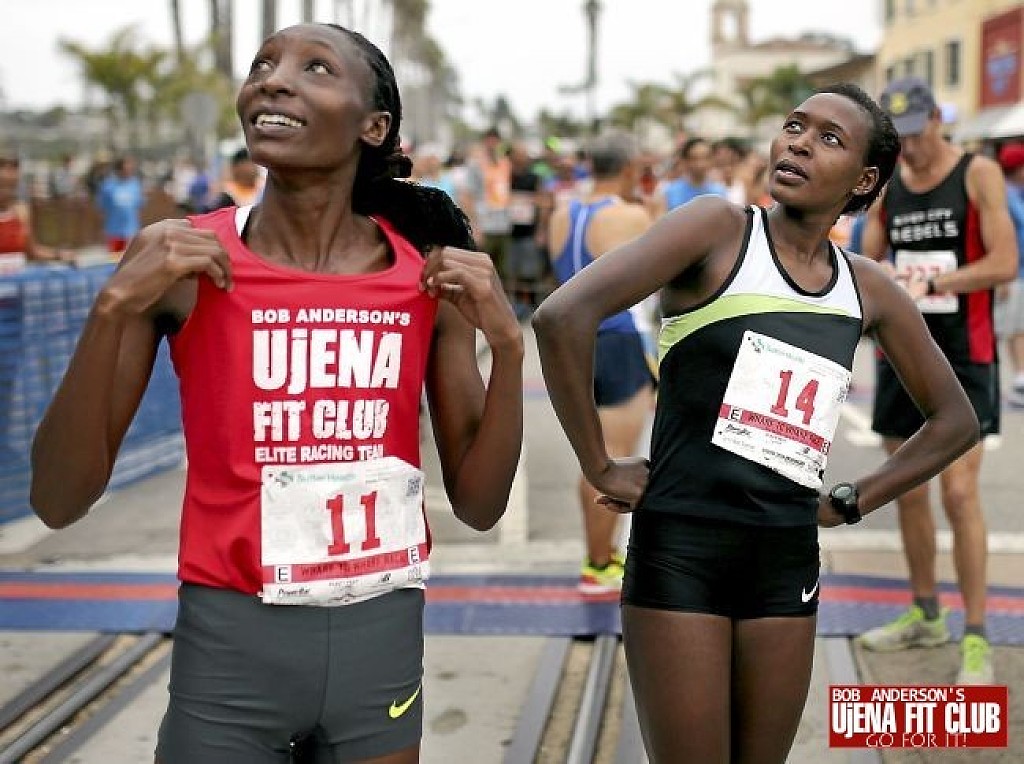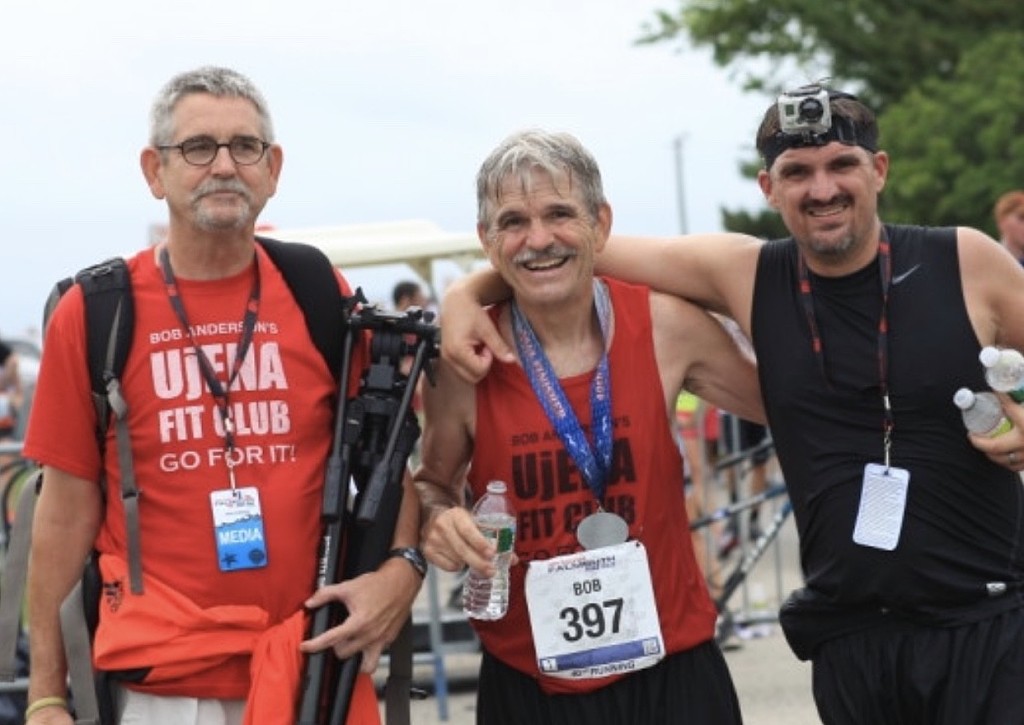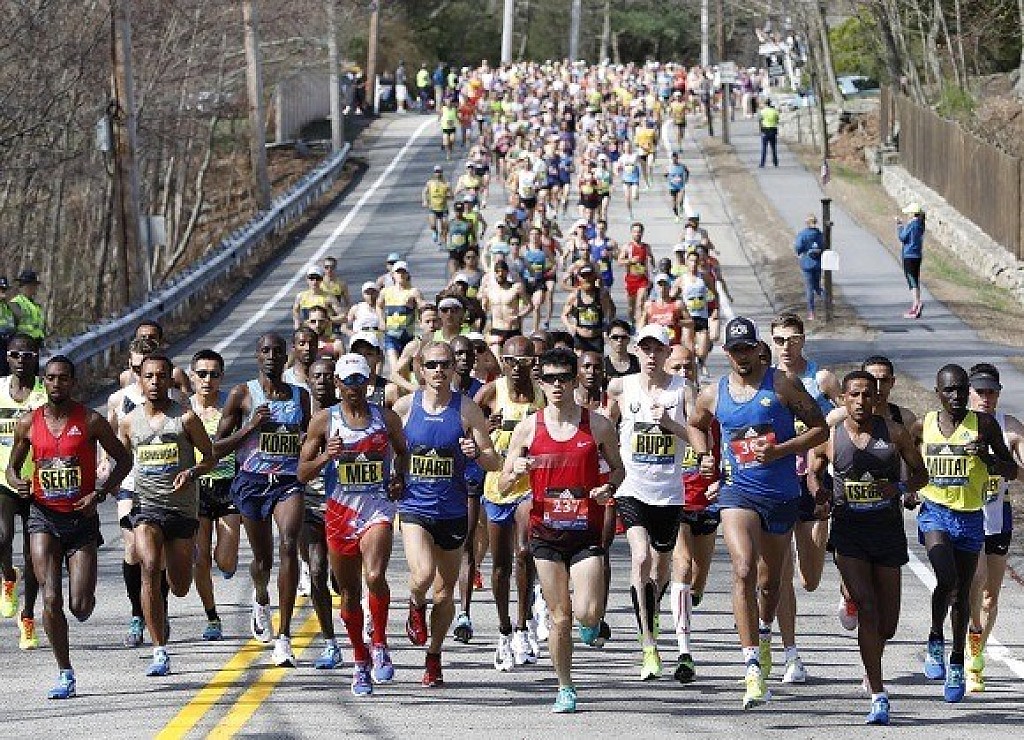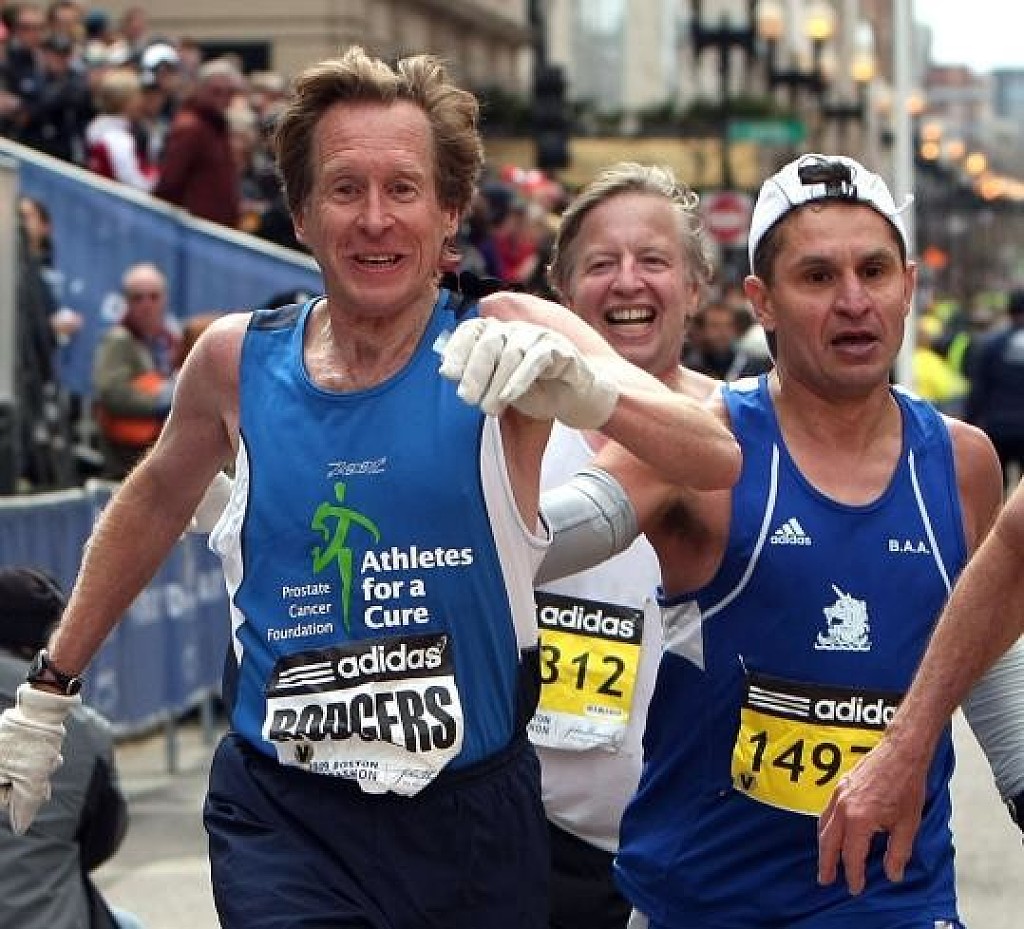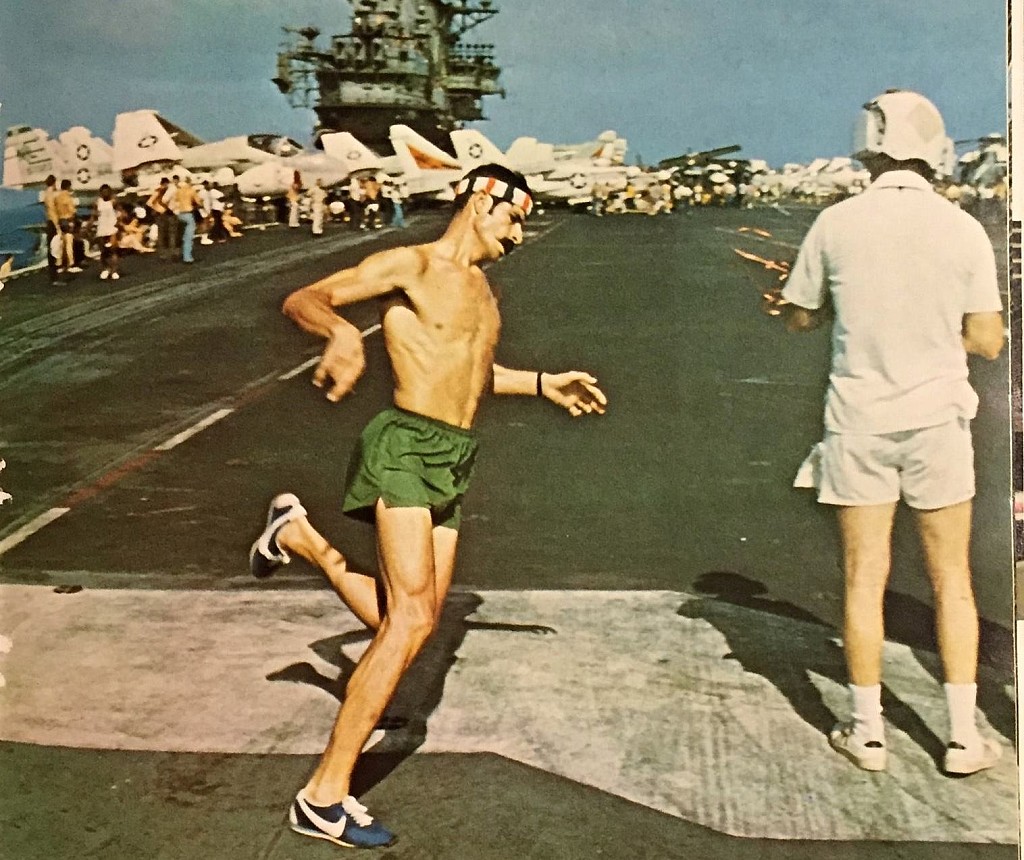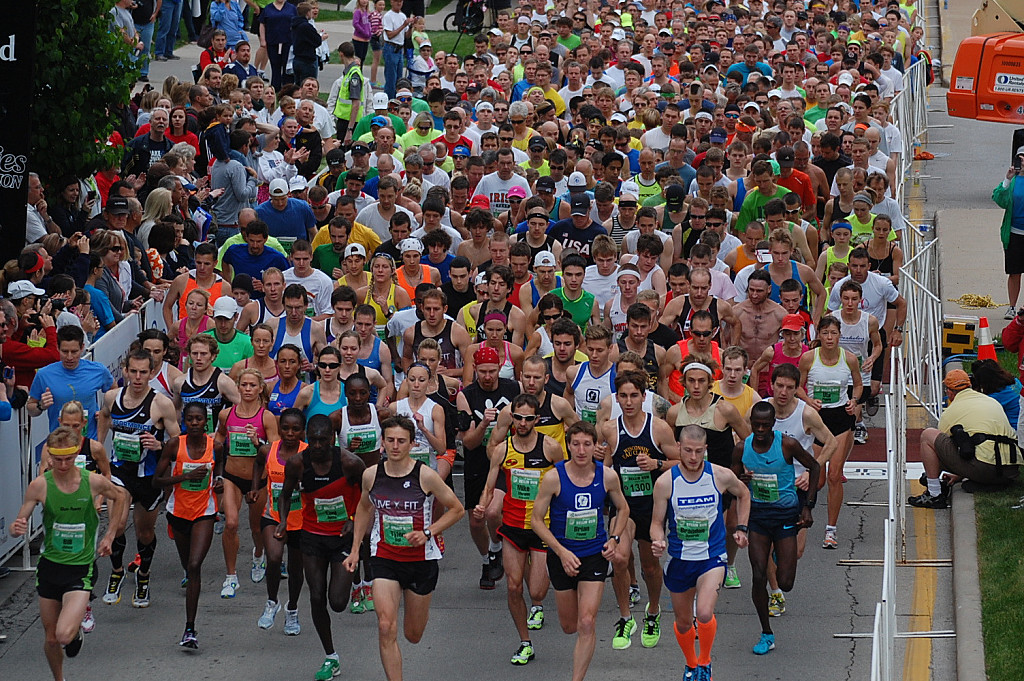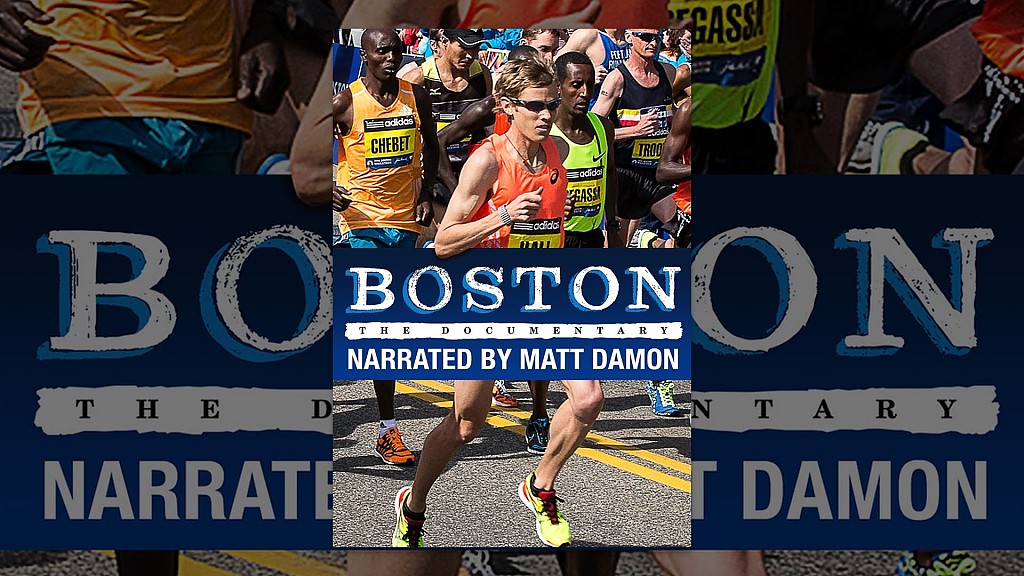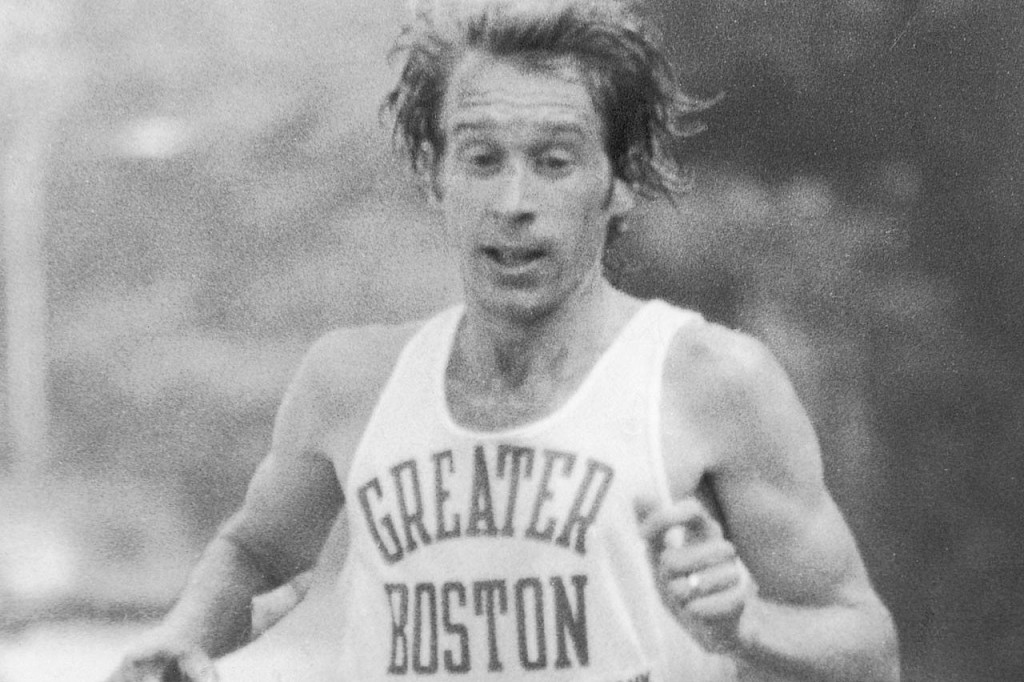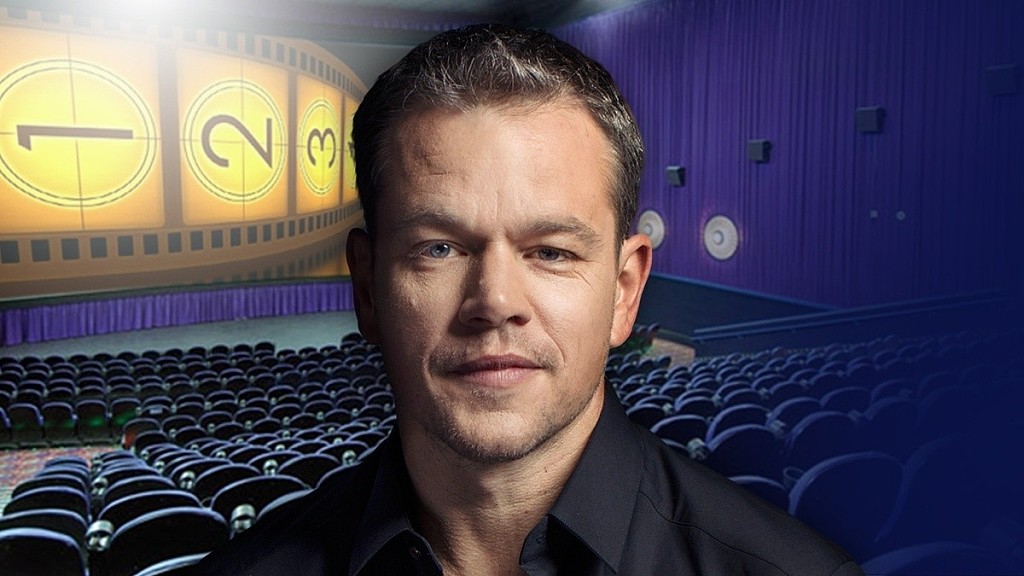Running News Daily
Running News Daily is edited by Bob Anderson. Send your news items to bob@mybestruns.com Advertising opportunities available. Train the Kenyan Way at KATA Kenya and Portugal owned and operated by Bob Anderson. Be sure to catch our movie A Long Run the movie KATA Running Camps and KATA Potato Farms - 31 now open in Kenya! https://kata.ke/
Index to Daily Posts · Sign Up For Updates · Run The World Feed
Articles tagged #Bill Rodgers
Today's Running News
Eric Giacoletto: The Curator Preserving the Soul of Track and Field
In the fast-moving world of social media, few people are doing more to preserve the rich history of athletics than Eric Giacoletto. From his home in Albertville, France, Eric has become one of the most passionate archivists of the sport—sharing rare photos, insightful commentary, and forgotten moments that continue to inspire athletes and fans across the globe.
Though not a former elite runner himself, Eric’s knowledge runs deep, and his posts serve as daily reminders of what makes our sport timeless. He documents both legends and lesser-known heroes, giving context, names, and reverence to each moment he shares. His work has captured the attention of many—including My Best Runs founder Bob Anderson.
“What Eric is doing is important,” says Bob. “He’s preserving history—moments and athletes that might otherwise be forgotten. His posts are reminders of the beauty, pain, and glory of running.”
Just this past week, Eric posted dozens of compelling images from the golden eras of track and field. From that treasure trove, Bob Anderson selected eight photos he found particularly inspiring. Each tells a story—of courage, character, and the timeless spirit of competition.
Here are the eight photos Bob selected from Eric’s posts this past week:
Photo 1
Jim Ryun and Peter Snell – A Finish for the Ages
Two legends of the mile—Jim Ryun of Wichita and New Zealand’s Peter Snell—captured in one of the most dramatic finishes in middle-distance history. Ryun’s expression of anguish and Snell’s graceful stride speak volumes about what it takes to be world-class. An image that defines grit, shared by Eric earlier this week.
Photo 2
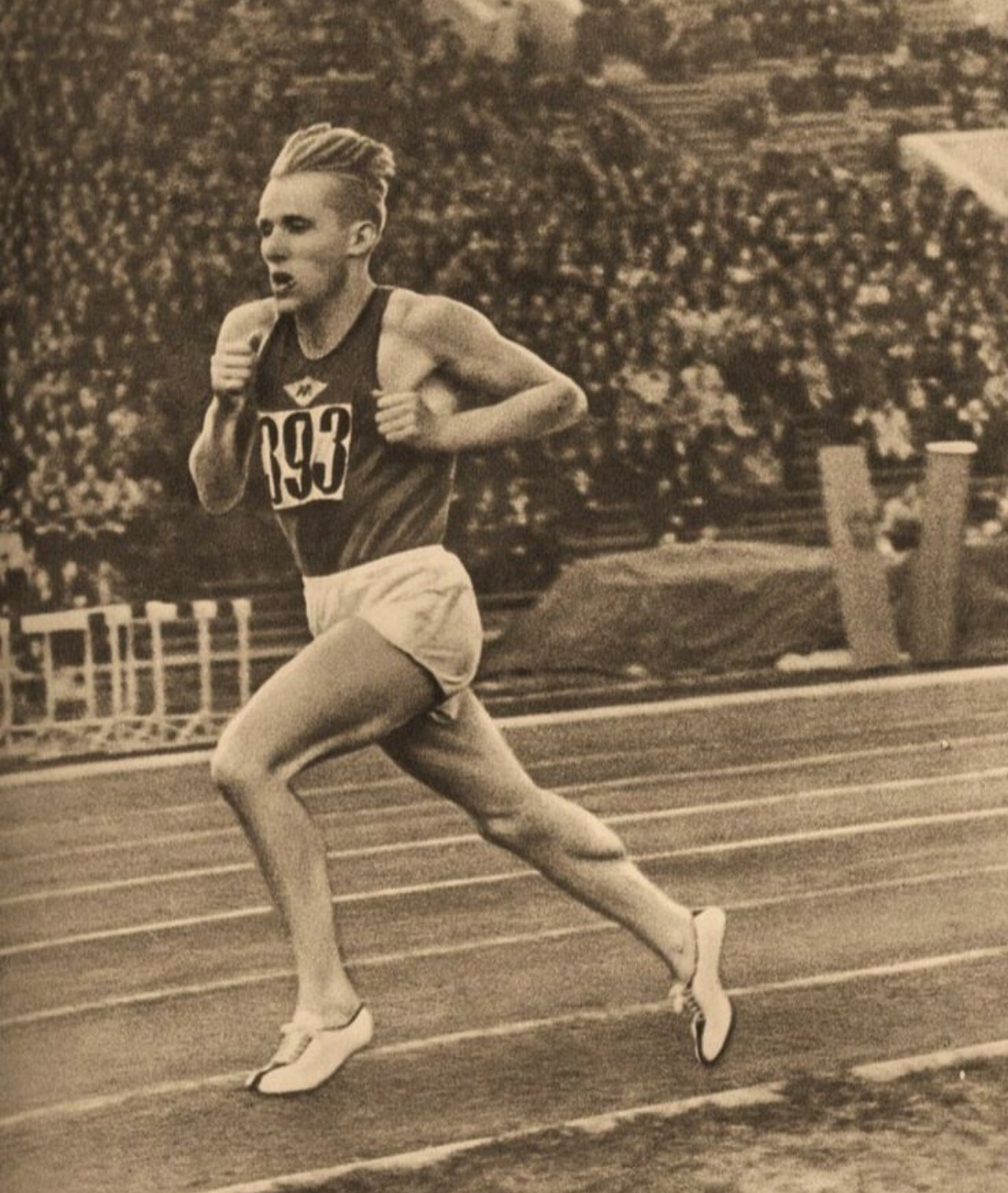
Vladimir Kuts – Soviet Powerhouse in Full Flight
Sprinting down the track with trademark aggression, Vladimir Kuts dominated the 1956 Olympics in Melbourne, winning both the 5,000m and 10,000m. Eric’s photo selection highlights Kuts’ unmistakable form and ferocity—a reminder of Eastern Bloc distance dominance during the Cold War era.
Photo 3
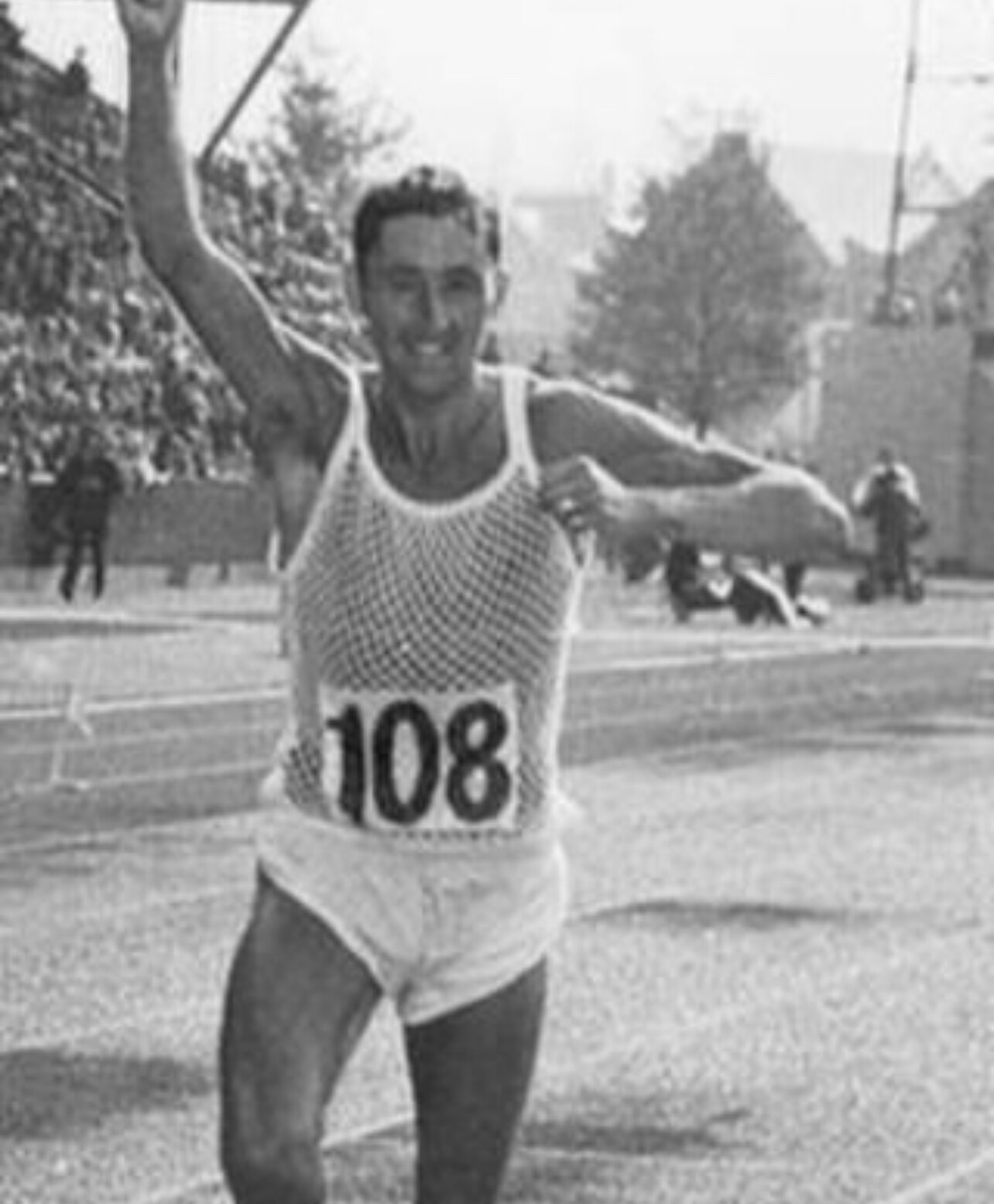
Ron Hill – 1970 Commonwealth Games, Edinburgh
Ron Hill, the pioneering English marathoner, crosses the line in his signature mesh singlet. By 2014, he had logged 159,106 lifetime miles—running at least one mile every day for 50 years. A legendary streak by a man who redefined commitment to the sport.
Photo 4
Steve Prefontaine in His Element
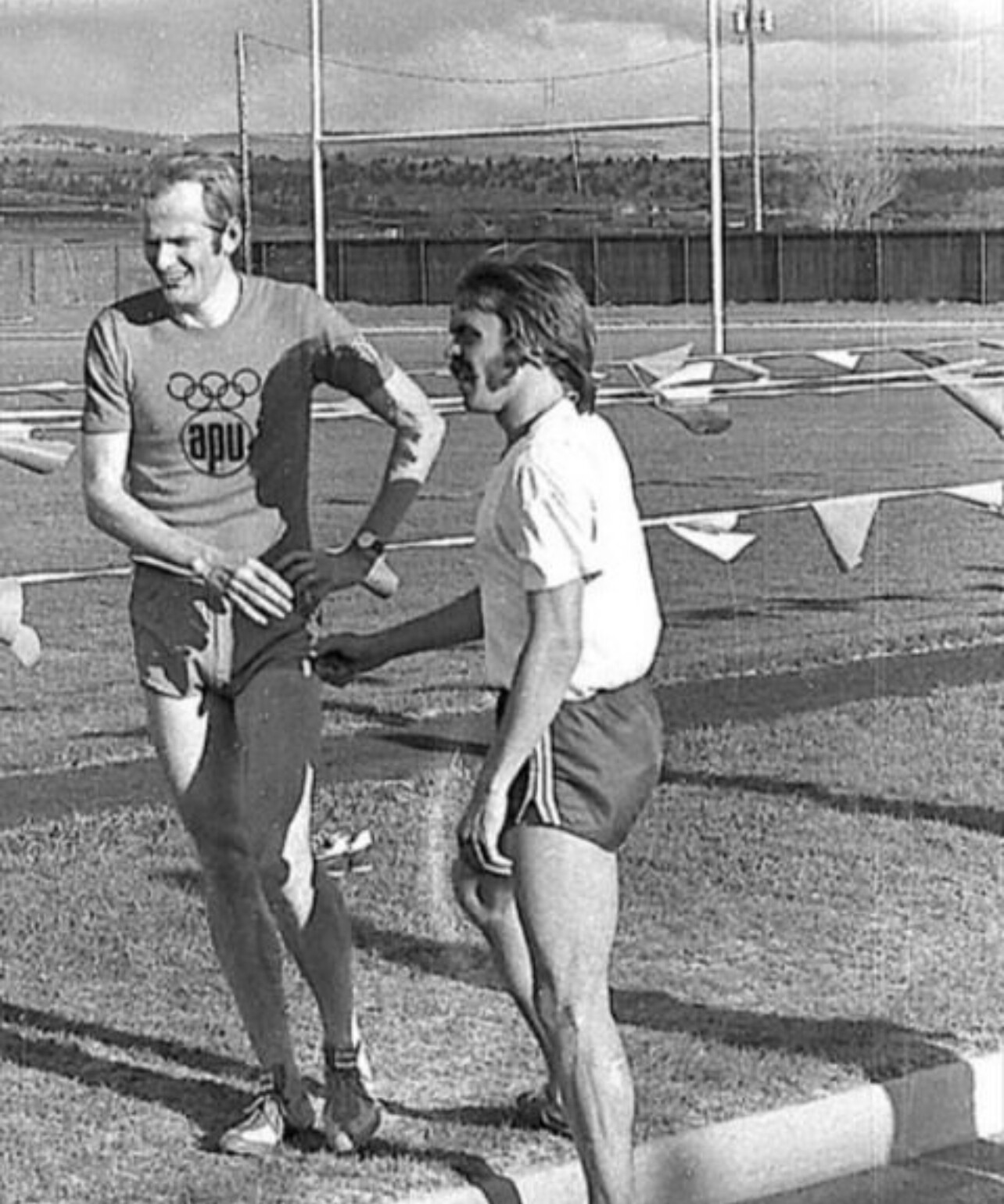
A candid photo of “Pre” during a training session, captured in conversation and camaraderie. Prefontaine’s fearless front-running style and outspoken personality made him a symbol of competitive fire. This relaxed moment shows the human side of a distance icon.
Photo 5
Herb Elliott – Training on the Dunes of Portsea
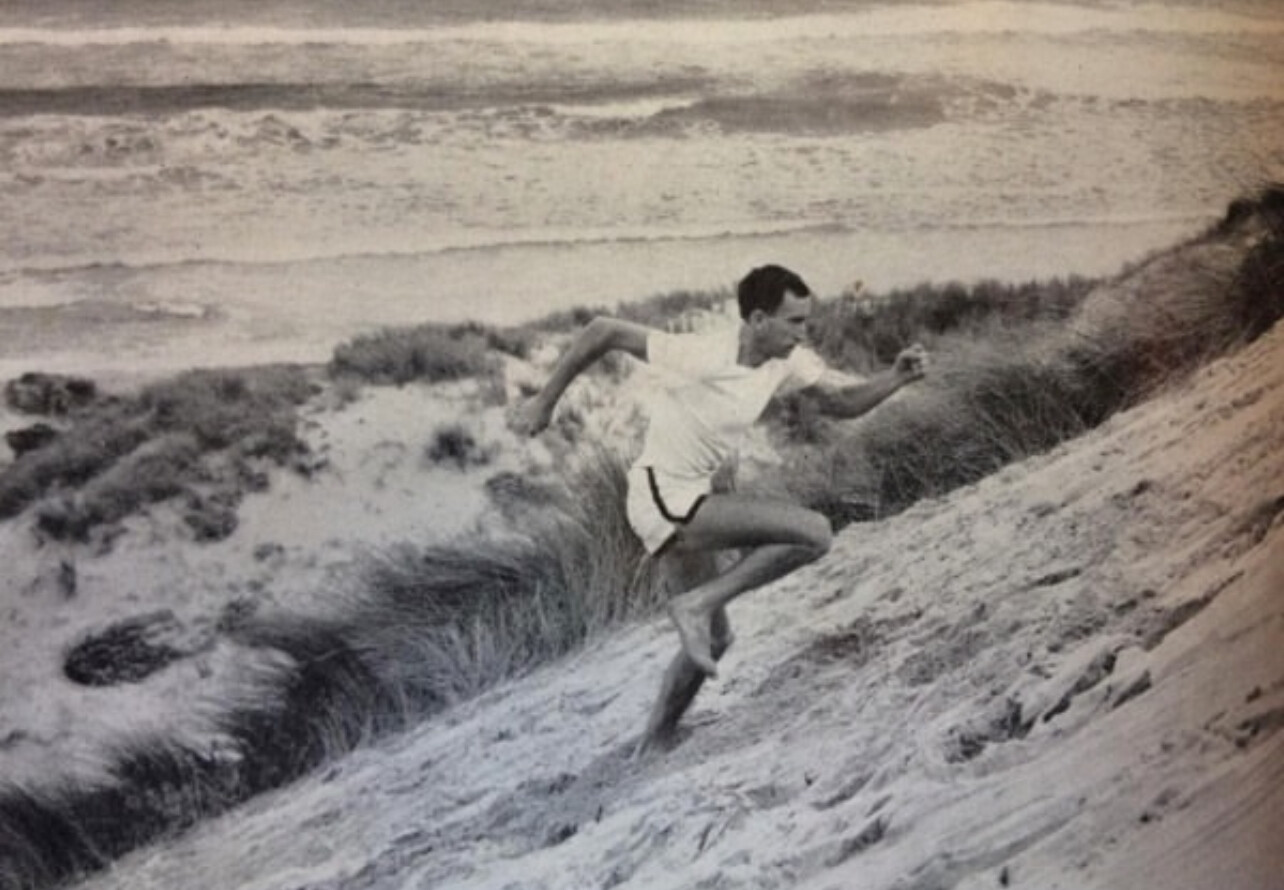
A powerful shot of Australian great Herb Elliott charging barefoot up the coastal sand dunes, guided by coach Percy Cerutty’s naturalist philosophy. Elliott never lost a 1500m or mile race in his career, and this photo shows the raw work behind that undefeated record.
Photo 6
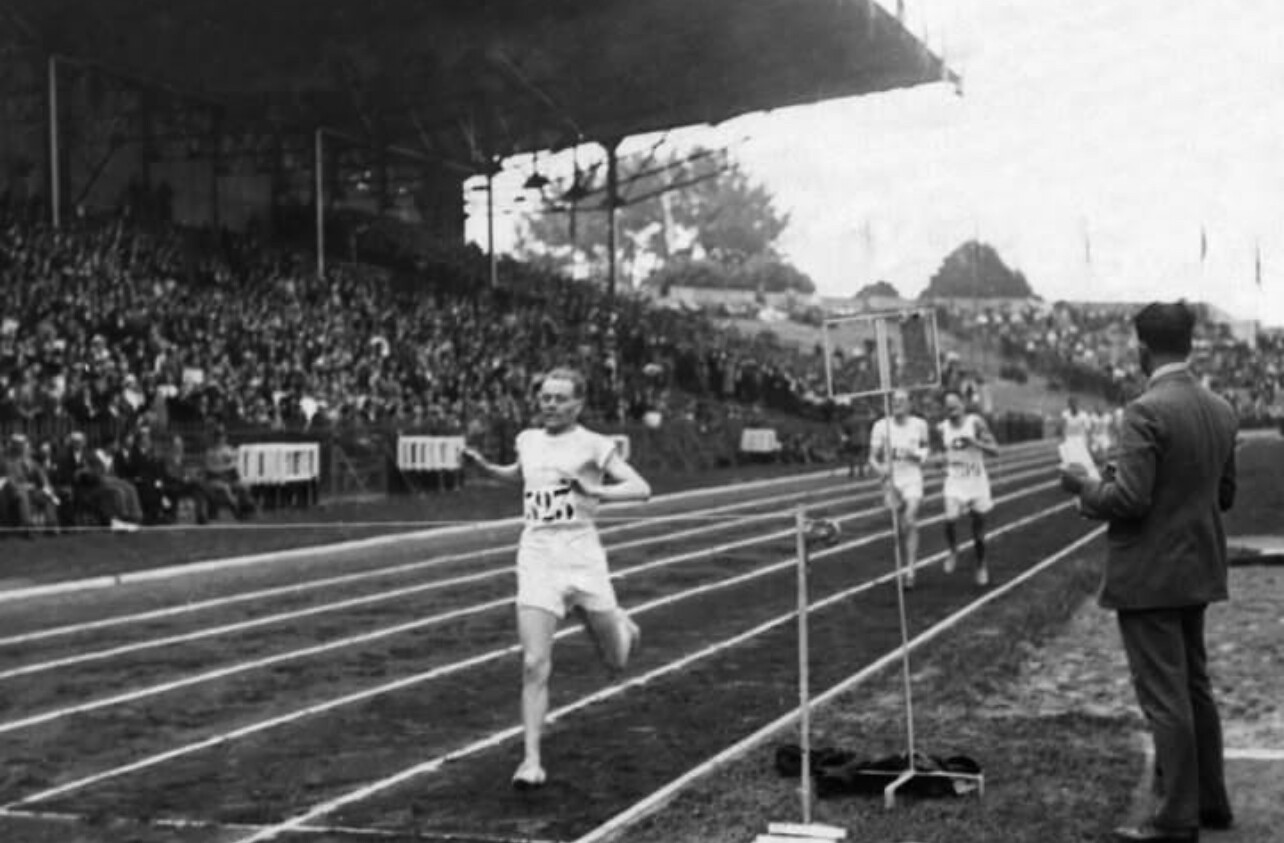
Paavo Nurmi – Double Gold in One Afternoon
Paris, July 10, 1924: Paavo Nurmi wins the 1500m, then returns just hours later to take gold again in the 5000m. This photo shows him well ahead of the field, delivering one of the most jaw-dropping performances in Olympic distance running history.
Photo 7
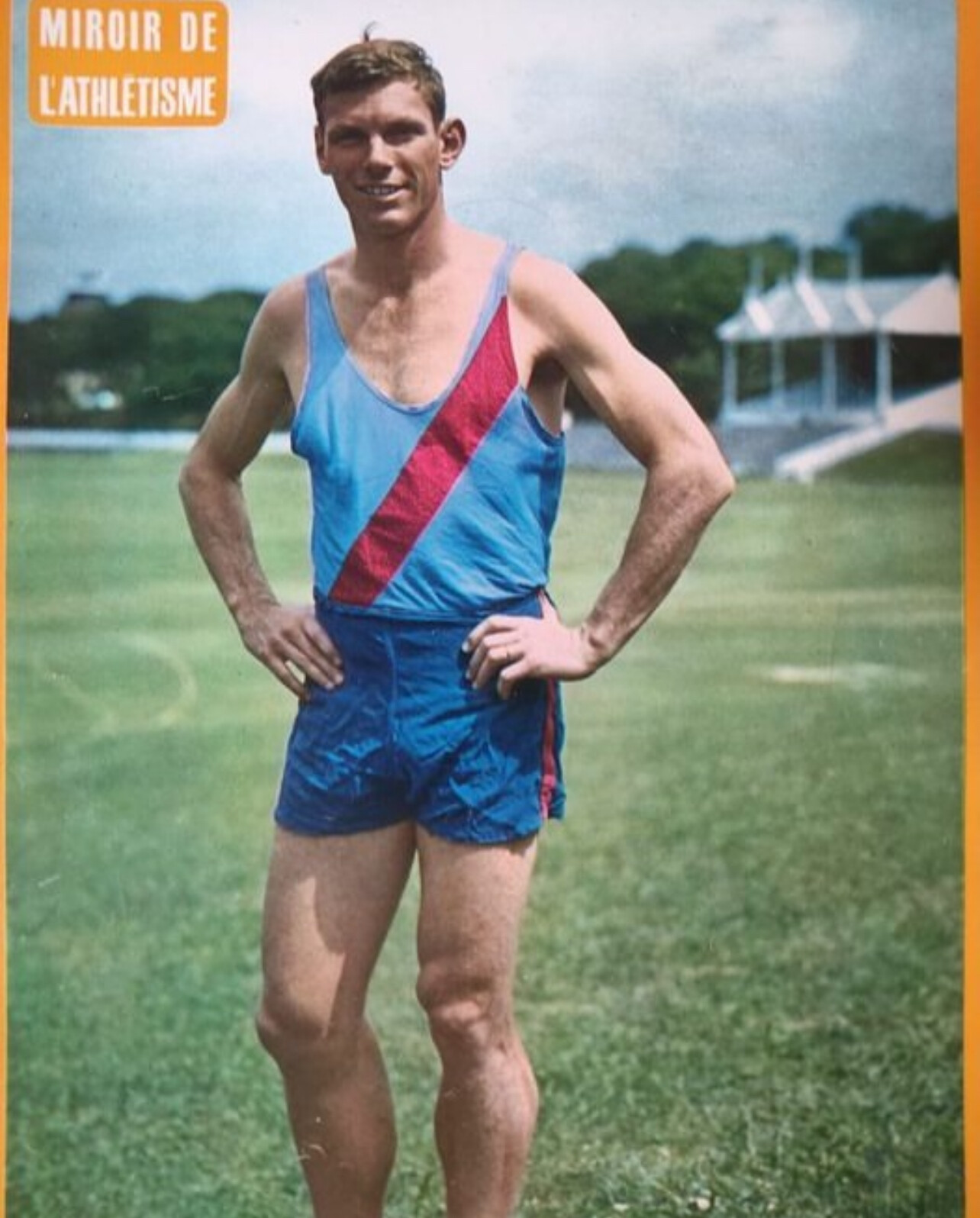
Peter Snell – Power and Poise in Color
A rare color image of New Zealand’s Peter Snell, one of the greatest middle-distance runners of all time. Winner of three Olympic gold medals, Snell combined strength with speed in a way few ever have. Eric’s post brings his iconic stature to life in full color.
Photo 8
Bill Rodgers – Boston Breakaway, 1975
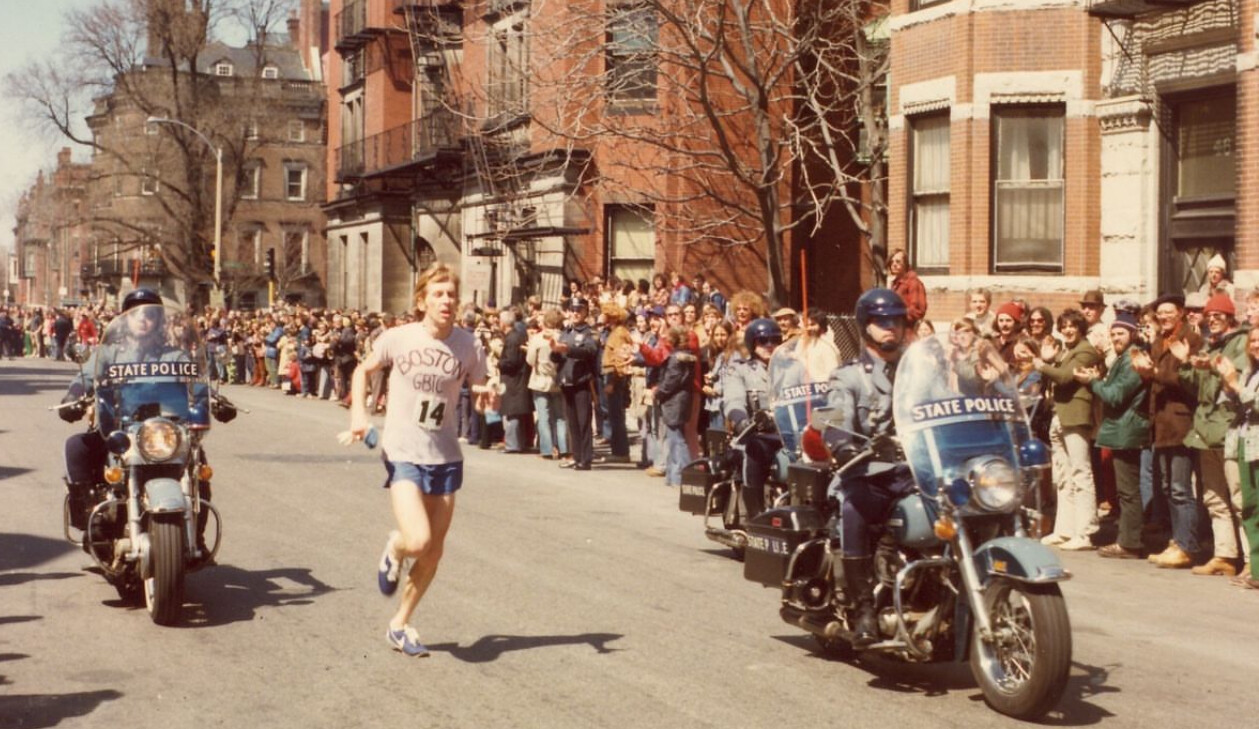
Captured mid-stride during his victory at the 1975 Boston Marathon, Bill Rodgers pulls away under the escort of state police motorcycles. His win that year—2:09:55—was part of a dominant streak that made him a U.S. marathon legend. A city, and a sport, in full celebration.
Honoring the Archivist
Eric’s posts on Facebook and Instagram (@ericgiacoletto) continue to spark meaningful conversations among athletes, historians, and lifelong fans. Whether he’s unearthing a forgotten race photo or celebrating an athlete’s legacy, Eric is doing more than documenting—he’s inspiring.
If you enjoyed this feature, and with Eric’s permission, we’d love to post more regularly here at My Best Runs. Let us know what you think—we’re always looking to spotlight the people and moments that keep the spirit of our sport alive.
by Boris Baron and Bob Anderson
Login to leave a comment
A Long Run – The Running Documentary That’s Inspiring Runners Everywhere
Some films tell a story. Others ignite a movement. A Long Run does both.
But don’t just take our word for it—here’s what real runners who watched the film had to say:
@no1fibersplicer525"I love this! I’m 49 and I started ‘Couch to 5K’ three weeks ago. I signed up for my first 5K last night. I’m super excited...I’m tired after each run, but even as I run further, it’s the same ‘tired’—I’m adapting! I’m becoming that guy I see on TV. I will run this 5K and I will start calling myself a runner! Thanks for the encouragement!"
@AdventuresomeOutlook"I love hearing stories of people picking up running. Running saved me from a deep depression after getting diagnosed with multiple medical conditions. I picked up running (something I never desired doing), and it’s helped me gain so much confidence and pride in myself..."
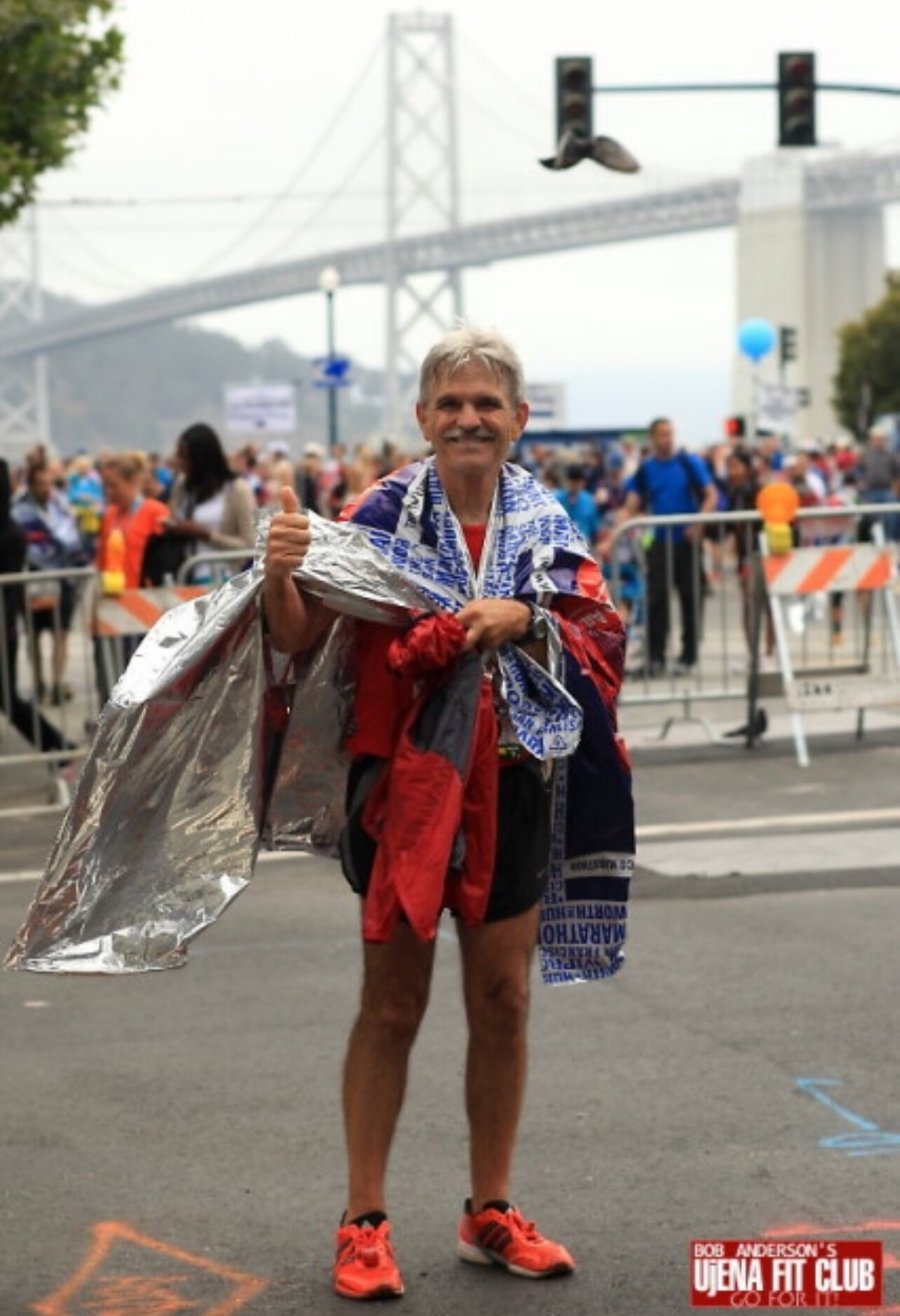
@deldridg"So many life lessons here. Thank you for such a wonderful documentary and for all the inspiration. Tomorrow after dropping the kids off at school, this Sydney dad will be heading out to a gorgeous trail to enjoy running through 10km of views over the Hawkesbury River, endless bird song, and the company of the occasional goanna. On Sunday, the whole family will do it again. I can’t wait!! Cheers and thank you!"
The Man Behind the Journey
The old guy still has it. A runner will always be a runner.
That “old guy” is Bob Anderson, the man who founded Runner’s World magazine at age 17 with just $100 and a typewriter. He built the magazine into a global running institution before selling it to Rodale Press in 1984. But his love for running never faded.
50 years after his first run, Bob took on a bold challenge: run 50 races in one year covering 350 miles at an average pace under 7 minutes per mile—all at the age of 64.
That’s equivalent to a 5:30 pace for a 30-year-old male or a 6:00 pace for a 30-year-old female—elite-level speed at any age.
Could he do it? How would he handle injuries, fatigue, and the mental grind?
A Film Narrated by an Icon
What makes A Long Run even more special is that it’s narrated by actor Sean Astin, best known for his roles in Rudy, The Goonies, and The Lord of the Rings trilogy.
Bob met Sean at one of the races he was staging, and the two immediately bonded over their shared passion for running. Sean, an avid marathoner himself, was the perfect voice to bring Bob’s incredible journey to life, adding emotional depth and energy that captures the heart of the film.
More Than a Personal Challenge—A Tribute to Running
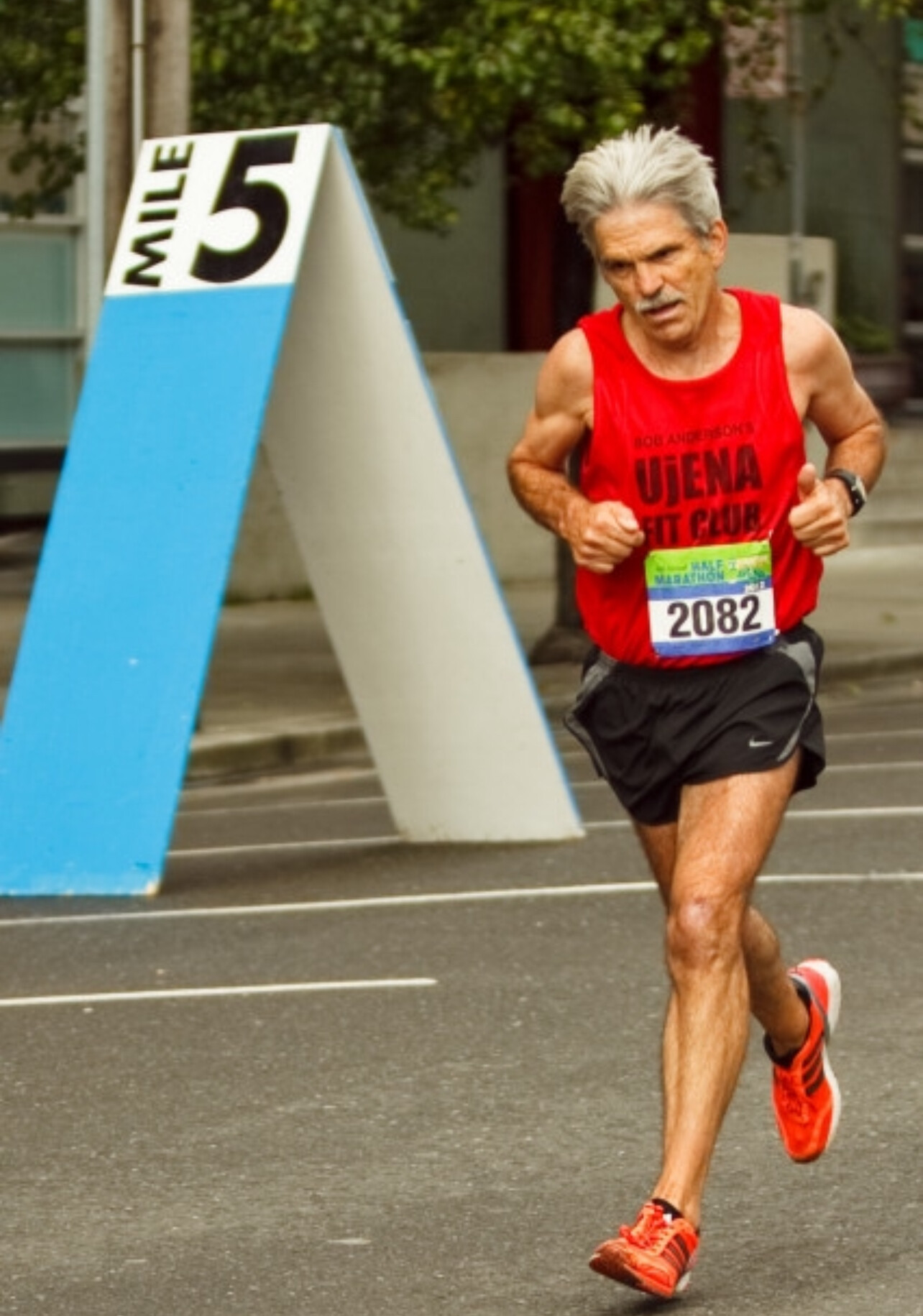
The film isn’t just about Bob. It’s about the sport itself.
The history – A Long Run takes you back to the early days of the running boom, featuring icons like Bill Rodgers, Billy Mills, Paula Radcliffe, Dean Karnazes, and George Hirsch.
Some of the races – Experience the thrill of running through:
Avenue of the Giants – Towering redwoods in California create a breathtaking race backdrop.
San Francisco’s hills – A stunning yet brutal testing ground for runners.
Coastal Fort Bragg – Where the ocean’s rhythm meets the rhythm of the runner.
Run the Parkway Half Marathon (Kansas) – The race near Overland Park, Kansas, where Bob founded Distance Running News, the publication that later became Runner’s World.
Falmouth Road Race (Massachusetts) – One of the most scenic and historic road races on the East Coast.
Kauai Half Marathon (Hawaii) – A September race offering breathtaking ocean and mountain views in paradise.
@angellosmalefakis1321"This was a wonderful film, Bob! Wonderful in so many ways! Good to see that you presented so many icons of the sport of running. I was with Runner’s World when it was young. There in NYC when the marathon was at its infancy. We still miss Fred. Miss Greta. Wonderful film in so many ways! I love it! I am 65 and still running—now winning masters races!"
Why You Should Watch A Long Run
If you’ve ever laced up your shoes for a jog, if you’ve ever wondered how far you could go, or if you just need a spark to get moving again, this film is for you.
With over 342,000 views, A Long Run has inspired runners around the world. The best part? It’s completely free to watch!
@mpgrewal00"Bob loves running. Bob lives running. Good work, Bob."
@shamelesssheamis545"I’m 35 and started 5 months ago. One day I just got up and ran a mile. It was slooow. But that was it for me. I’m up to running 12 miles now and I cannot wait to see where this goes! Happy running, everyone!"
@barefootbeachrunner9498"Awesome. Inspiring film. Thanks for reminding me why I run!"
Where to Watch
Watch the full film for free on YouTube: A Long Run.
Or visit alongrun.com for more information.
We hope you’ll watch it and let us know what you think. Leave a comment, share your thoughts, and help us reach 500,000 views!
This is your chance to see what happens when passion meets determination. To feel the runner’s high without breaking a sweat. To be inspired by the sport we all love.
Because, as Bob Anderson has proven, a long run never really ends.
by Boris Baron
Login to leave a comment
MARATHON GROUNDBREAKERS
Since Australia’s Derek Clayton ran history’s first sub—2:10 marathon in Fukuoka, Japan, on 3 December 1967, there have been a total of 4538 sub—2:10 marathons (as of 30 October 2024), 4537 by men, one by a woman.
As with any new ground-breaking performance, Ruth Chepngetich’s 2:09:56 in Chicago on 13 October has forced us to reassess all our past assumptions, or, like many, to doubt the validity of the performance itself. But no matter how we got here, to whatever you want to ascribe it, this is where we are now, 2:09:56 by a woman.
In this new reality, until proven otherwise, Ruth Chepngetich is the new Paula Radcliffe, just as Paula was the new Grete Waitz, one ground-breaker to the next, 1978 to 2003 to 2024.
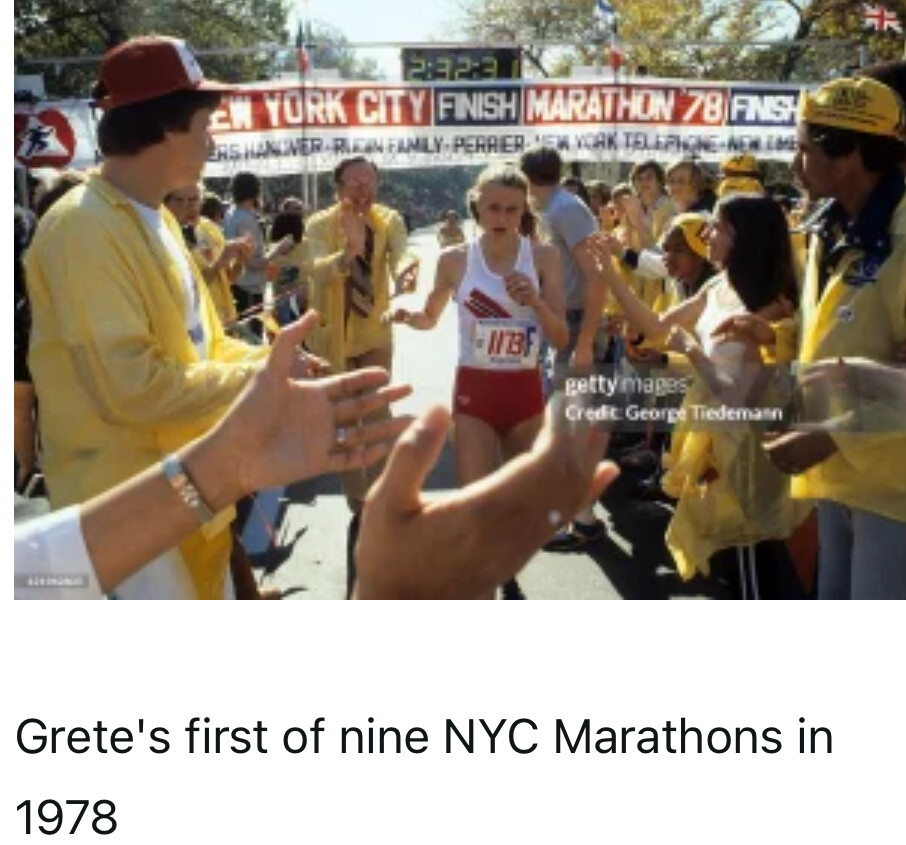
There have been many talented women champions through the years besides those three, including all the pioneers who had to overcome centuries of gender bias that restricted women from even showing their stuff.
But in terms of pure ground-breaking, the 1978 New York City Marathon drew a bright line between what once was and what would be.
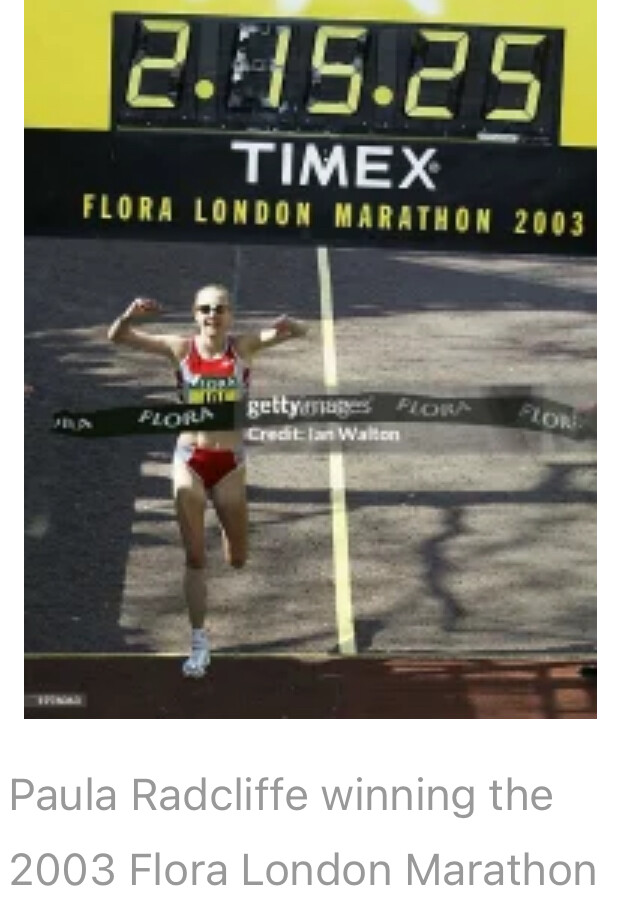
On 22 October 1978, Norway’s track and cross-country star Grete Waitz participated in the marathon for the first time, almost on a whim, as the trip was more of a honeymoon for her and husband Jack after the long track season.
The 2:32:30 world record Grete ran that day was totally unexpected by both the public and Grete herself. She wore bib #1173, wasn’t included on the list of elite women, and came with no specific marathon preparation (not a single run over 13 miles). In fact, she was so upset with husband, Jack, for suggesting she come run the marathon that she threw her shoes at him in the hotel room following her victory.
Still, like almost all debuting marathoners, after a short period of recovery and reflection, Grete concluded she could probably improve next time.
Thus, in New York 1979, following a more careful preparation, Grete ripped nearly five full minutes off her 1978 mark to record history’s first sub—2:30 by a woman at 2:27:33. Her margin of victory over England’s Gillian Adams was 11 minutes (2:38:33). The combination of the mild-mannered former geography teacher from Oslo and the raucous New York City crowds proved transformative, elevating women’s running to heights previously unimagined.
Though Japan’s Naoko Takahashi broke the 2:20 barrier for women in Berlin 2001, after Norway’s Ingrid Kristiansen (2:21:15, London ‘85), America’s Joan Benoit Samuelson (2:21:21, Chicago’85), and Kenyan Tegla Loroupe (2:20:43, Berlin ‘99) all challenged the barrier in the 1980s and ‘90s, it was England’s Paula Radcliffe who established new headlands in the marathon in London 2003 with her 2:15:25.
Nearly two minutes faster than her own 2:17:18 record from Chicago the year before, her 2:15 arced away from Catherine Ndereba’s 2:18:47 from Chicago 2001, completed just one week after Takahashi’s first sub-2:20 in Berlin.
The quality of Paula’s 2:15 can be seen in the 16 years and an entire shoe technology revolution that developed before Kenya’s Brigid Kosgei did Paula one better in Chicago 2019 at 2:14:04. That performance plowed new ground again. And now we have Ruth Chepngetich in Chicago 2024 with history’s first sub-2:10, just a year after Ethiopia’s Tigst Assefa’s first sub—2:12 in Berlin `23 (2:11:53).
Twice before, Chepngetich had come to Chicago with world record intentions. In 2022, she won the race in 2:14:18, just 14 seconds off Kosgei’s record. In 2023 she finished second in 2:15:37. On both occasions she flew through halfway under 66 minutes, only to falter in the second half. Perhaps she was a close reader of Malcolm X.
“There is no better teacher than adversity. Every defeat, every heartbreak, every loss, contains its own seed, its own lesson on how to improve your performance the next time.” – Malcolm x
In simple terms, making innovative strides in athletics requires time, experimentation, and reviewing, similar to how new scientific theories are examined before full acceptance. But women just haven’t been at the marathon game long enough to produce a large enough sample size to define their outer limits with any accuracy. They are barely two generations in since 1978.
Men have been competing for a much longer time with a much larger sample size.
Though Eliud Kipchoge surpassed the two-hour barrier in Vienna in 2019, that was accomplished as an exhibition, not a sanctioned race. In that sense, we are still awaiting the next barrier breaker on the men’s side in the Marathon.
Looking back, England’s Jim Peters stands as the first modern barrier breaker with his 2:18:40 win at the 1953 Polytechnic Marathon between Windsor and Chiswick in West London, England, history’s first sub—2:20.
Next was Ethiopia’s Abebe Bikila, the legendary double Olympic victor in Rome 1960 and Tokyo 1964. His 2:15:17 in Rome still stands as the barefoot marathon world record.
Next came Australia’s Derek Clayton, the first man under both 2:10 and 2:09. His 2:08:34 from Antwerp 1969 lasted for 12 years, holding off challenges throughout the entire Running Boom era headed by Americans Frank Shorter and Bill Rodgers.
Though never world record holders, the two Americans dominated the 1970s boom era, Shorter through the first half, Rodgers the second.
The Eighties were the last decade of international marathon champions: American (Al Salazar, Greg Meyer); European (Steve Jones, Carlos Lopes); Japanese (Toshihiko Seko and the Soh brothers); and Australian (Rob de Castella). Kenya’s Joe Nzau won Chicago in 1983 in a thrilling duel with England’s Hugh Jones when Chi-town was still developing its reputation as a world class event.
Ibrahim Hussein set new records in Honolulu and kick-started the Kenyan marathon revolution
The full East African deluge didn’t begin until 1987 and ‘88 when Kenya’s Ibrahim Hussein (already a two-time and soon to be three-time Honolulu Marathon champion) became Africa’s first New York City and Boston Marathon winner and Ethiopia’s Belayneh Dinsamo set the world record, 2:06:50, in Rotterdam 1988 that lasted over a decade.
The list of marathon stars from other nations scaled back markedly in the 1990s. Mexico had its turn at the top via greats like Dionicio Cerón (1994-`96 London champion), and back-to-back New York Ciy winner German Silva (1994 & 1995).
Moroccan-born American Khalid Khannouchi twice ran a world marathon record, first in Chicago 1999 (2:05:42), then three years later in London 2002 (2:05:38). And who could forget the personable Brazilian, Marílson Gomes dos Santos, who won New York City twice in 2006 & 2008, or Meb in NYC `09 and Boston 2014??
But the United Nations pickings get rather meager after that as East African athletes have had a stranglehold on the sport of marathoning, most dominatingly by Kenya’s Eliud Kipchoge. His run of sustained excellence over 42.2 kilometers was, and is, unprecedented in its longevity, including double gold in Rio 2016 and London 2020. And his last world record of 2:01:09 in Berlin 2022.
Sadly, the current record holder, Kelvin Kiptum, died in a car accident in February 2024 after establishing the 2:00:35 world record in Chicago 2023.
With the 2024 TCS New York City Marathon scheduled this weekend, we don’t expect to see any record performances. Yet, all the above is why we follow the game, isn’t it, to witness the arc of improvement over time, while hoping to discover a new name to remember? It’s as valid a focus as any other in this life.
And despite its many flaws and corruptions, the sport of marathoning retains an innate dignity that many endeavors do not. People may have bruised, battered, and tarnished it in the name of glory and money. But it survives, nonetheless, as a simple reflection of the human drive to achieve more in the quest to discover our best.
Doesn’t always turn out that way, but I don’t think we are done with it quite yet. Onward!
by Toni Reavis
Login to leave a comment
50 Motivational Running Quotes About Racing
Find Inspiration from Running Icons and Legends
Even the most motivated among us occasionally has a challenging time wanting to lace up our shoes and hit the pavement running. Bookmark this page for the next time motivation is waning for you. Read on for inspirational race quotes to pump you up before your next run.
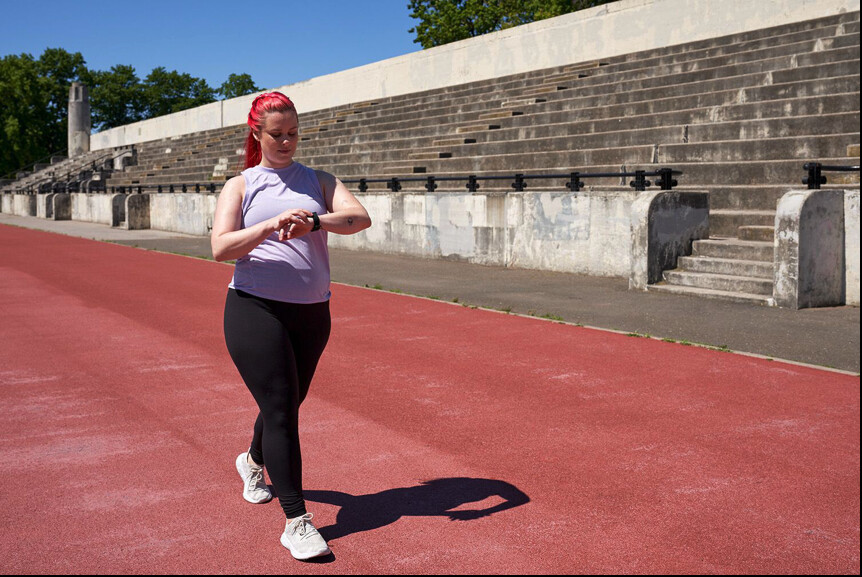
"The miracle isn't that I finished. The miracle is that I had the courage to start." —John Bingham, running speaker and writer
"Fear is gradually replaced by excitement and a simple desire to see what you can do on the day." —Lauren Fleshman, American distance runner
"It doesn't matter whether you come in first, in the middle of the pack, or last. You can say, 'I have finished.' There is a lot of satisfaction in that." —Fred Lebow, co-founder of the New York City Marathon
"When you put yourself on the line in a race and expose yourself to the unknown, you learn things about yourself that are very exciting." —Doris Brown Heritage, women's distance running pioneer
"Good health, peace of mind, being outdoors, camaraderie: those are all wonderful things that come to you when running. But for me, the real pull of running—the proverbial icing on the cake—has always been racing." —Bill Rodgers, winner of four Boston Marathons
"Big occasions and races which have been eagerly anticipated almost to the point of dread, are where great deeds can be accomplished." —Jack Lovelock, environmentalist and futurist
"I also realize that winning doesn't always mean getting first place; it means getting the best out of yourself." —Meb Keflezighi, 2004 Olympic Marathon silver medalist
"Why race? The need to be tested, perhaps; the need to take risks; and the chance to be number one." —George Sheehan, running columnist and writer
RELATED: A Beginner's Guide to Becoming a Runner
"Everyone in life is looking for a certain rush. Racing is where I get mine." —John Trautmann, Olympic runner
"I'm always nervous. If I wasn't nervous, it would be weird. I get the same feeling at all
"My thoughts before a big race are usually pretty simple. I tell myself: 'Get out of the blocks, run your race, stay relaxed. If you run your race, you'll win.'" —Carl Lewis, nine-time Olympic gold champion
RELATED: How to Plan a Running Route Using Map Apps on Your Phone
"I love controlling a race, chewing up an opponent. Let's get down and dirty. Let's fight it out. It's raw, animalistic, with no one to rely on but yourself. There's no better feeling than that." —Adam Goucher, U.S. Nationals 5K race champion
"I'm going to work so that it's a pure guts race at the end, and if it is, I am the only one who can win it." —Steve Prefontaine, legendary American long-distance runner
"Let's just say it and be done with it. Racing hurts. But here's another truth: having put in the effort to prepare for a race and then not giving it your all hurts even more. The first kind of hurt goes away in hours or a day. The second kind of hurt can last a lifetime." —Larry Shapiro, author of Zen and the Art of Running
"Different people have different reasons for racing, but
"Running is in my blood—the adrenaline flows before the races, the love/hate of butterflies in your stomach." —Marcus O'Sullivan, Irish middle-distance runner
"It's just as important to remember that each footstrike carries you forward, not backward. And every time you put on your running shoes you are different in come way than you were the day before. This is all good news." —John Bingham, American marathon runner
"Racing teaches us to challenge ourselves. It teaches us to push beyond where we thought we could go. It helps us to find out what we are made of. This is what we do. This is what it's all about." —PattiSue Plumer, U.S. Olympian
"You didn't beat me. You merely finished in front of me." —Hal Higdon, American writer and runner
"Fast running isn't forced. You have to relax and let the run come out of you." —Desiree Linden
"No marathon gets easier later. The halfway point only marks the end of the beginning." —Joe Henderson, famed running coach
RELATED: Race Day Tips for Running Your First 5K
"No matter how old I get, the race remains one of life's most rewarding experiences." —George Sheehan
"If you feel bad at
"What distinguishes those of us at the starting line from those of us on the couch is that we learn through running to take what the days gives us, what our body will allow us, and what our will can tolerate." —John Bingham, running writer and speaker
"For me, races are the celebration of my training." —Dan Browne, National Champion 5K and 20K runner
"Run when you can, walk if you have to, crawl if you must; just never give up." —Dean Karnazes, ultramarathon runner
"Every race is a question, and I never know until the last yards what the answer will be. That's the lure of racing." —Joe Henderson
"It's amazing how the same pace in practice can feel so much harder than on race day. Stay confident. Trust the process." —Sara Hall, American long-distance runner
"Winning has nothing to do with racing. Most days don't have races anyway. Winning is about struggle and effort and optimism, and never, ever, ever giving up." —Amby Burfoot, American marathon runner
"Your goal is simple: Finish. Experience your first race, don’t race it." —Bob Glover, author of The Runner's Handbook
"Don't dream of winning, train for it!" —Mo Farah, Olympic long
"Nothing, not even pain, lasts forever. If I can just keep putting one foot in front of the other, I will eventually get to the end." —Kim Cowart, runner and journalist
"The real purpose of running isn't to win a race. It's to test the limits of the human heart." —Bill Bowerman, co-founder of Nike
"Our running shoes have magic in them. The power to transform a bad day into a good day; frustration into speed; self-doubt into confidence; chocolate cake into muscle." —Mina Samuels, author of Run Like a Girl
"There is magic in misery. Just ask any runner." —Dean Karnazes
"Run often. Run long. But never outrun your joy of running." —Julie Isphording, American Olympic runner
Login to leave a comment
Another look at the new women’s marathon record set in Chicago today
30-year-old Kenyan Ruth Chepngetich destroyed the women’s marathon world record today (13 Oct. 2024) at the 46th Bank of America Chicago Marathon. Her time of 2:09:56 ripped 1:57 from the previous mark set in Berlin 2023 by Ethiopia’s Tigst Assefa (2:11:53).
At this point, the athletics record book feels like it ought to be written in No. 2 Ticonderoga pencil. That’s how fast records fall in this age of technological and nutritional advances. This is especially true at the longer distances where such advancements create greater margins.
Still, Ruth Chepngetich’s new world record stands out as history’s first women’s sub-2:10, and first sub-5:00 per mile pace average. But Tigst Assefa’s 2:11:53 mark set last year in Berlin had us all cradling our heads, as well. That performance cut 2:11 off Brigid Kosgei‘s 2:14:04 record from Chicago 2019, which shattered Paula Radcliffe‘s seemingly impregnable 2:15:25 set in London 2003.
In each case: Radcliffe’s, Kosgei’s, Assefa’s, and now Chepngetich’s record have caused mouths to gape in the immediacy of their efforts. But nothing should surprise us anymore.
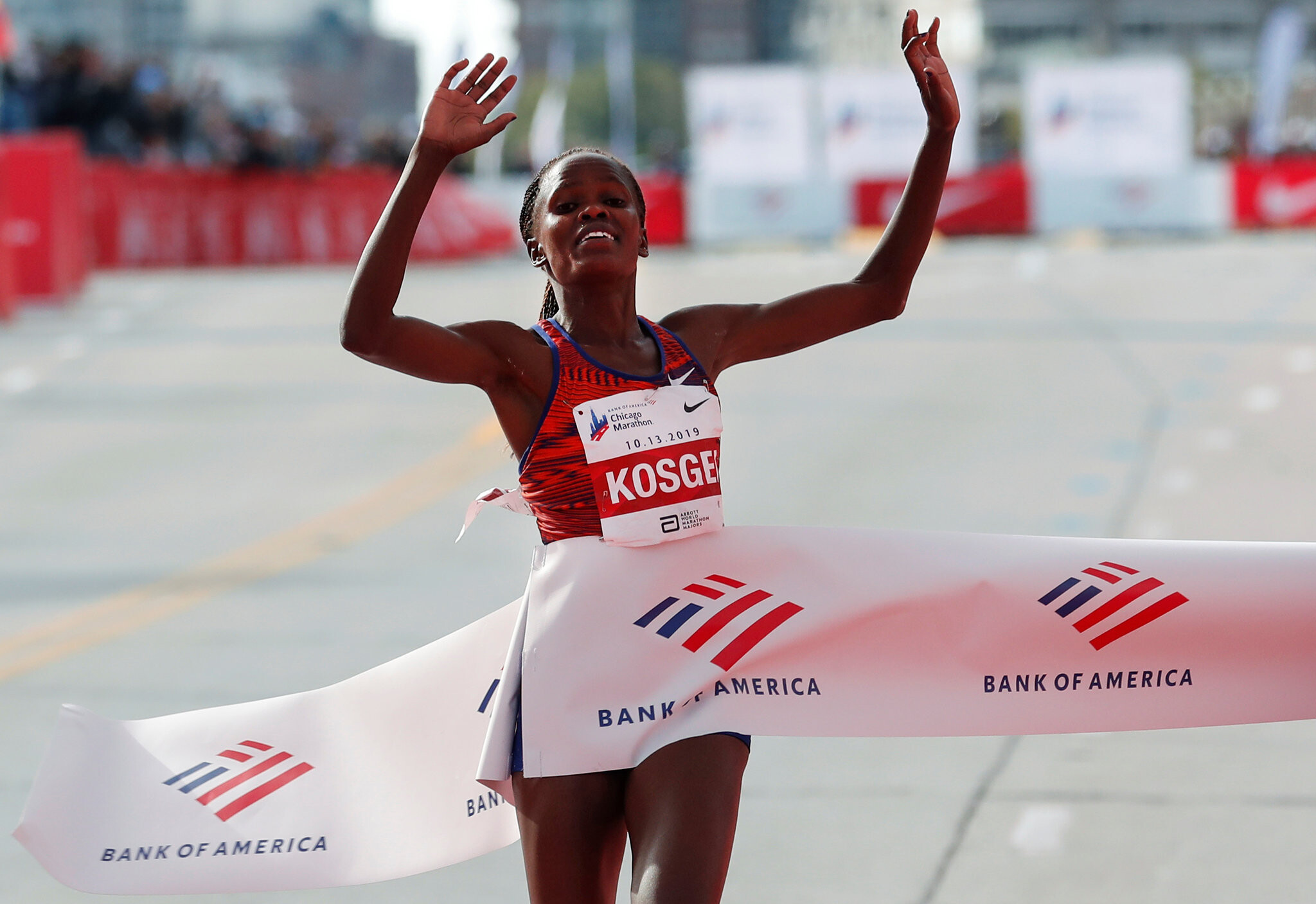
Racing is often a self-fulfilling prophecy determined by one’s build-up. Ruth Chepngetich said in her TV interview she came into Chicago off a perfect three-months of training after her disappointing ninth-place finish in London in April (2:24:36). Two previous wins in the Windy City (2021 and 2022) and a runner-up in 2023 meant Ms. Chepngetich arrived well seasoned on this course, with a keen understanding of what training was required to produce such a record run.
Of course, sadly, no record in athletics can be free of skepticism considering the industrial level of PED use that is uncovered, seemingly, every other Tuesday. Though understandable, cynicism should not be one’s default reaction.
To maintain any allegiance to the game, to follow it with any interest at all, we have to celebrate each record at face value. Just as rabid fans have to acknowledge some records to be ill-gotten, cynics accept that many special runs are exactly as they appear, above reproach.
Besides, when you break down Ruth’s 5k splits, each one from 5k to 35k was slower than the previous 5k. Not until the split from 35k to 40k (15:39) did she run faster than the split before (15:43 from 30 to 35k)
5k – 15:0010k – 30:14 (15:14)15k – 45:32 (15:18)20k – 60:51 (15:19)25k – 1:16:17 (15:26)30k – 1:31:40 (15:32)35k – 1:47:32 (15:43)40k – 2:03:11 (15:39)Fini – 2:09:56
1st half – 64:162nd half – 65:40
So congratulations to Ruth Chepngetich and her team for a marvelous run through a beautiful city. Now, let’s see how long this mark stays on the books before the No. 2 Ticonderoga pencil gets pulled out again.
BY THE NUMBERS
There have been 26 women’s world records set in the marathon since Beth Bonner‘s 2:55:22 in New York City in 1971. Over the ensuing 53 years, the average percentage change from one record to the next has been 1:26%. See WOMEN’S WORLD RECORD PROGRESSION.
Today’s record by Ruth Chepngetich, 2:09:56 (just one second slower than Bill Rodgers‘ American men’s record in Boston 1975!), lowered Tigst Assefa’s 2:11:53 mark by a healthy 1.5%. And Assefa’s time cut Brigid Kosgei’s 2:14:04 by 1.65%.
These latest records are still taking significant chunks off their predecessors and doing so in quick order. That suggests women are far from slicing everything they can from even this new record.
Yet, when comparing the women’s marathon world record to the men’s (2:00:35, set by Kelvin Kiptum in Chicago 2023), we see a differential of 7.2%. That is by far the best women’s record vis-à-vis the men’s throughout the running spectrum. Second place on that list is Florence Griffith-Joyner‘s 10.49 100m in relation to Usain Bolt‘s 9.58, a percentage difference of 8.675%.
The traditional rule of thumb has been a 10% gap between men’s and women’s records. But there are so many factors in play, it is difficult to make any definitive statement that explains one event, much less one athlete from another. I guess that’s why we keep watching.
by Toni Reavis
Login to leave a comment
Bank of America Chicago
Running the Bank of America Chicago Marathon is the pinnacle of achievement for elite athletes and everyday runners alike. On race day, runners from all 50 states and more than 100 countries will set out to accomplish a personal dream by reaching the finish line in Grant Park. The Bank of America Chicago Marathon is known for its flat and...
more...The Chicago Marathon has a strong history
First run in 1977, this Sunday, Chicago hosts its 46th marathon (it lost 2020 to the Covid-19 pandemic; 1987 to sponsorship issues). One of the six Abbott World Marathon Majors, the history of the BofA Chicago Marathon has been one of rising, falling, and rising again.
In 2023, it witnessed its third men’s marathon world record, 2:00:35, gloriously produced by the late Kenyan star, Kelvin Kiptum, who tragically died in a car accident on February 11, 2024 (age 24 years), in Kaptagat, Kenya.
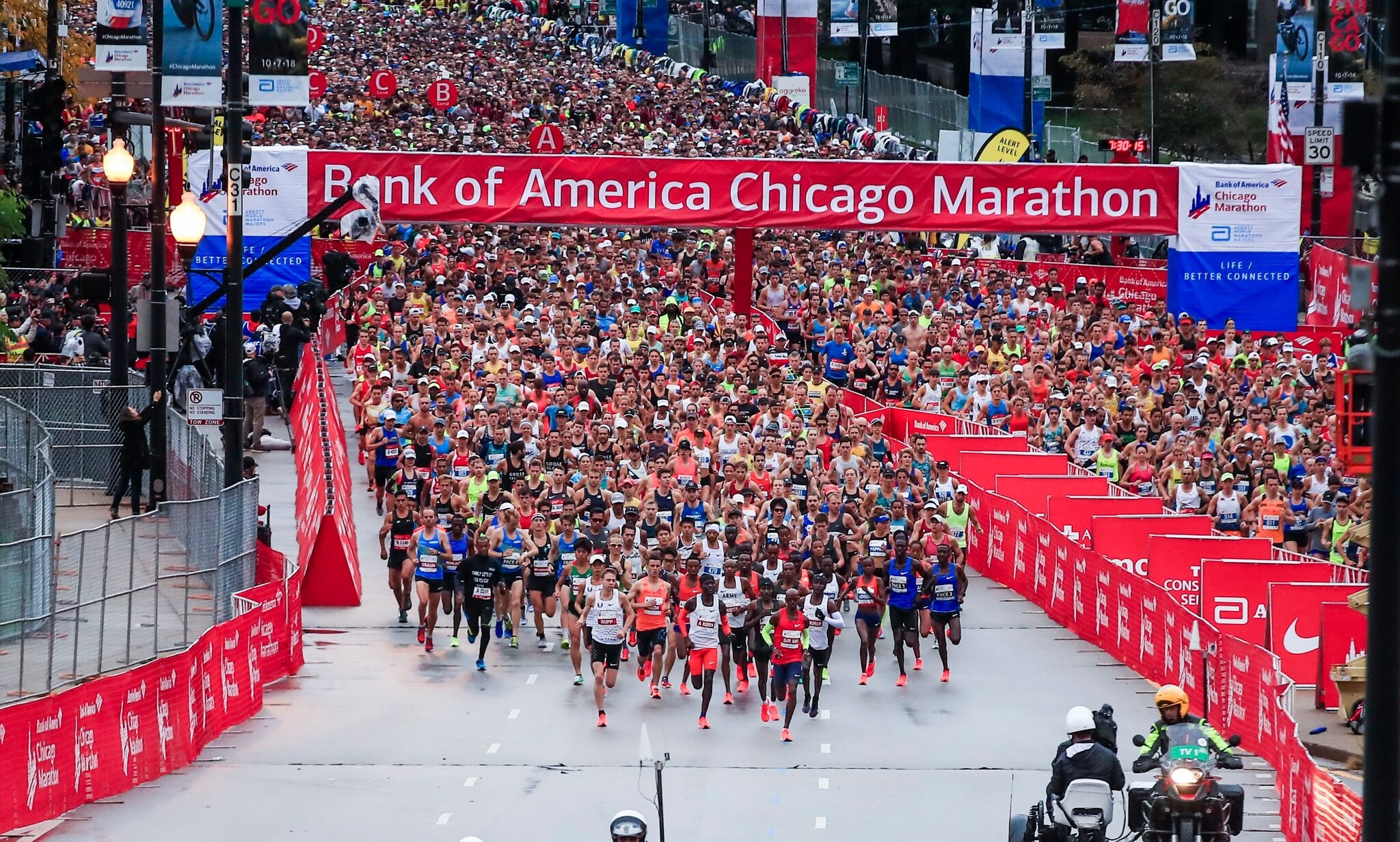
But the roots of the modern Bank of America Chicago Marathon traces back to 1982 when, in its sixth year, known as America’s Marathon/Chicago, the event rebooted, much as New York City 1976 was a reordering for the Big Apple 26-miler.
In America’s bicentennial year, the New York Road Runners expanded their event from four laps of Central Park to all five boroughs. It was a gamble. But in one fell swoop, the event grabbed the public’s attention, took on international importance, and ushered in a new era of urban marathons, even though they had run six previous marathons under the same banner.
In 1982, Chicago’s move from a regional marathon to the big time came about because of two things: one, the $600,000 budget put up by race sponsor, Beatrice Foods, and the hiring of one Robert Bright III of Far Hills, New Jersey to serve as athlete recruiter.
Bob Bright (left) at the Litchfield Hills Road Race in Connecticut with Nike east coast promo man, Todd Miller.
Recommended to the event by Olympians Frank Shorter and Garry Bjorlund, Bright had successfully elevated a modest 15K road race in Far Hills, New Jersey, called the Midland Run, to international prominence in 1980. So loaded was the Midland Run elite field, Sports Illustrated sent a reporter and photographer to cover the event.
What Bright brought to Chicago was zeal and a vision. Before Bright, there had been very little orchestration of competitive marathon racing. The Bright idea was simple: actively recruit a field of international athletes who came ready to run, so elite competition would become the hallmark of the event.
First, a brief history. For many decades, Boston dominated the marathon scene as essentially the only game in town. Yes, there was the Yonkers Marathonin New York, first contested in 1907; the Polytechnic Harriers’ Marathon for the Sporting Life trophy in England, which began in 1909. The Košice Peace Marathon in Slovakia joined the club in October 1924; Enschede and Fukuoka in 1947; Beppu in ’52.
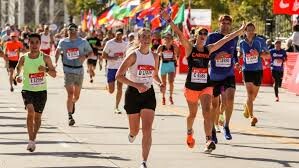
But the Boston Athlettic Association’s attitude from its marathon’s inception in 1897 up to the mid-1980s remained, “We’re running our race on Patriots’ Day starting in Hopkinton, Massachusetts at noon. It will cost you three bucks to enter. See you at the bus line for the ride out to the start.” No bells, no whistles, no invitations.
When New York City debuted in 1970, it spun four laps of Central Park to total its 26.2 miles. But in 1976, with the city in a major financial difficulty amidst America’s Bicentennial, the New York Road Runners boldly took its marathon from the confines of Central Park and expanded it through all five boroughs hoping to attract more tourists.
Race Director Fred Lebow recruited a few big guns upfront to entice press coverage, Olympic gold and silver medalist Frank Shorter along with Shorter’s rival, American record holder from Boston 1975, fellow Olympian, Bill Rodgers. Everyone else filled in from behind, with the City of New York being the true star attraction.
First considered a onetime gimmick, the five-borough experience proved so successful, the NYRRs embraced it as the path forward. Still, the actual races in NYC were never very competitive. Rodgers won by three minutes over Shorter in ‘76, 2:10:10 to 2:13:12. Then dominated for the next three years, as well.
Chicago 1982 would be the first, full–blown, orchestrated marathon race, as Bright had a specific recruitment strategy.
“We wanted six guys who thought coming in that they had a chance to win,” said Bright. “Then we wanted six more behind them who figured they had a shot at the top 10. So, right away we didn’t go after a guy like Alberto Salazar (who was ranked number one in the world after wins in New York City in 1980, a short-course world record in ‘81, and a Boston title in 1982.)
“And if you figure that a top race has a main pack of 10 to 15 athletes, you’re going to double that number in invitations. That guarantees that even if two of every five don’t run well for one reason or another, you still have a big group ready to race.”
Redundancy was the key, the money, the magnet. The total amount taken home by runners from Chicago in 1982 was $130,000.
This was when Boston was still embracing its amateur roots, stiff-arming the new breed of runners looking to get paid for their craft. In New York, Lebow had to keep his payments under the table in order to avoid being billed for city services on race day.
Chicago put up $48,000 in prize money for the men in 1982, with $12,000 going to the winner, 600 for 15th place. The women’s split was $30,000, with $10,000 awarded for the win through $500 for 10th. The remaining $52,000 represented the grease in upfront, under-the-table appearance fees.
“We wanted the money to be respectable, but not overwhelming the first year,“ explained Bright, whose history as a dog sled racer and thoroughbred horse trainer made him one of the best judges of the running animal. “We didn’t want it to appear like the race was store-bought, like the Atlantic City pro race a few years ago, where the money was good, but no one took the race seriously.
“So, we put up $78,000 in prize money, which, to the public, doesn’t sound like all that much. But when you added on the appearance money, it represented as much as any other race handed out.“
For the money on offer, and the prestige of doing well against a field of that caliber – as good as the group assembled at the 1980 Moscow Olympics, according to Sweden’s Kjell Eric Stahl – what came down in Chicago 1982 was a new course record by University of Michigan grad Greg Meyer (2:10:59), along with 22 more sub -2:220s, and nine personal bests out of the first 11 finishers.
The top five women followed suit, led by Northampton, Massachusetts’s Nancy Conz, whose 2:33:33 also represented a new course record for Chicago, some 12 minutes faster than the old mark.
The event treated the athletes well; offered a new opportunity in the fall, competing with New York City; Chicago witnessed its first truly world-class marathon; the sponsor, Beatrice Foods, received enormous visibility for its dollars; and a new professionalism attended the art of marathon orchestration. Chicago was now the new kid on the block, with toys to match anyone’s.
But now the pressure was on, not just to maintain its pace, but to top itself in 1983. The story continues.
by Toni Reavis
Login to leave a comment
Bank of America Chicago
Running the Bank of America Chicago Marathon is the pinnacle of achievement for elite athletes and everyday runners alike. On race day, runners from all 50 states and more than 100 countries will set out to accomplish a personal dream by reaching the finish line in Grant Park. The Bank of America Chicago Marathon is known for its flat and...
more...Bix 7 Notebook: Samuelson, Keflezighi collect more Bix hardware
The four legendary runners who appeared at various Quad-City Times Bix 7 events this week all made it through the grand 50th-anniversary race just fine.
In fact, two of them came away with awards.
Joan Samuelson, who has won four Bix 7 women’s championships and 15 masters titles, was the winner of the women’s 65-69 age group and she did it in record time — 50 minutes, 47 seconds. She now holds the women’s course record in four age groups — 50-54, 55-59, 60-64 and 65-69.
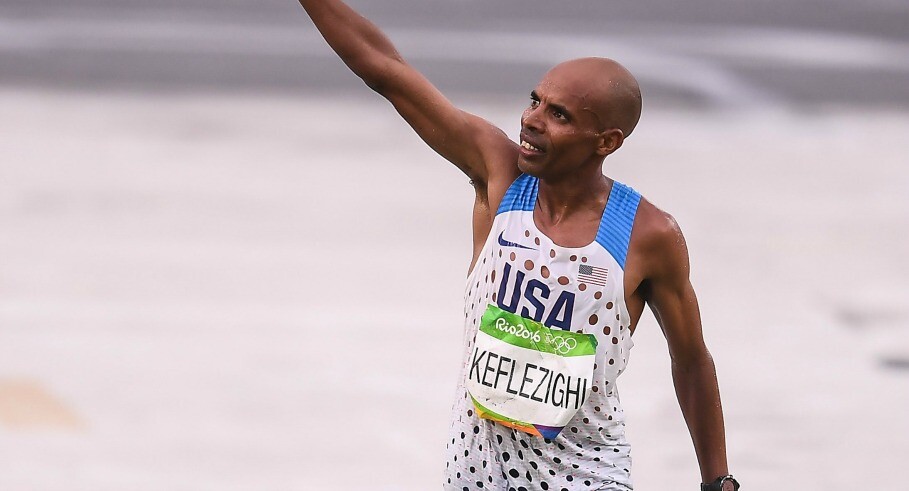
Meanwhile, two-time Bix 7 champion Meb Keflezighi added the men’s 45-49 age group championship to his resume on Saturday.
Keflezighi said he wasn’t really sure he was going to push himself in the race, but with the crowd cheering and urging him on, he couldn’t help himself. He covered the course in 41:37.
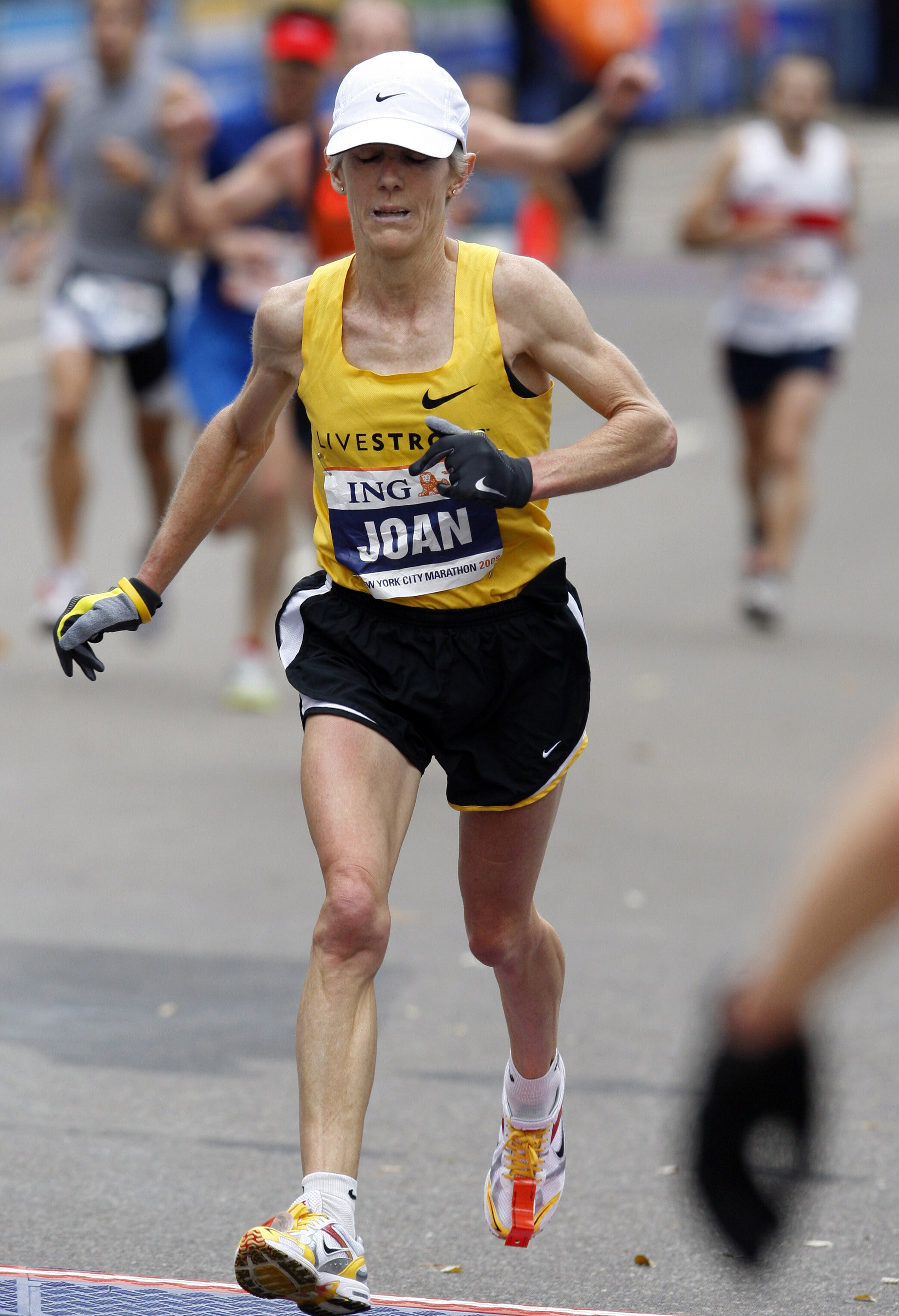
At one point, Keflezighi encountered a man who told him he’d had dreams of running the race with him.
“Then he took off, but I caught up with him and said ‘Let’s make your dreams come true,’’’ Keflezighi said.
Bill Rodgers, who won the Bix in 1980 and 1981 and has run it every year since, finished Saturday's run in a time of 1:19:46.
Two-time Olympic medalist Frank Shorter, who like Rodgers is 76, did the two-mile Quick Bix. But he said he still had a great time, marveling at how many times little kids breezed past him along the way.
At one point, a mother with a small daughter who Shorter estimated to be 5 or 6, came up alongside him. The mom told the girl to just go ahead and take off if she wanted. She’d see her at the finish line. The girl turned on the jets and took off.
“You could almost see the vapor trail,’’ Shorter joked.
Age-group records: Samuelson wasn’t the only person to set a course record for their age group.
It also was accomplished by Lucas Hollingshead of Elkhart, Ind., in the men’s 15-under division (37:41) and Richard Kutzner of Clear Lake, Iowa, in the men’s 80-84 (1:04:10).
And for the first time, the Bix 7 had 85-over divisions so the winners there obviously established records. The winners were Dave Zimmer of Long Grove, Iowa, and Norma Mullins of Moline.
Another Hird win: The first runner across the finish line in the Prairie Farms Quick Bix was a familiar face.
Zach Hird, a former Alleman High School runner who now lives in Naperville, Ill., won the Bix 7’s two-mile alternative in a time of 9 minutes, 48 seconds.
Hird won the Gregg Newell Trophy as the top local finisher in the seven-mile race in both 2018 and 2019.
The first female finisher in the Quick Bix on Saturday was Jennifer Douglass of Assumption, Ill.
Unbreakable Glass: Bryan Glass knows his Bix history well. Already a five-time master's champion, Glass put his name in the same breath as one of the Bix legends with a strong race Saturday.
At the age of 50, Glass finished the seven miles in 38 minutes, 21 seconds, becoming just the second runner 50 or older to run the race in under 40 minutes. The first? Bill Rodgers.
Glass was only 11 seconds off the 50+ record set by Rodgers — who ran 38:10 back in 1998.
"It was my goal for the last year, knowing that I could do it, I knew I could. Now, I ran faster than I ever thought I could do today, but I think it was just God giving me the ability to be prepared today, and I went for it."
Glass has a long history of running. He was a state champ at Geneseo and went to Southern Illinois University Edwardsville. He's also a member of the Springfield Road Runners Club Hall of Fame.
This is another accolade Glass has to be proud of.
"It's emotional because you work so hard for so many years," Glass said. "I never thought I'd get to the point where I'd have a chance to put my name up with Bill Rodgers. Now I know he's above anything I would ever beat, but to know that I'm in that same class in some sense in my home area, makes me so proud."
A rare Bix triple: Credit to recent Bettendorf High School graduate Maya Williams for giving it her all during the 50th QCT Bix 7 week. The standout sprinter pulled off a rare double on Thursday, running two races in the Brady Street Sprints — winning the open women's race and anchoring the Bulldogs' relay team to the high school girls' title.
Just for good measure, she figured she would jump into Saturday's 7-miler. Making that decision Friday evening didn't give her much recovery time. She posted a 1:18.21 clocking on Saturday.
RRCA honors: The Bix 7 served as the national championship race for the Road Runners Club of America on Saturday, which meant a little additional hardware for some runners.
In addition to men’s champion Wesley Kiptoo and women’s champion Raechel Chebet, Samuelson was honored as the women’s 60-over champion and Glass as the men’s 50-over champ.
Other honorees were Artur Mueller of Davenport, men 40-over; Jess Hruska of Dubuque, women 40-over; Kate Maurer of Urbandale, Iowa, women 50-over; and Rick Torres of Elizabethtown, Ky., men 60-64.
Weather vane: Saturday's weather for the race was nearly perfect. At race time, it was 68 degrees with a manageable 81% humidity. It was just the 18th time in 50 events that the race started with a temperature under 70 degrees.
Making her mark: Paityn Noe, last year’s Bix 7 high school girls’ top finisher, came back this year and had another solid race.
The University of Arkansas freshman from Huxley, Iowa (Ballard High School), was the seventh women’s finisher, clocking a time of 38 minutes, 34 seconds, just 2:13 behind winner Rachael Chebet.
In May, she finished second in the SEC Championships 10,000-meter run, clocking a 33:57.35. She also finished fifth last fall in the SEC cross country meet, running 19:43.7 for the 6,000-meter race.
Enjoy the day: Maggie Montoya, who was the third female overall finisher in Saturday’s Bix 7, enjoyed her first run through the streets of Davenport with 16,586 other people.
“When you’re surrounded by this mass of people, it brings you back to racing a marathon and being around people,” she said after finishing in 37:13. “It was nice to be back in that atmosphere.
“… There’s something about being surrounded by so many people that really adds to the event. It was fun being back out on the roads again.”
13-minute start: How long does it take for 16,587 to cross the starting line? The group of runners dressed as Elvis Presley, who almost always bring up the rear of the pack, finally got to the starting line when the race was 13 minutes old.
by TJ Johnson
Login to leave a comment
Bix 7 miler
This race attracts the greatest long distance runners in the world competing to win thousands of dollars in prize money. It is said to be the highest purse of any non-marathon race. Tremendous spectator support, entertainment and post party. Come and try to conquer this challenging course along with over 15,000 other participants, as you "Run With The Best." In...
more...Defending champions return to Bix
Kellyn Taylor and Biya Simbassa each ran the Quad-City Times Bix 7 for the first time last year.
They clearly loved the course, the atmosphere and just about everything about the annual race through the streets of Davenport.
Both Taylor and Simbassa held off late challenges from other runners, both ran the sixth best Bix 7 times ever by a U.S. athlete of their gender and both plan to return to defend their championships when the race is held for the 50th time on July 27.
It marks the first time in 12 years that both the men’s and women’s champions are returning to defend their Bix titles.
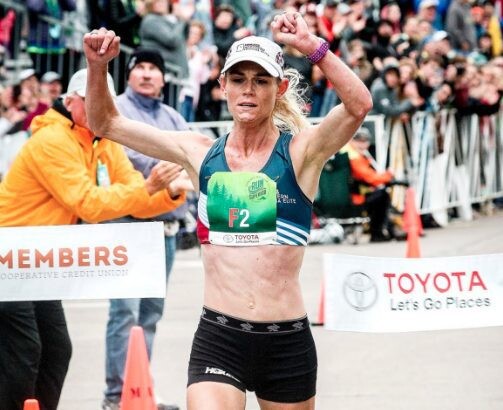
Simbassa admitted he wasn’t really sure how he felt about the Bix 7 course last year when he first saw the endless array of ups and downs in the course. But after holding off Olympian Clayton Young to win, he liked it.
“I mean, now I do,’’ he said after his victory. “It’s a course that’s all about strength and I train for this."
Taylor went through a similar transformation.
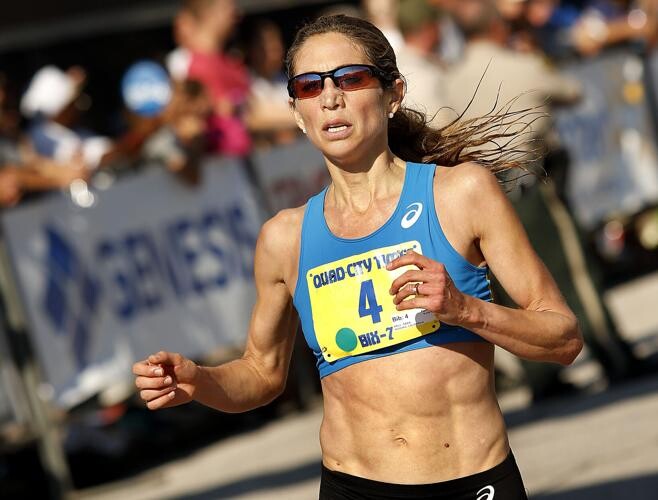
“When I saw the course, I was like, ‘Oh, no. What did I get myself into?’ ” she said. “That’s a super substantial hill right at the beginning and then it rolls all the way through. It’s certainly not easy by any means. I think that works to my favor since I’m more of a strength runner.”
Taylor appreciated more than just the hills.
“The crowds were amazing,” she said. “It’s not what I expected at all — the streets were completely lined, and a race that isn’t a huge marathon, I don’t feel like you see that that often. The crowds were incredible.”
Taylor and Simbassa will be bidding to repeat as Bix 7 champions, something that has been done only seven times in the race’s history, four times by men, three times by women.
Both runners failed to land berths on the U.S. Olympic team, which would have precluded a return to Bix, but they’ve still used their 2023 victories as a springboard to additional success.
Taylor briefly led the New York City Marathon last November before placing eighth, making her the top American finisher in the race. It was the third time she has been in the top eight at New York.
The Wisconsin native, who will turn 38 a few days before the Bix 7, then focused her attention on making the U.S. Olympic team and made a respectable showing in the trials in the marathon, finishing 15th, and the 10,000 meters, placing sixth.
Simbassa, a 31-year-old native of Ethiopia who now lives in Flagstaff, Arizona, attempted to earn an Olympic spot in the marathon but placed 11th in the trials.
However, he has followed that with an ambitious schedule on the U.S. road racing circuit, recording top-five finishes in the Bolder Boulder 10k (5th), Cherry Blossom 10-miler (5th), Gate River 15k (4th), Amway River Bank 25k (3rd) and Houston Half-marathon (4th).
Also included in the field are four former Olympians and nine other runners who have placed in the top 10 at the Bix 7 in the past. Elite athlete coordinator John Tope said even more top runners could be added between now and race day.
Among the top men’s entries are two former Iowa State University standouts.
Wesley Kiptoo of Kenya was the 2021 NCAA indoor 5,000-meter champion and a seven-time All-American for the Cyclones. He was seventh in the Bix 7 two years ago and won the Cherry Blossom 10-miler earlier this year.
Hillary Bor, a Kenya native who is now an American citizen, also attended Iowa State before representing the U.S. in the 3,000-meter steeplechase at the Olympics in both 2016 and 2021. He also is the U.S. record-holder in the 10-mile run.
Other former Olympians in the field are Morocco’s Mohamed El Aaraby and Americans Jake Riley and Shadrack Kipchirchir. Riley and Araby both competed in the marathon in Tokyo in 2021 and Kipchirchir ran the 10,000 meters in 2016.
Riley also is a Bix 7 veteran along with Kenya’s Reuben Mosip and Americans Frank Lara, Andrew Colley and Isai Rodriguez. Lara was second in the Bix 7 in 2021 and eighth a year ago.
Rounding out the men’s field are Raymond Magut of Kenya; Tsegay Tuemay and Tesfu Tewelde of Eritrea; and Americans Nathan Martin, Ryan Ford, JP Trojan, Merga Gemeda and Titus Winders.
The most recognizable name in the women’s field is 41-year-old Sara Hall, the wife of two-time Olympian, U.S. half-marathon record-holder and 2010 Bix champion Ryan Hall. Sara Hall was fifth in the U.S. Olympic marathon trials earlier this year and has two strong Bix 7 efforts on her resume, placing second in 2014 and third in 2017.
She and Taylor will be challenged by three up-and-coming runners from Kenya — Emmaculate Anyango Achol, Grace Loibach Nawowuna and Sarah Naibei. Achol has run the second fastest women’s 10k ever (28:57) and Naibei won the Lilac Bloomsday 12k in May.
Also in the field are Bix 7 veterans Kassie Parker, Jessa Hanson, Carrie Verdon and Tristin Van Ord along with Americans Annmarie Tuxbury and Stephanie Sherman, Ethiopia’s Mahlet Mulugeta and Kenya's Veronicah Wanjiru.
The elite field also includes four legendary runners who have helped build the Bix 7 into the international event that it is. Two-time champion Bill Rodgers, who has run the Bix 7 43 times, will be joined by four-time women’s champion and 1984 Olympic gold medalist Joan Samuelson, two-time Olympic medalist Frank Shorter and Meb Keflezighi, who has two Bix titles and an Olympic silver medal on his resume.
by Don Doxsie
Login to leave a comment
Bix 7 miler
This race attracts the greatest long distance runners in the world competing to win thousands of dollars in prize money. It is said to be the highest purse of any non-marathon race. Tremendous spectator support, entertainment and post party. Come and try to conquer this challenging course along with over 15,000 other participants, as you "Run With The Best." In...
more...Who is Sisay Lemma, the winner of the 2024 Boston Marathon?
Sisay Lemma was born in 1990 in the Oromia Region of Ethiopia. He is the winner of the 2024 Boston Marathon, with a time of 2:06:17.
Sisay Lemma is an Ethiopian long-distance runner who specializes in the marathon. He is the winner of the 2024 Boston Marathon, with a time of 2:06:17.
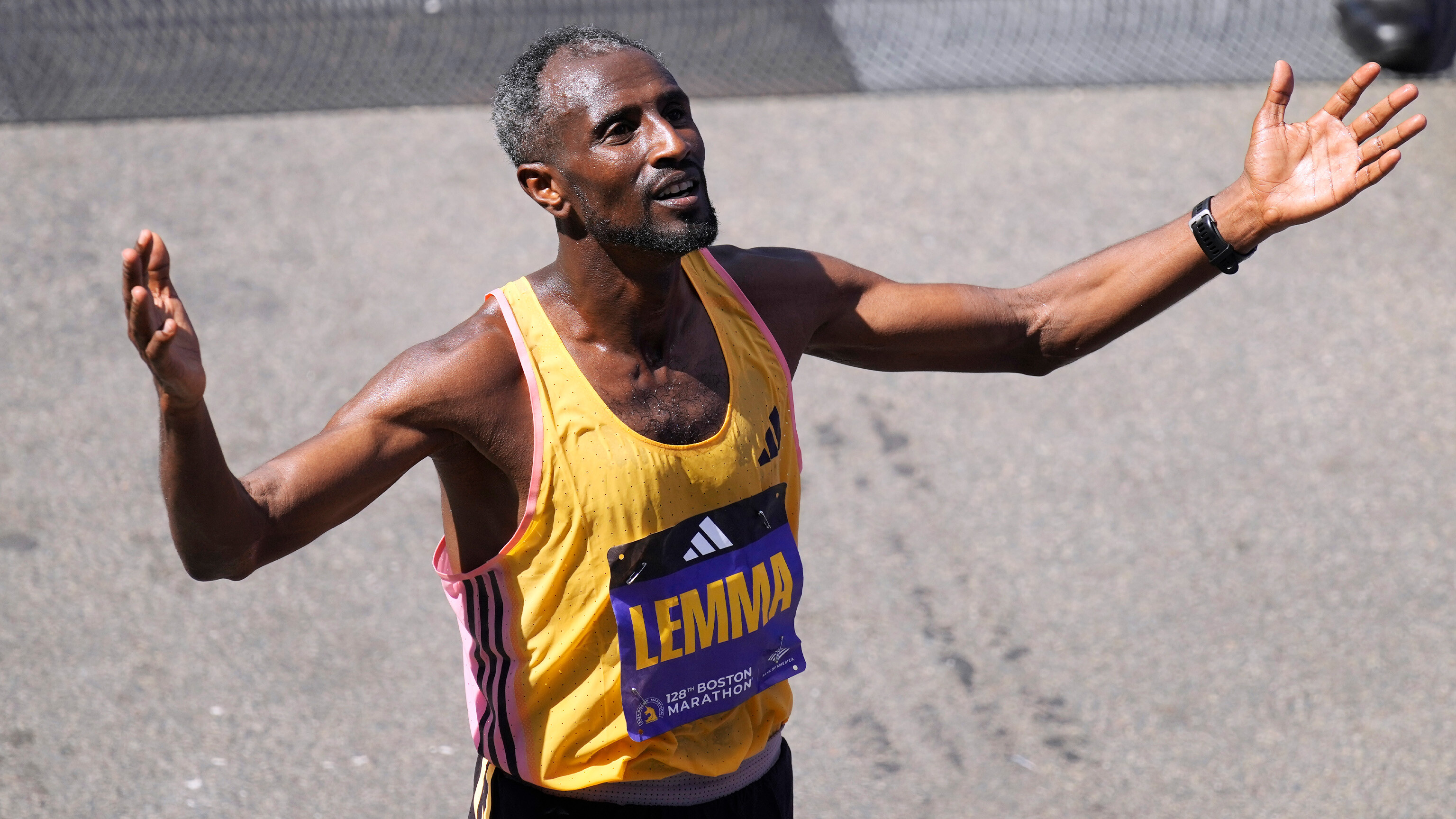
This was his first victory at the Boston Marathon, but he has previously won other major marathons, including the 2021 London Marathon and the 2023 Valencia Marathon. Lemma is also a three-time bronze medalist at the World Athletics Championships.
Lemma was born in 1990 in the Oromia Region of Ethiopia. He began running at a young age, and quickly showed promise. He made his international debut in 2013, and won his first major marathon in 2018, when he won the Rotterdam Marathon.
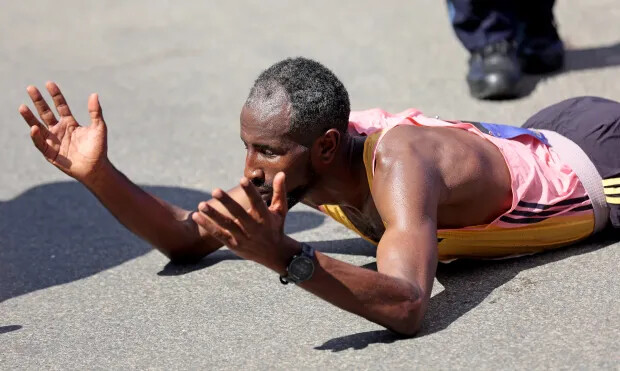
Lemma is known for his strong finishing kick. He has often won races by coming from behind in the final stages. He is also a very consistent runner, and has never finished a marathon outside of the top 10.
Lemma is a rising star in the world of marathon running. He is still relatively young, and has many years of good running ahead of him. He is a strong contender for medals at the major marathons, and the Olympic Games.
Here are some of Sisay Lemma’s career highlights:
Winner of the 2024 Boston Marathon
Winner of the 2021 London Marathon
Winner of the 2023 Valencia Marathon
Three-time bronze medalist at the World Athletics Championships
Winner of the 2018 Rotterdam Marathon
Personal best of 2:01:48 for the marathon
The Boston Marathon: The King of Marathons
The Boston Marathon is an annual foot race held in Boston, Massachusetts, United States. It is considered to be the most prestigious marathon in the world, and is one of the world’s oldest continuously run sporting events. The race is traditionally held on the third Monday in April, and it follows a 26.2-mile (42.2 km) route through the streets of Boston and the surrounding towns.
The Boston Marathon was first held in 1897, and it was inspired by the success of the marathon race at the 1896 Summer Olympics in Athens, Greece. The race was originally intended to be a qualifier for the 1897 Summer Olympics, but it quickly became a popular event in its own right. The Boston Marathon has been held every year since 1918, with the only exceptions being in 1918 due to World War I, and in 2020 due to the COVID-19 pandemic.
The Boston Marathon is known for its challenging course, which features several hills, including the infamous Heartbreak Hill at mile 20. The race is also known for its large and enthusiastic crowds, which line the streets throughout the course to cheer on the runners.
The Boston Marathon has been won by some of the greatest marathon runners in history, including Dick Hoyt, Bill Rodgers, Joan Benoit Samuelson, and Kathrine Switzer. The race has also been the site of several world records, including the first sub-2:00 marathon in 1978 by Geoffrey Hirt.
The Boston Marathon is more than just a race; it is a tradition and an institution. The race is a symbol of Boston’s resilience and spirit, and it is a source of pride for the city’s residents. The Boston Marathon is also a major fundraiser for charity, and it has raised millions of dollars for local charities over the years.
by Laura Islas
Login to leave a comment
Boston Marathon
Among the nation’s oldest athletic clubs, the B.A.A. was established in 1887, and, in 1896, more than half of the U.S. Olympic Team at the first modern games was composed of B.A.A. club members. The Olympic Games provided the inspiration for the first Boston Marathon, which culminated the B.A.A. Games on April 19, 1897. John J. McDermott emerged from a...
more...Pizzolato donates 1984 New York City Marathon winning shoes to MOWA
At the end of ABC television’s coverage of the 1984 New York City Marathon, there’s a shot of Orlando Pizzolato sitting on a bench in Central Park, retying his well-worn footwear. “Those shoes may have had it,” remarked anchorman Jim McKay.
Not quite. Some 39 years on, the shoes that took the unheralded Italian to the biggest upset victory in the history of the Big Apple’s big race have been generously donated to the ever-expanding Heritage Collection in the Museum of World Athletics (MOWA).
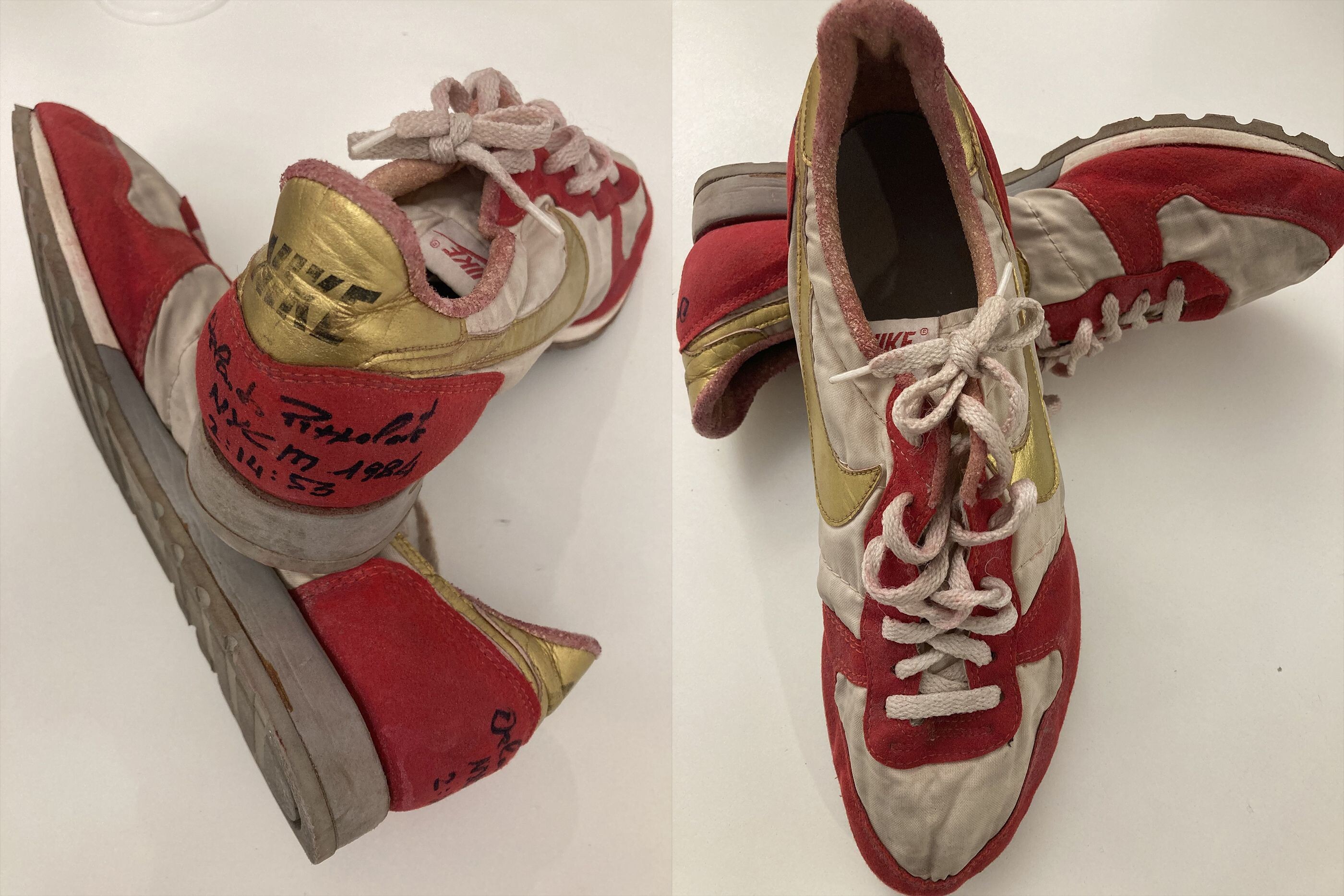
Whatever unfolds in the 2023 edition of the New York City Marathon this weekend, there’s unlikely to be anything as dramatic as the battle of attrition from which the plucky Pizzolato emerged as the unlikely hero in 1984.
As the Italian and the rest of the 18,000 field assembled for the start, it was difficult to pick out the contours of the Verrazano-Narrows Bridge. Such was the heat haze that had descended upon the Big Apple on the last Sunday in October that year.
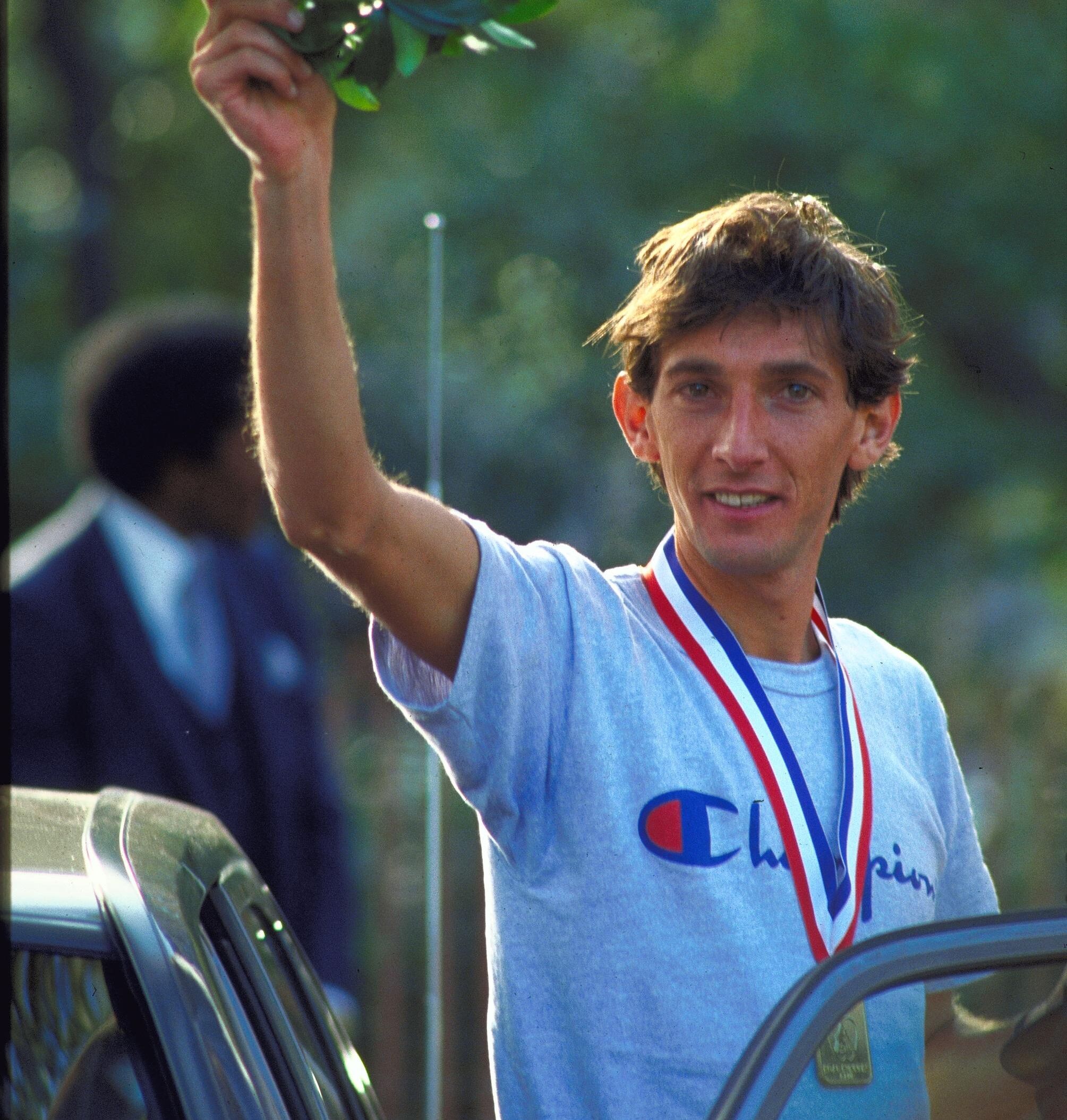
“The weather is going to be a huge factor,” proclaimed Marty Liquori, the great US miler, working as the expert summarizer on the men’s race for ABC Sports. “We’re looking at the hottest and most humid New York Marathon ever.”
The mercury was already pushing 70°F and the humidity was close to maximum.
“That causes two things to happen at the front of the pack,” continued Liquori, runner up to Miruts Yifter in the 5000m at the inaugural World Cup in Dusseldorf in 1977. “The natural front runners get conservative, so the pack stays tighter. The second thing is the hotter it gets, the greater chance there is for an upset.”
“Yes, look out for the man you do not know in this marathon,” predicted McKay, the distinguished Voice of ABC’s Wide World of Sports.
“This man could be for real”
Not a lot of people were looking out for the runner bearing race number 100, clad in the colors of his homeland – blue and white singlet, red shorts.
Pizzolato, a 26-year-old representing the University of Ferrara sports club from the north of Italy, was no Ferrari of a marathoner.
In seven attempts at the classic 26.2-mile distance, he boasted a best of 2:15:28 - more than seven minutes slower than the world record figures of 2:08:05 set by Welshman Steve Jones in Chicago a week before the 1984 New York race.
Pizzolato’s PB came in New York in 1983, the year Rod Dixon made up a half-mile deficit to overhaul Briton Geoff Smith virtually on the finish line in Central Park. The New Zealander’s winning time was 2:08:59. He finished 6min 29sec and 26 places ahead of Pizzolato.
Twelve months later, Dixon, the Olympic 1500m bronze medalist behind Finn Pekka Vasala and the trailblazing Kenyan Kip Keino in Munich in 1972, returned to New York as favorite for the men’s title – and the $25,000 prize and Mercedes Benz that went with it in that first year of open professional running.
“I’m a lot more confident in my own mind, having run successfully in ’83,” he told Liquori in a pre-race interview. “I think I’m rightly the favorite. I’ve trained well and I’ve got confidence in my own ability. I’ll go out and if I strike it right, they won’t catch me.”
Five miles in, given the exceptional conditions, Liquori and four-time winner Bill Rodgers, following the men’s race from ABC’s on-course buggy, felt Dixon was striking it right – 18 seconds down on home runners Pat Petersen and Terry Baker in a pack that included two-time Commonwealth gold medallist Gidamis Shahanga of Tanzania.
Pizzolato was also among the chasing group, seemingly unknown to any of the experts. His first name check came as he overtook Jose Gomez of Mexico to claim pole position, shortly before reaching halfway in 65:03.
“Could this, Marty, be the man they did not know?” McKay enquired.
“This man could be for real,” Liquori replied. “In the hotel I saw Franco Fava, a great steeplechaser from Italy, and he mentioned that it has been so hot in Italy this summer and fall. So, this is one person who is accustomed to the heat.”
Rodgers was not quite so sure. “I think it’s still anybody’s race,” he said. “The guy from Italy looks good. But we’ll have to see later in the race.”
“The Pope, Reagan and then it was me”
The guy from northern Italy was certainly looking good.
While Dixon seemed ill at ease, struggling to cope with the pace and the conditions some 1:15 behind, Pizzolato appeared to be feeling groovy as he crossed the Queensboro Bridge, the subject of Simon and Garfunkel’s 59th Street Bridge Song.
“Orlando looks very good,” Liquori observed. “He looks to have a style that’s fitting for a marathoner. When you’re looking around, taking in the scenery, you know that the running is coming easy.
“One thing should be pointed out. Steve Jones, who set the world record last week, was a very well-established track runner. He was eighth in the 10,000m at the Olympic Games.
“But Orlando has run a minute slower for 10,000m: 28:22. Were he to win this, it would be just about the biggest upset in a major marathon that I’ve seen.”
By the 20th mile mark, it was clear that Pizzolato himself was somewhat upset. The temperature had risen to 74 degrees and the humidity to 96%. His pace slowed to a 5:26 mile.
Briton Dave Murphy was gathering momentum, moving up into second, and Dixon into third.
“Well, I think we’re entering the last chapter of Orlando,” ventured Liquori. “I think I might have got too excited at 18 miles. Maybe it was the Italian in me.”
Soon after, Pizzolato grabbed his chest and slowed to a temporary halt. Three times he stopped, then started up again. “This man is in trouble,” said McKay.
Entering Central Park, with less than three miles to go, Pizzolato stopped for a fourth time. He clutched his chest, glugged half a cup of water and poured the other half over his head.
Dixon was out of the equation at this point, having stepped off the course suffering from cramps. But Murphy had closed to within 15 seconds.
“It’s like the tortoise and the hare,” said Liquori. “Pizzolato’s running-stopping, running-stopping. Murphy is just taking a steady course. It looks like it’s his race.
“For Pizzolato now, the drama now is how much of his soul he’s going to lay down.”
Thrice more, Pizzolato stopped and started, each time taking on fluid and calmly checking out the gap behind him. Somehow, he managed to lay down enough of his soul to bridge over his troubled water.
The finished line approached with Murphy not yet in sight.
“He has pulled it off,” Liquori pronounced. “He has mentally been able to fight through his form having gone to pieces, through having had so many problems.”
“It was very hot,” said Pizzolato, who crossed the line in 2:14:53, 43 sec ahead of Murphy. “I had cramp in my stomach. It was very terrible, but I am very happy.”
The New York Times the next day concentrated on Grete Waitz’s sixth success in the women’s section, praising Pizzolato in passing for having overcome the heat and the late challenge of Murphy in “a men’s competition that the stifling heat and humidity reduced to a battle of attrition.”
Back home in Italy, the reaction was different. “The first story in the news was the Pope,” Pizzolato reported, “then Ronald Reagan’s election. Then it was me.”
Retained title
Twelve months later, the guy from Italy returned to New York and proved he was no flash in the marathon pan.
This time he was the tortoise, running his steady race while Geoff Smith burned himself out at world record pace, then overtaking Djibouti’s World Cup Marathon winner Ahmad Saleh two miles from home to become the Big Apple’s first overseas two-time winner, clocking 2:11:34.
“Last year I won by mistake, probably,” Pizzolato told The New York Times. “This year was more exciting. I was not in confusion in the last 365 yards.
“All the people seemed to know my name and my number. It was like everyone was a friend of mine. It was a great source of power.”
In an era when the fast men of the track came to dominate the men’s marathon – with the likes of Jones, Dixon and Carlos Lopes, the Portuguese runner who won the Olympic title in Los Angeles in 1984 and succeeded Jones as world record-holder in 1985 – Pizzolato was a great source of power and inspiration to the traditional specialists of the event.
He never broke 2:10. His fastest time was 2:10:23, which he recorded while placing sixth in the World Cup Marathon in Hiroshima in 1985. The following year Pizzolato was third in Boston (2:11:43), then overtook a shattered Jones to claim the European Championships silver in Stuttgart (2:10:57) behind his compatriot Gelindo Bordin, and returned to New York taking third place (2:12:13) behind another Italian, Gianni Poli.
These days the two-time Italian king of New York operates a company bearing his name which offers running camps and a consultation service, and which provides scholarships to athletes aged from 16 to 22.
by Simon Turnbull for World Athletics Heritage
Login to leave a comment
Cam Levins to take on TCS New York City Marathon
Canadian marathon record holder Cam Levins will be tackling the TCS New York City Marathon on Nov. 5, when the 34-year-old will go toe to toe against an extraordinarily deep field that includes defending champion Evans Chebet of Kenya.
This will be the first time Levins, who ran 2:05:36 at the Tokyo Marathon in March to break both the national and North American marathon records, takes on the 42.2-km distance in New York. The Black Creek, B.C., runner, who also holds the Canadan half-marathon record (60:18), ran the 2019 New York Half Marathon in 65:10 to place 18th.
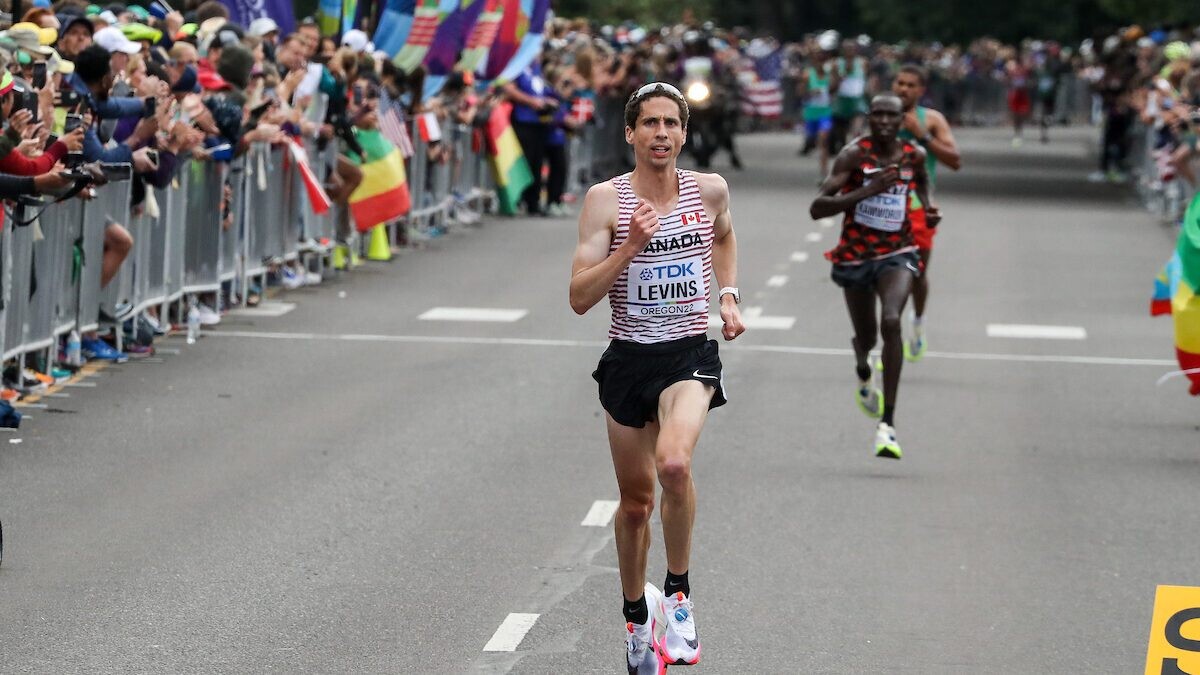
Levins has broken the Canadian marathon record three times: first in 2018, then at the 2022 World Championships in Eugene, Ore., and again in Tokyo this year. Earlier this year he hinted he would plan on a hilly fall marathon as preparation for his overarching goal: the Paris Olympics.
This time he’ll be facing Kenya’s Chebet, who won the TCS New York City Marathon last year in 2:08:41, seven months after winning the Boston Marathon. He became the eighth man in history to win both races in the same year, and the first since 2011. Chebet already defended his Boston title earlier this year and has finished first or second in 13 marathons.
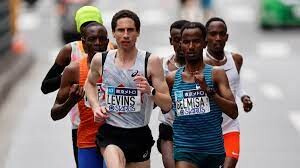
“I feel very confident as I begin my preparations to defend my TCS New York City Marathon title,” Chebet said. “I understand that nobody has won Boston and New York in back-to-back years since Bill Rodgers in the 1970’s, so making history will be my aim.”
Also challenging Levins will be Geoffrey Kamworor, a Kenyan Olympian and three-time half marathon world champion who is looking to become only the third athlete to win three TCS New York City Marathon men’s open division titles. He won in both 2019 and 2017, and has made the podium in all four of his appearances.
Others toeing the line will also include the 2023 World Athletics Championships marathon silver medallist Maru Teferi, two-time World Championships silver medallist Mosinet Geremew of Ethiopia, Olympic silver medallist Abdi Nageeye of the Netherlands (who finished third in New York last year), 2021 TCS New York City Marathon champion Albert Korir of Kenya, two-time TCS New York City Marathon runner-up Shura Kitata of Ethiopia and 2023 United Airlines NYC Half podium finisher Zouhair Talbi of Morocco.
Kenya’s Edward Cheserek–a former New Jersey high school phenom and the most decorated athlete in NCAA history–will make his 42.2-km debut, while the American contingent will be led by 2022 USATF marathon champion Futsum Zienasellaissie and 2021 TCS New York City Marathon fourth-place finisher Elkanah Kibet.
by Paul Baswick
Login to leave a comment
TCS New York City Marathon
The first New York City Marathon, organized in 1970 by Fred Lebow and Vince Chiappetta, was held entirely in Central Park. Of 127 entrants, only 55 men finished; the sole female entrant dropped out due to illness. Winners were given inexpensive wristwatches and recycled baseball and bowling trophies. The entry fee was $1 and the total event budget...
more...Bill Rodgers is set to run his 43rd Quad-City Times Bix 7
In 1978, Bill Rodgers entered 30 road races and amazingly, astonishingly, he won 27 of them.
Over the course of his running career, he won 22 marathons, all during a thoroughly incredible 10-year period from 1974 to 1983.
He doesn’t win anything anymore, not even in his age group, but the 75-year-old Boston resident is still running, and he will be coming back to run the Quad-City Times Bix 7 for the 43rd time on July 29.
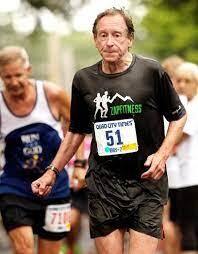
Rodgers said he thought he had done the Falmouth Road Race on Cape Cod about 35 times and the Cherry Blossom 10-miler in Washington, D.C., perhaps 30 times.
He never has entered any race as frequently as he has the Quad-City Times Bix 7, which is holding its 49th event this year.
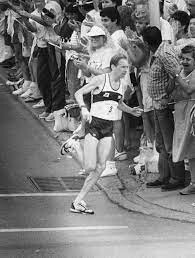
“And the Bix is probably the most challenging of them all,’’ Rodgers said. “But it’s a race I remember so well from that first time in 1980. I was still young and I could duke it out and I could race. Now I just try to hang on.’’
A man who once logged hundreds of miles in training each week now jogs 25 to 30 miles a week. He has done about 10 races this year, including Cherry Blossom. He said he now just went back to some of the old events he did during his heyday.
“But I’m back in the pack,’’ he said. “I’m way back in the pack because I’m 75 years old. It’s like a whole different thing. My strength used to be that I was a marathoner and I could do high mileage. I was a high-mileage runner. I wasn’t as quick as some runners, but I could do the mileage.’’
Not anymore. During the COVID-19 pandemic, Rodgers had a chance to sift through almost 50 years of running logs and he calculated that he has done more than 1,500 races and run at least 190,000 miles in his lifetime.
Most automobiles don’t last that long. And Rodgers hasn’t had the benefit of having a change of tires or periodic oil changes.
His body is feeling the effects of all that mileage. When he enters races now, he frequently finds himself trailing runners of a similar age who have fewer miles on their personal odometers.
“What I’m seeing is I see a lot of these runners who are in their 60s and 70s and they’re all ahead of me, but they just started running pretty recently or something,’’ he said.
He steps up to a new age group this year but doesn’t figure on being a contender to win it. The Quad-City Times Bix 7 course record for men ages 75-79 is 54 minutes, 58 seconds. Rodgers’ finishing time a year ago was 1:08:43.
Despite that, he still enjoys running.
“Now when I do 30 miles a week, I feel like when I was doing 100 miles a week,’’ he said. “I feel good, relatively speaking. No complaints with regards to running. I think it’s a great way to live.’’
Rodgers won the Quad-City Times Bix 7 the first two times he came here, in 1980 and 1981, and finished in the top 10 on seven occasions.
However, he is remembered almost as much for other years.
In 1995, he paused as he was coming down Kirkwood Boulevard to catch women’s leader Olga Appell just as she collapsed from heat exhaustion. He made sure that Appell received medical attention before jumping back into the race.
Login to leave a comment
Bix 7 miler
This race attracts the greatest long distance runners in the world competing to win thousands of dollars in prize money. It is said to be the highest purse of any non-marathon race. Tremendous spectator support, entertainment and post party. Come and try to conquer this challenging course along with over 15,000 other participants, as you "Run With The Best." In...
more...Yes, Zone 2 Training Is Important. (Just Don't Forget the Other Stuff.)
Right now in the fitness community, the hottest topic is Zone 2 training.
Everywhere you look, both coaches and runners are extolling the benefits of running at a Zone 2 effort, while advising runners to be wary of running too hard on easy days.
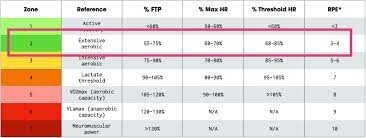
Make no mistake: there are great reasons for running most of your mileage at an easy effort around Zone 2. No coach worth her salt will tell runners that easy running isn't advantageous. In fact, a lot of easy running is the key to racing faster and building a strong body that's resilient against injuries.
But with all this focus on Zone 2, are we ignoring other zones? What about Zone 1? Or what about Zone 3 (which seems to have become the boogeyman of running efforts)? Despite the baggage of Zone 3, and most athletes ignoring Zone 1, these zones still have value.
In fact, every zone has a place in a well-designed training program. Let's get into the weeds, explore the nuance, and discover each shade of gray about zone training.
What is Zone 2 Running?
Zone 2 running is best defined as easy running where you're still able to hold a conversation with a friend. The effort usually corresponds to about 60-70 percent of maximum heart rate.
This zone is part of the 5-zone system:
Zone 2 is often considered the lowest intensity that produces meaningful training adaptations. It's receiving a lot of attention in the running community because it has a lot of benefits with very little risk of over-training or injury. But this is not new. Runners have been married to the idea of easy running since the 1970s, when US marathoner Bill Rodgers was winning major marathons while running up to 180 miles per week-nearly all at an easy effort.
We've called long runs LSD ("Long Slow Distance"), short runs "recovery jogs," and bemoaned our training partners for not running at "conversational pace." In Boulder, Colorado, there's a weekly "fun run" at such an easy effort it's called "soft hour."
There's no denying that Zone 2 is a key pillar of any endurance runner's training-in fact, it's likely the most important intensity zone for every runner-but that doesn't mean it's the only actor in the play.
Runners know and understand the value of easy, comfortable running. It's just currently being rebranded into something new called "Zone 2 training" (just like, a decade ago, we heard all about High Intensity Interval Training-or hard track workouts).
Zone 2 is Just One Piece of the Puzzle
There's no denying that Zone 2 is a key pillar of any endurance runner's training-in fact, it's likely the most important intensity zone for every runner-but that doesn't mean it's the only actor in the play. While it's vital, it's just one piece of the puzzle.
Zone 1 running can be enormously helpful for base building, especially with longer efforts that last multiple hours. A four-plus hour fast hike at altitude up a mountain is a good example of beneficial Zone 1 training.
However, Zone 1 isn't as productive at producing endurance adaptations, so it's usually reserved for cross-training, very long efforts, or just parts of certain runs (where most of the effort is Zone 2). A good example is a short recovery run where the first 10 minutes might be at a Zone 1 effort before gradually transitioning to a Zone 2 effort.
And while Zone 3 is often presented as a "danger zone" or the "gray zone" of training, it also has its place. High-level, competitive athletes have the talent to spend more time during an easy run at these moderate intensities. And beginners who are running low mileage can also do a fair amount of Zone 3 running because their volume is low, and they likely won't make as many adaptations without it.
Just be careful with too much Zone 3 running: if more than 40-50 percent of your mileage is at this intensity, it presents a higher injury risk due to additional mechanical stress and less recovery due to higher intensities.
Of course, any performance-oriented runner with goals of running a certain finish time will want to spend time in both Zones 4 and 5, too, which we can consider "workout zones." Race paces of 10K and faster fall into these zones and can be used for structured workouts for approximately 15-20 percent of total weekly volume.
An example week with mileage levels, workouts, and zones illustrates this concept:
In this example, the athlete is running 80 percent of their total weekly volume at a Zone 1 or Zone 2 effort, 10 percent of their effort in Zone 3, and 10 percent in Zone 5.
As we think about the complete training program over the course of a season, we can see that many intensities (like Zone 2) will remain constant throughout the season. Some intensities will have a stronger presence during the base phase, like Zone 1, while others will be prioritized late in the season (like Zone 5).
Just like a delicious soup, every ingredient has its place.
The Bottom Line
Clearly, I'm a Zone 2 stan. It's an integral intensity zone for any runner, whether you're a professional track and field athlete, frequent half marathoner, or a first-time ultramarathoner. If I was forced to choose the single-most important zone for running, I'd choose Zone 2.
But it's not the only party in town. Every runner should strive to be a well-rounded athlete who's capable at every intensity zone. Simply put: Zones 1-3 build capacity while Zones 4 and 5 sharpen your existing fitness. Any good training program should include a healthy mix of all zones because these energy systems all contribute to an athlete's ability.
Ultimately, good runners have range at a variety of distances because they don't ignore any zones or over-prioritize a specific zone. And that range-the ability to run well at the 5K, half-marathon, and ultra distances-is a testament to preparing every energy system during training.
by Trail Runner Magazine
Login to leave a comment
USA Record For Hillary Bor Yields $59,000 Payday At Cherry Blossom 10 Mile
The 50th edition of the Credit Union Cherry Blossom 10 Mile here this morning ended with a bang when Olympic steeplechaser Hillary Bor not only won the men’s division of the USATF 10 Mile Championships, but also claimed a $50,000 bonus for breaking Greg Meyer’s 40-year-old national record by just two seconds.
Bor, 33, who represents Hoka One One and wore bib 13, clocked 46:11, three seconds behind overall race champion Tsegay Kidanu of Ethiopia. Including his prize money, Bor collected a total of $59,000.
“I came here to break the record and the weather wasn’t going to stop me,” Bor told Race Results Weekly, referring to the unusually cold temperatures and strong winds. “It’s something I’ve been working for since October last year.”
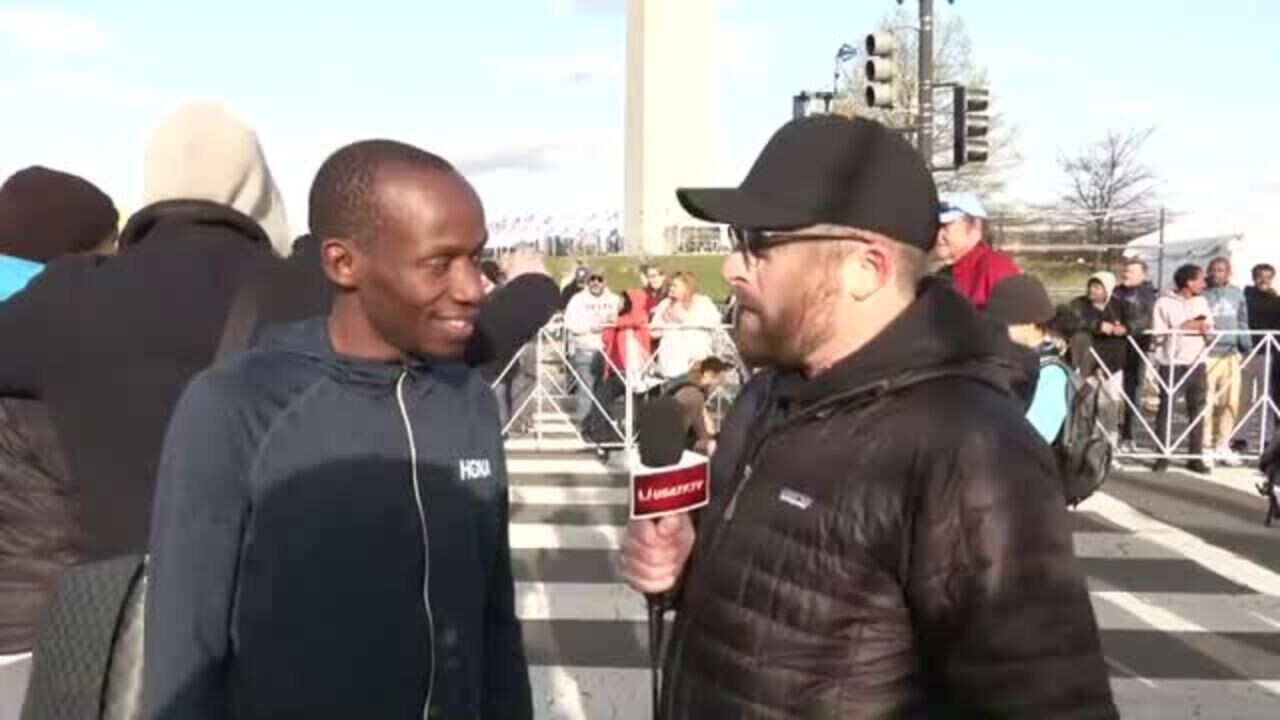
Last October Bor won the USATF 10 Mile Championships in St. Paul, Minn. He ran 46:06 in that race, a championships and course record, but that course was 31 meters downhill and not eligible for record setting. However, Bor and coach Scott Simmons realized that breaking Meyer’s mark was within his capabilities, especially because a faster time run by two-time Olympic medalist, Galen Rupp, was never ratified by USATF. Rupp ran a 10 mile split of 45:54 at the Row River Half-Marathon in Dorena, Ore., in October, 2020, but the paperwork for verifying that record was never completed or approved.
“My coach knew I was in really good shape to run 45 (minutes),” Bor said. “But, the weather’s not good today. The last two miles was just the wind on our face the whole time.”
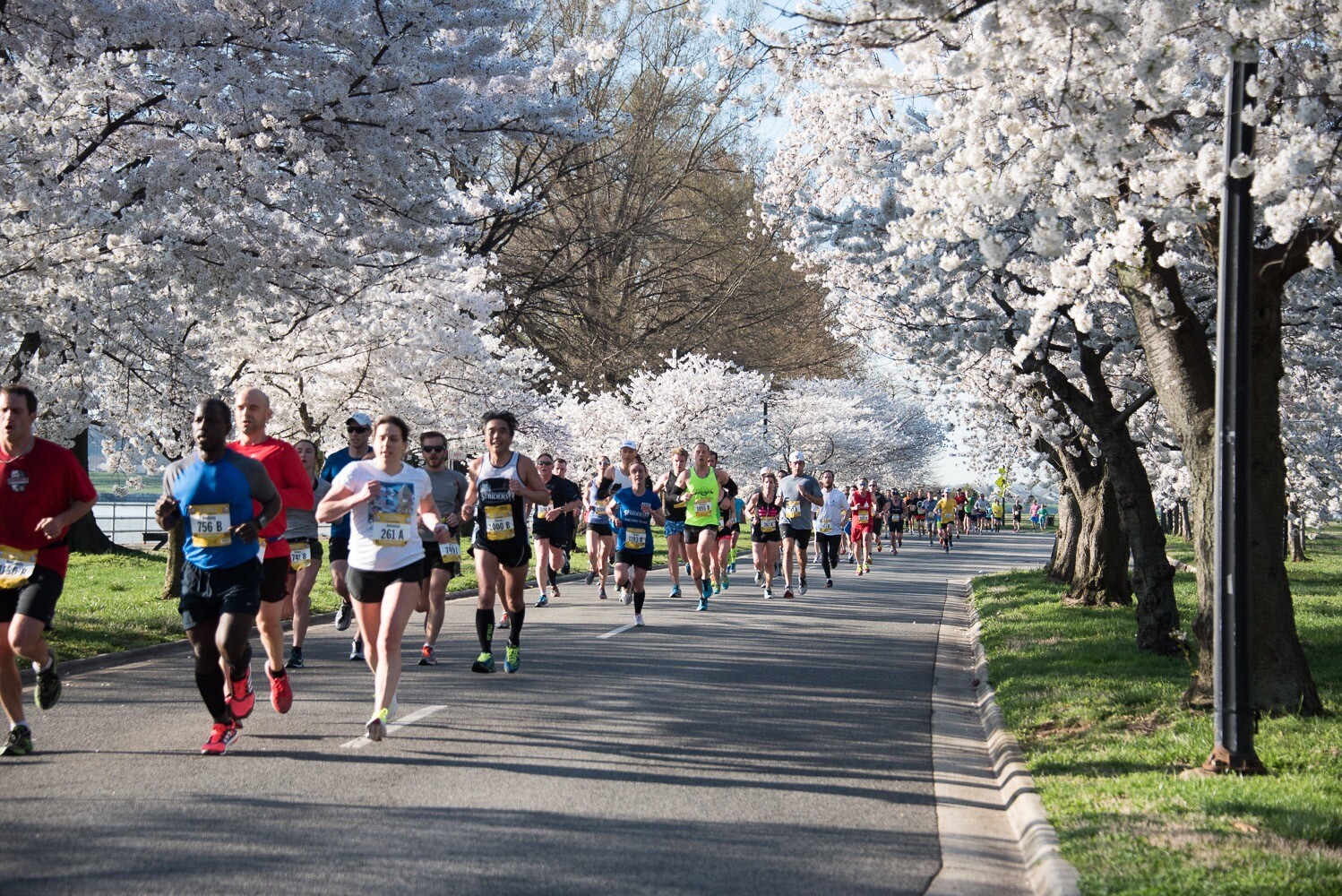
Indeed, it was in those last two miles that Bor and Kidanu did their best to push each other. Kidanu, who represents Asics, was just trying to keep up the pressure on Bor.
“The wind was very strong and it made it very tough,” Kidanu told Race Results Weekly through a translator. He continued: “At the beginning there were a lot of us, but later only a few of us. But the wind made it very difficult. Two of us were able to prevail and we battled one another. In the end, I was able to win.”
In the final sprint to the line, Bor wasn’t really sure where he stood against the clock. The wind was so strong that the 9-mile marker blew down, despite being weighted with sandbags. Also, Bor started the race without his watch.
“Today, I didn’t have my watch so that was not really good because I didn’t know the splits,” Bor said, looking slightly embarrassed. “When I saw the split at 8 miles I knew I needed to run 4:45, but the wind was too much. I just put my head down and just grind, and grind, and grind.”
Biya Simbassa (Under Armour) finished a distant third in 47:09 and finished second in the national championships division. Kenya’s Charles Langat (Asics) was fourth in 47:25, and Jacob Thomson (Under Armour) took fifth –and third in the national championships– in 47:27.
Bor, who will return to the steeplechase during the track season, said that today’s race was all about self-belief.
“It shows if you put something in your head you can accomplish it,” he said.
The women’s competition was a tale of two races.
In the overall competition, Uganda’s Sarah Chelangat (Nike) surged away from the field just before the five mile mark. Her six-mile split was a snappy 4:56, and that put her 22 seconds ahead at that point. Despite running directly into the wind (and alone) in the final miles, she was able to extend her lead to 30 seconds by the ninth mile, and 33 seconds by the finish. Her winning time of 52:04 was excellent given the conditions, but she fell well short of the 51:23 world best for an all-women’s race which would have given her a share of the race’s $50,000 bonus pool.
Behind Chelangat, there was a heated battle for both second place overall and the USATF title. In the ninth mile, Emma Grace Hurley (Atlanta Track Club Elite), Sara Hall (Asics), Nell Rojas (Nike), and Molly Grabill (Unattached) separated themselves from the rest of the pack, all of them trying for the national title. As they crested the final hill before the course turns slightly downhill to the finish line, Hall and Rojas were locked in a sprint for the win. Hall, who is running the Boston Marathon in 15 days, got the best of Rojas, 52:37 to 52:38.
Hall, who turns 40 on April 15, almost skipped today’s race. She just returned from a family trip to Ethiopia where her training didn’t go well because she got sick.
“Honestly, I feel so thankful for today because four days ago I wasn’t going to race,” Hall told Race Results Weekly. “I had COVID last week and training was just so rough. I had a fever. I had two different viruses back to back.”
But like Bor, Hall had the power of self-belief working for her today.
“I think my whole career I’ve just chosen to show up,” Hall said, wrapped in an American flag. “So, just today I decided to show up and I’m really glad I did, especially with Asics sponsoring this event.”
While the wind –which Rojas called “nasty”– was a challenge, Hall saw it as an opportunity to prepare mentally for Boston where conditions can be difficult, too. She thought about the 2018 race where temperatures were just above freezing and athletes had to run through a driving rain storm.
“I was thinking about Boston because, you know, 2018 with that headwind and the storm,” Hall said. “I have Boston in two weeks, so this is just a good time to practice.
Like Bor, Hall had thought about trying for a share in the record bonus pool, but discarded that idea when she felt the power of the wind.
“Normally, I would have wanted to go for the record out here, but with the significant wind I didn’t know if that was going to be in the cards, so I just chose to compete,” she said. “I think this was a great opportunity to do that with Boston coming up.”
With her win here today, Hall has won a total of 12 national titles, four at 10 miles (2017, 2018, 2019, and 2023).
Hurley finished fourth (third American) in 52:41, and Grabill got fifth (fourth American) in 52:42. Defending champion Susanna Sullivan, who led most of the first half of the race, finished seventh (sixth American) in 53:25. She’s running the TCS London Marathon in three weeks and has been doing heavy mileage.
“I’m ready to run a marathon,” she said, smiling, as she changed into warm clothes in the athlete recovery area.
Some 16,000 runners competed today after about 6,000 ran the companion 5-K yesterday (which took place in the rain). Several former race champions were on hand to celebrate the 50th edition, including Kathrine Switzer (1973), Greg Meyer (1983), Eleanor Simonsick (1982 and 1983), and Bill Rodgers (1978 through 1981). Race director Phil Stewart reflected on how the race had endured for so many years and through so many cultural and political changes.
“Through Watergate, gas crises, the fall of the Berlin Wall, the invention of the internet, the first and second Iraq Wars, the 2008 financial crisis, America’s first Black President, two impeachments, an insurrection and the War in Ukraine, runners have returned each spring for what is known as the ‘Runners Rite of Spring,'” Stewart said at last night’s pre-race dinner.
by David Monti
Login to leave a comment
Cherry Blossom Ten Mile Run
The Credit Union Cherry Blossom is known as "The Runner's Rite of Spring" in the Nation's Capital. The staging area for the event is on the Washington Monument Grounds, and the course passes in sight of all of the major Washington, DC Memorials. The event serves as a fundraiser for the Children's Miracle Network Hospitals, a consortium of 170 premier...
more...Defending Champions Return to Run 50th Anniversary Credit Union Cherry Blossom 10 Mile
Organizers of the 50th annual Credit Union Cherry Blossom 10 Mile (CUCB) announced today the first of two rounds of news about this year’s invited field; look for the second announcement to come out on Wednesday, March 29. Today’s announcement features past champions and top-5 finishers expected to toe the respective men’s and women’s starting lines on Sunday, April 2. (The elite women will start first, at 7:18 a.m., followed by the men and the masses at 7:30 a.m.)
Three past champions are part of the women’s elite field: Susanna Sullivan, last year’s women’s champion from Reston, VA; 2021 champion Nell Rojas from Boulder, CO; and 2013 champion Caroline Rotich, a Kenyan who lives in Colorado Springs, CO. As part of the 50th celebration two additional former champions are entered: Colleen De Reuck from Boulder, CO, who won the race in 1998 and still holds the women’s course record of 51:16; and 1973 winner Kathrine Switzer.
Other top women finishers from past 10 Miles include: Carrie Verdon from Boulder, CO, who placed second last year; Paige (Stoner) Wood, last year’s third place finisher from Flagstaff, AZ; Sara Hall, also from Flagstaff, who placed fourth in 2014; and Flagstaff’s Diane Nukuri, who was fifth in 2018.
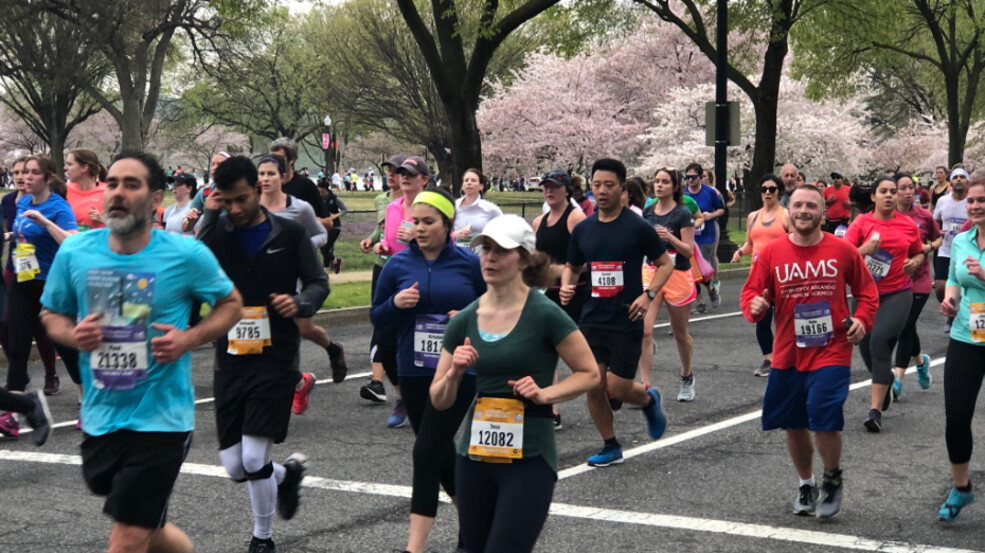
In the men’s race, the top-three finishers from 2022 return. All hailing from Kenya, they include champion Nicholas Kosimbei, second-place runner Wilfred Kimitei, and third-place finisher Shadrack Kimining. They’ll be joined on the starting line by second-place finisher in 2021 Abbabiya Simbassa from Flagstaff, AZ. Returning for the 50th running and starting a little bit farther back in the pack will be Bill Rodgers, from Boxborough, MA, who won the race four consecutive times between 1978 and 1981; placed second in 1982 and third in 1983; and has run CUCB a total of 22 times. Greg Meyer, whose American record of 46:13 still stands 40 years later, will be present for the 50th celebration, and will be holding the tape for the first American male finisher, who will be in hot pursuit of Greg’s mark — there’s a $50,000 shared bonus on the line for any American Records or World Bests set at the event.*
“It’s always a vote of confidence in the reputation of the event to see a large number of top finishers from previous years coming back. I am excited about this year’s set of repeaters, both past and present. This is another factor that will make our 50th anniversary special,” said Event Director Phil Stewart.
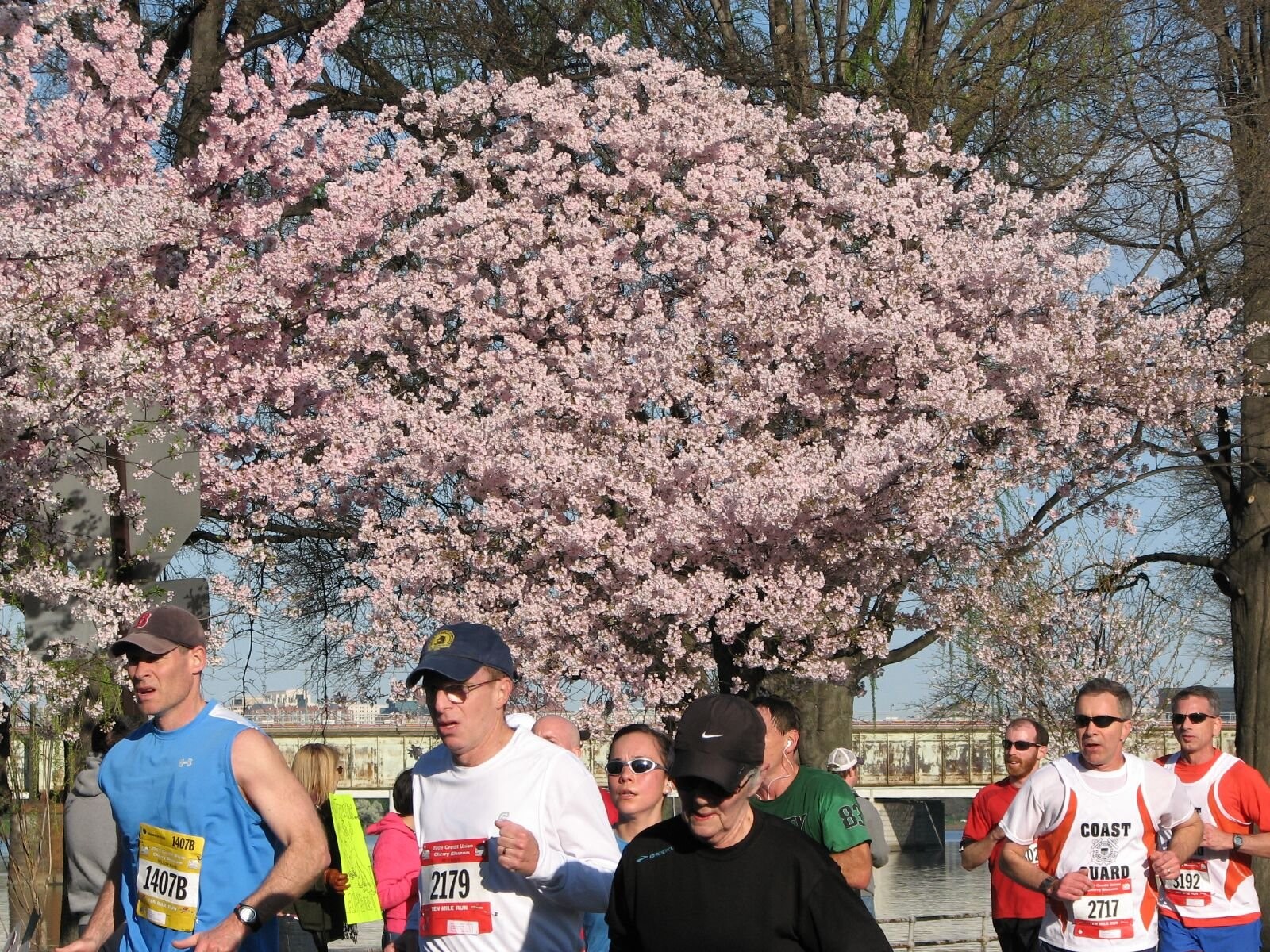
This year, international elite runners will be competing for $40,000 in prize money. The prize purse for Americans totals $25,000, and American runners placing in the top-10 overall are eligible to receive both open and American-only prize money. There is an additional $6,000 in RRCA RunPro Alumni Development Awards — runners eligible for the RRCA awards can also collect top-10 open and/or top-10 American payouts.
There is also a time-based set of bonus payments on offer for fast times:
• $50,000 to be shared by any runners setting a World Best or American Record*• Time incentives of $1,000 for the 1st male to run sub-46 minutes and 1st female to run sub-52 minutes, with an additional $750 on offer should a second male and/or female achieve those same sub-46 and sub-52 minute milestones.
The 10 Mile will serve as the USATF 10 Mile Championships, the RRCA National 10 Mile Championships, and the 2022-2023 Professional Road Racing Organization (PRRO) Circuit Championship.
Winners of the individual 2022-2023 PRRO Circuit events will be eligible for the $10,000 PRRO Super Bonus by winning the PRRO Championship (the bonus is split if an eligible male and female win the Championship). Susanna Sullivan and Nicholas Kosimbei are eligible for the PRRO Super Bonus. Any non-eligible winner of the PRRO Championship Super Bonus will earn $2500.
* If World Best times and American Records for men and women are set by the winners at the event (e.g. four records set), the $50,000 record bonus would be split into four $12,500 shares. If only one World or American record is set for either men or women, the athlete setting the record would get the full $50,000. If an American sets an American record and no other World or American records are set, he or she would receive the entire $50,000 as well. Currently, the times to beat are as follows:• Haile Gebreselassie’s (ETH) World Athletics Best of 44:24, run at the Tilburg 10 Mile in Tilburg, Netherlands, September 4, 2005;• Keira D’Amato’s World Athletics Best in a women’s only race of 51:23, run at the UpDawg 10 Mile in Washington, DC, November 24, 2020;• Greg Meyer’s American Record of 46:13, run at the Cherry Blossom 10 Mile in Washington, DC, March 27, 1983; and• Keira D’Amato’s previously mentioned World Best 51:23, which is also the American Record for a women’s only race.
For reference, the fastest CUCB time among the men’s field announced today is Kosimbei’s 45:15, which tied the event record set by Kenya’s Allan Kiprono in 2012. Among the elite women, Nell Rojas’s 52:13 from 2021 is the best CUCB finish time among this year’s elite entrants. Abbabiya Simbassa’s 46:18 from 2021 is the best CUCB mark among the American men, while Nell’s 52:13 is, of course, the leading mark among the American women.
The inaugural Cherry Blossom Ten Mile in 1973 was won by Sam Bair, in a time of 51:22; the women’s winner was Kathrine Switzer, in a time of 1:11:19; 127 men and 12 women ran that first race. Bill Rodgers holds the honor of most victories, with four consecutive wins between 1978 and 1981. Three women have each won the race three times: Julie Shea (1975-77), Lisa Weidenbach (1985, '89 and '90) and Lineth Chepkurui (2008-10). Ben Beach leads all Cherry Blossom finishers with an active streak of 49 years. A comprehensive media guide detailing a wide variety of statistics from the first 49 CUCB races is available here.
Thanks to Credit Union Miracle Day’s title sponsorship since 2002, the Credit Union Cherry Blossom Run has raised over $10.2 million for the Children’s Miracle Network Hospitals, including $323,000 in 2022.
About the Credit Union Cherry Blossom 10 Mile:
The Credit Union Cherry Blossom races, organized by Cherry Blossom, Inc., a 501c(3) chapter of the Road Runners Club of America, are known as “The Runner’s Rite of Spring®” in the Nation’s Capital. The staging area for Sunday’s 10 Mile is on the Washington Monument Grounds, and the course passes in sight of all of the major Washington, DC Memorials. In 2023, the reimagined Saturday 5K will stage on Freedom Plaza and traverse the route of Presidential Inaugurations down Pennsylvania Avenue before crossing the National Mall in the shadow of the Capitol Building and returning by the same route. The Kids Run is staged on the grounds of the National Building Museum. All events serve as a fundraiser for the Children’s Miracle Network Hospitals, a consortium of 170 premier children’s hospitals across North America. About one-third of the funds raised support Washington, DC’s own Children’s National (“Children’s Hospital”). The event also funds the Road Runners Club of America’s “Roads Scholar” program designed to support up-and-coming U.S. distance running talent.
Credit Union Miracle Day, Inc., a consortium of credit unions and credit union suppliers, is the title sponsor of the Credit Union Cherry Blossom 10 Mile, 5K, Kids Run and Virtual Run. Current presenting sponsors include ASICS, REI Co-op and Wegmans; supporting sponsors include CACI, Co-op Solutions, CUNA Mutual Group, FinisherPix, Gatorade Endurance, Guayaki, MedStar Health, PSCU, Potomac River Running, Suburban Solutions, The MO Apartments and UPS.
The 10 Mile is a proud member of the PRRO Circuit (PRRO.org), a series of this country’s classic non- marathon prize money road races with circuit stops in Washington, DC; Spokane, WA; and Utica, NY. The 2023 10 Mile will serve as the 2022-2023 PRRO Championship.
In addition to being sanctioned by USA Track & Field and the Road Runners Club of America, the Credit Union Cherry Blossom races have earned Gold Level Inspire Certification from the Council for Responsible Sport in recognition of its legacy of commitment to sustainability and thoughtful resource management.
To learn more, visit CherryBlossom.org and follow the event on social media @CUCB and #CUCB2023.
by David Monti
Login to leave a comment
Cherry Blossom Ten Mile Run
The Credit Union Cherry Blossom is known as "The Runner's Rite of Spring" in the Nation's Capital. The staging area for the event is on the Washington Monument Grounds, and the course passes in sight of all of the major Washington, DC Memorials. The event serves as a fundraiser for the Children's Miracle Network Hospitals, a consortium of 170 premier...
more...Documentaries every runner should watch
If you’re tired of wasting time scrolling through Netflix searching for the right movie or show to watch, we’ve got you covered. There are plenty of movies out there on running, but we’ve selected five of the best documentaries for you to watch. Before you get started on these films, though, be warned: sudden bursts of inspiration are highly likely while watching these flicks, so be ready to feel the need to go for a run after viewing.
The Barkley Marathons: The Race That Eats Its Young
This film was released in 2014, and it tells the story of the Barkley Marathons, race founder Laz Lake and the runners who dream of finishing the event. Producers followed the 2012 event, before which only 10 people had completed the Barkley Marathons, but that number is up to 15 today. The documentary brought this race into the mainstream, and although viewership was likely primarily runners, it captivated non-running audiences as well.
Boston: The Documentary
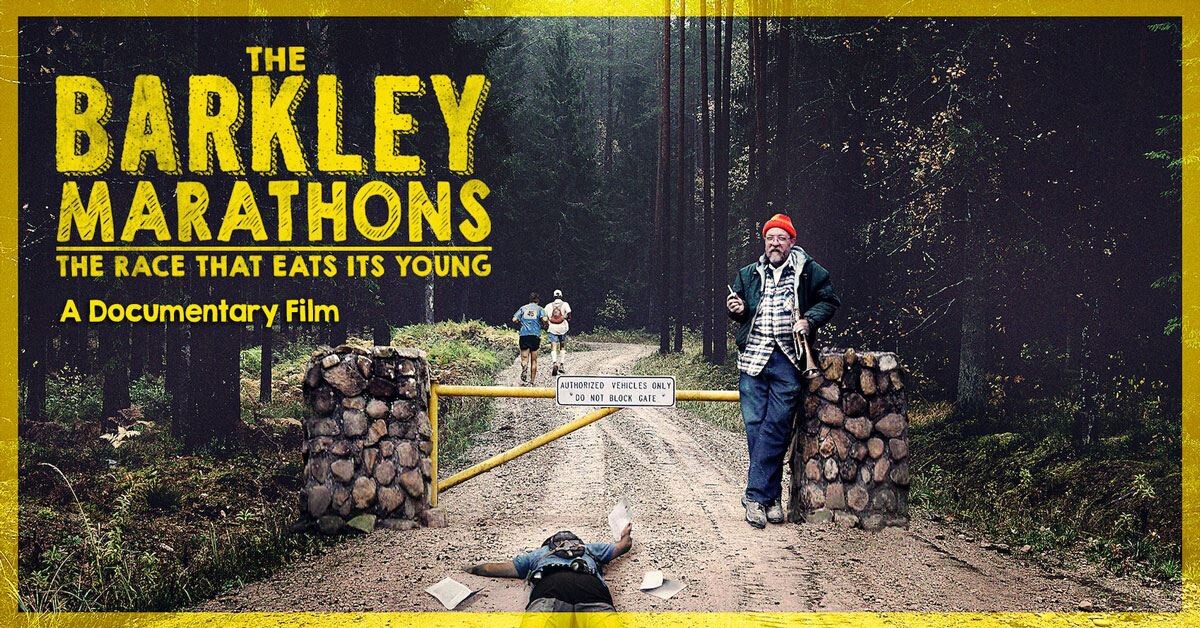
This 2017 documentary covers the history of the Boston Marathon, from its humble beginnings in 1897 right up to modern times. The film, which is narrated by Boston native Matt Damon, follows legends of the race (like the event’s first official female participant, Kathrine Switzer), 2014 winner Meb Keflezighi and four-time winner Bill Rodgers, as well as other past champions. In addition to the race’s history, the documentary looks to the future as organizers worked past the tragic events of 2013 and towards the Boston Marathons yet to come.
The Runner
In Oct. 2022, The New Yorker released a short, 17-minute documentary called The Runner that follows an Indigenous Canadian ultrarunner named Darius Sam. The film documents a 100-mile run in 2020 that Sam set out to complete to raise money and awareness for mental health. Since then, Sam has continued with ultrarunning, and in 2021 he became the youngest male to run the Moab 240, a behemoth of a race through Utah. Sam’s efforts have also led to a whopping $150,000 raised for mental health charities.
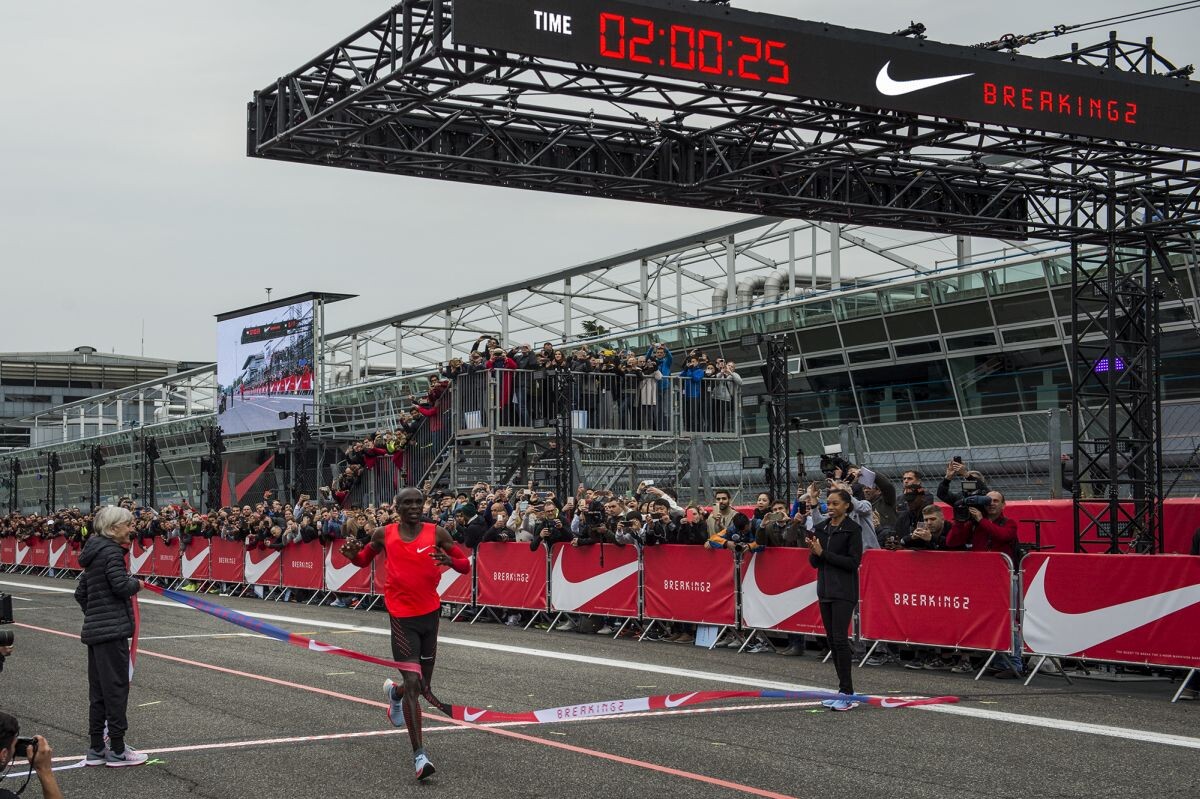
Breaking2
This documentary was produced by National Geographic and Nike, and it followed the build-up to the first-ever sub-two-hour marathon attempt, Nike’s Breaking2 project, in Italy in 2017. The film dives into the lives of the three Breaking2 athletes (Eliud Kipchoge, Zersenay Tadese and Lelisa Desisa), the months of planning that went into the attempt and the run itself. Although it ended up being unsuccessful (Kipchoge ran 2:00:25), it was still thrilling to watch, and the documentary is just as exciting.
Icarus
Although this Oscar-winning documentary is not a running-specific film, it should still be at the top of every runner’s must-watch list. The Netflix film intended to focus on doping and how difficult (or easy) it is to get away with cheating in elite sports, but it quickly turned into a story about doping in Russia, which ultimately led to the downfall of a years-long program that involved countless Russian athletes and sports officials.
by Ben Snider-McGrath
Login to leave a comment
Organizers of the 50th running of the Credit Union Cherry Blossom 10 Mile Run announced today that next year’s race will offer a $50,000 record bonus
$50,000 World and American Record bonus pool* and hosting PRRO and RRCA Championships are just a few of many highlights planned to commemorate 50 years of world class road racing in our Nation’s Capital.
October 7, 2022, Washington, DC: Organizers of the 50th running of the Credit Union Cherry Blossom 10 Mile Run (CUCB) announced today that next year’s race will offer a $50,000 record bonus, to be divided equally* among any man and woman setting a World Athletics World Best and/or American 10 mile record at The Runner’s Rite of Spring® on April 2, 2023.
The bonus payouts will be in addition to $69,000 in guaranteed prize money, with $44,000 paid to the top ten men and women in the international field and $25,000 to the top ten American men and women (double dipping allowed for the Americans). The race was one of the first U.S. events to pay prize money back at the dawn of the prize money era in 1984 when the total purse was $13,400, split evenly among the top men and women.
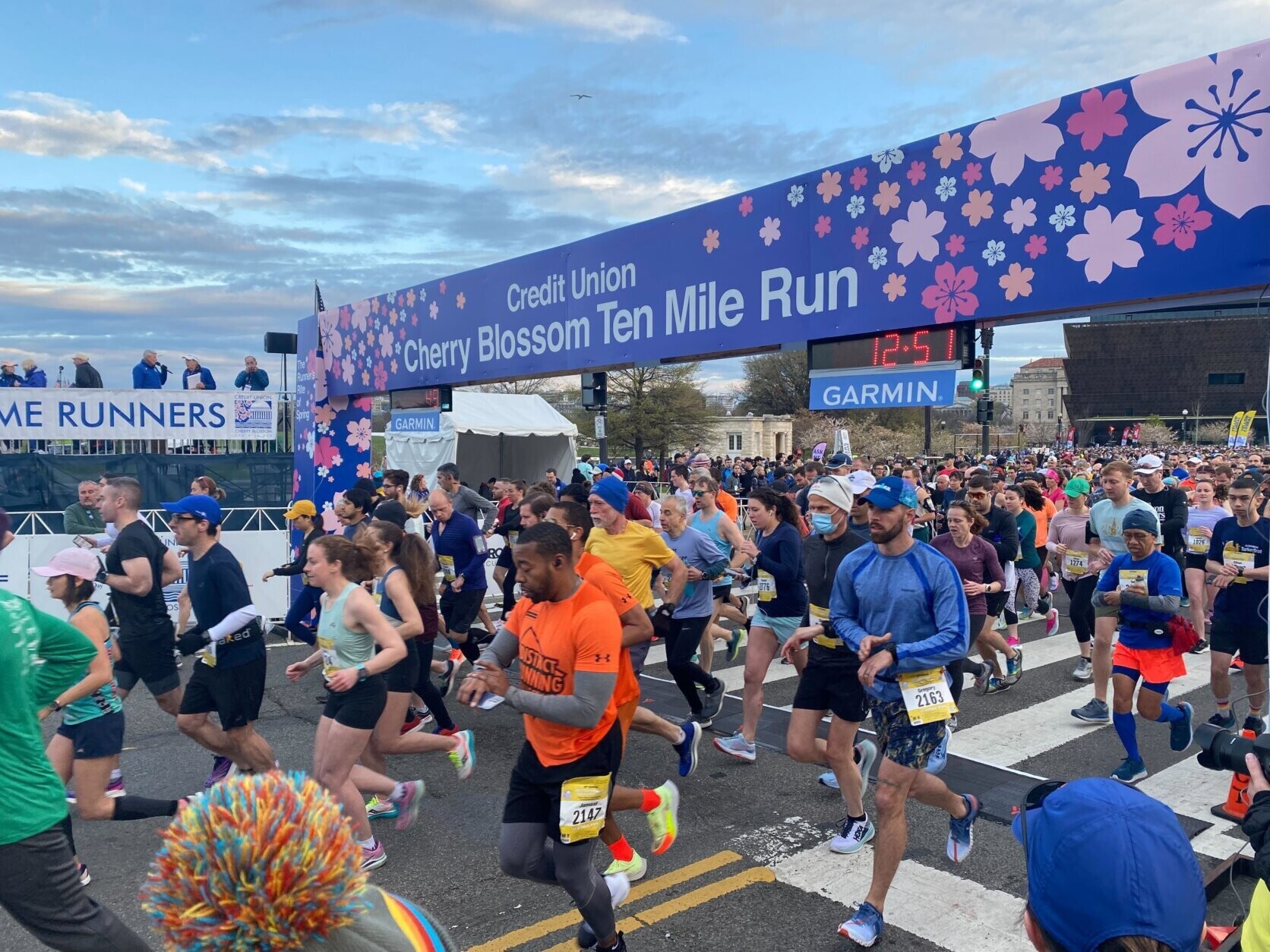
* If World Best times and American Records for men and women are set at the event (i.e. four records set), the $50,000 would be split into four $12,500 shares. If only one World or American record is set by either a man or a woman, the athlete setting the record would get the full $50,000. If an American sets both the World and American records, and no other records are set, he or she would receive $50,000.
Currently, the times to beat are as follows:* Haile Gebreselassie’s (ETH) World Athletics Best of 44:24, run at the Tilburg 10 Mile in Tilburg, Netherlands, September 4, 2005;* Keira D’Amato’s World Athletics Best in a women’s only race of 51:23, run at the UpDawg 10 Mile in Washington, DC, November 24, 2020;* Greg Meyer’s American Record of 46:13, run at the Cherry Blossom Ten Mile in Washington, DC, March 27, 1983;* Keira D'Amato’s previously listed World Best 51:23 is also the American Record for a women’s only race.
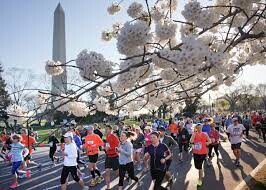
The 10 Mile will serve as the Road Runners Club of America National 10 Mile Championship and the 2022-2023 PRRO Circuit Championship. Winners of the 2022-2023 PRRO Circuit events will be eligible for the $10,000 PRRO Super Bonus by winning the PRRO Championship (the bonus is split if an eligible male and female win the Championship).
Event Director Phil Stewart said, “Our 50th anniversary will be like no previous edition of the race, with the largest prize pool of guaranteed and bonus money ever, and featuring the RRCA and PRRO Championships. The race has always been a leader in the support of elite competition and we want to highlight this heritage in a big way in this special year.”
The inaugural Cherry Blossom 10 Mile in 1973 was won by Sam Bair, in a time of 51:22; the women’s winner was Kathrine Switzer, in a time of 1:11:19; 127 men and 12 women ran that first race. Bill Rodgers holds the honor of most victories, with four consecutive wins between 1978 and 1981. Three women have each won the race three times: Julie Shea (1975-77), Lisa Weidenbach (1990-1992) and Lineth Chepkurui (2008-10). Ben Beach leads all Cherry Blossom finishers with an active streak of 49 years. A comprehensive media guide detailing a wide variety of statistics from the first 49 CUCB races is available here.
Other significant highlights of the 50th anniversary celebration will be announced in mid-October, including the procedures for entering the lottery for race registration and changes in the 5K.
Thanks to Credit Union Miracle Day’s title sponsorship since 2002, the Credit Union Cherry Blossom events have raised over $10.2 million for the Children’s Miracle Network Hospitals, including $323,000 in 2022.
About the Credit Union Cherry Blossom 10 Mile:
The Credit Union Cherry Blossom 10 Mile, organized by Cherry Blossom, Inc., a 501c(3) chapter of the Road Runners Club of America, is known as “The Runner’s Rite of Spring®” in the Nation’s Capital. The staging area for the event is on the Washington Monument Grounds and the course passes in sight of all of the major Washington, DC Memorials. The event serves as a fundraiser for the Children’s Miracle Network Hospitals, a consortium of 170 premier children’s hospitals across North America. About one-third of the funds raised support Washington, DC’s own Children’s National (“Children’s Hospital”). The event also funds the Road Runners Club of America’s “Roads Scholar” program designed to support up-and-coming U.S. distance running talent.
Credit Union Miracle Day, Inc., a consortium of credit unions and credit union suppliers, is the title sponsor of the Credit Union Cherry Blossom 10 Mile, 5K and Kids’ Run. Current presenting sponsors include ASICS, MedStar Health and Wegmans; supporting sponsors include CO-OP Financial Services, CUNA Mutual Group, PSCU, Potomac River Running, Gatorade Endurance, Suburban Solutions and UPS.
The event is a proud member of the PRRO Circuit (PRRO.org), a series of this country’s classic non- marathon prize money road races with circuit stops in Washington, DC; Spokane, WA; and Utica, NY.
In addition to being sanctioned by USA Track & Field and the Road Runners Club of America, the Credit Union Cherry Blossom events have earned Gold Level Inspire Certification from the Council for Responsible Sport in recognition of its legacy of commitment to sustainability and thoughtful resource management.
by Runners Web
Login to leave a comment
Cherry Blossom Ten Mile Run
The Credit Union Cherry Blossom is known as "The Runner's Rite of Spring" in the Nation's Capital. The staging area for the event is on the Washington Monument Grounds, and the course passes in sight of all of the major Washington, DC Memorials. The event serves as a fundraiser for the Children's Miracle Network Hospitals, a consortium of 170 premier...
more...Some running quotes to inspire you
It can be hard to maintain your zest for running when the temperatures soar.
We dug up some running wisdom from some great athletes and minds to get you out the door. When your workout motivation wanes in the face of weather or whatever comes your way, read a few lines and consider it your calling to rise up and run.
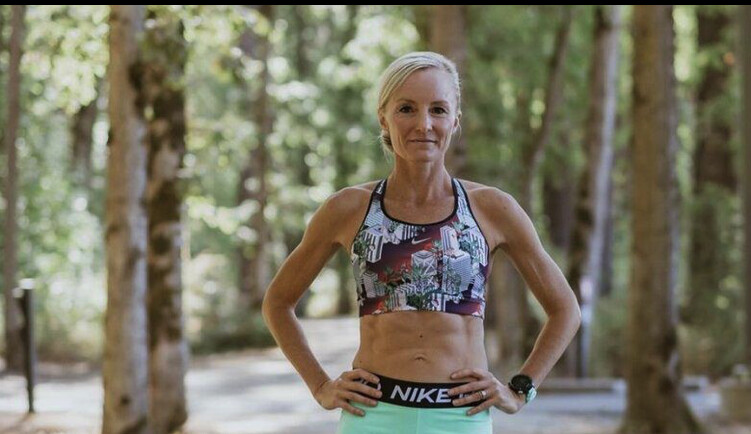
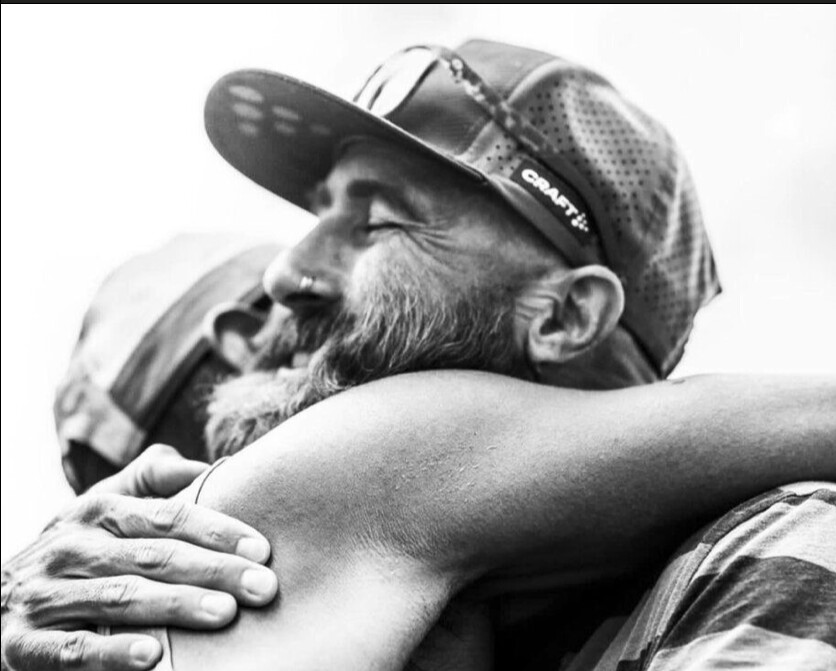
You are a runner, no matter your distance, pace or natural ability
“All runners are tough. Everyone has to have a little fire in them, that even in tough times, can’t be turned off.”
— Shalane Flanagan
“If one could run without getting tired I don’t think one would often want to do anything else.”
– C. S. Lewis
“To give anything less than your best is to sacrifice the gift.”
–Steve Prefontaine
“I just wanted to come out today and, I don’t know, get up in it, stick my nose where it didn’t belong, and just see what I could come away with. I guess that’s a medal.”
–Molly Seidel
“The advice I have for beginners is the same philosophy that I have for runners of all levels of experience and ability: consistency, a sane approach, moderation, and making your running an enjoyable, rather than dreaded, part of your life.”
— Bill Rodgers
Remember why you do it
“Why do we do this? To feel something. To move ourselves, to ensure that we don’t get stuck. And most of all, we do this to be a part of something. To insert our individual effort into a sea of human energy and force out the other side, hopeful that somehow we’ll be different. Changed in some way.”
–Peter Bromka
“Because during every run, for a few seconds or a few minutes, you have a moment where it feels really good. You forget about the discomfort and you find rhythm, maybe some grace, and a feeling of strength and confidence as you move as well as you’ll ever move doing anything. And that’s one of the best reasons to run.”
― Brendan Leonard
“Keep moving. You’re still here. We all are. As long as you’re moving you’re still here.”
–Tommy Rivers Puzey
“…For me there has always been a place to go and a terrible urgency to get there.”
—Joan Benoit Samuelson
“The reason we race isn’t so much to beat each other… but to be with each other.”
–Christopher McDougall
Login to leave a comment
Running motivation: running quotes to inspire you
It can be hard to maintain your zest for running when the temperatures soar.
We dug up some running wisdom from some great athletes and minds to get you out the door. When your workout motivation wanes in the face of weather or whatever comes your way, read a few lines and consider it your calling to rise up and run.
You are a runner, no matter your distance, pace or natural ability
"Love hard. Live hard. Keep moving forward" –Tommy Rivers Puzey
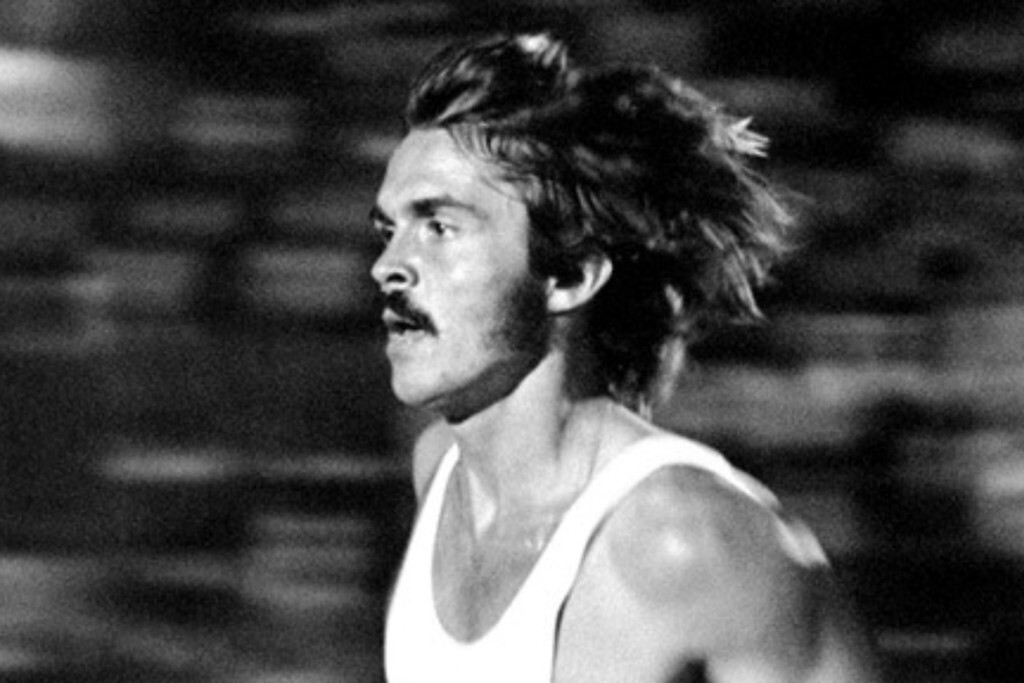
“All runners are tough. Everyone has to have a little fire in them, that even in tough times, can’t be turned off.” — Shalane Flanagan
“If one could run without getting tired I don’t think one would often want to do anything else.” – C. S. Lewis
“To give anything less than your best is to sacrifice the gift.” –Steve Prefontaine
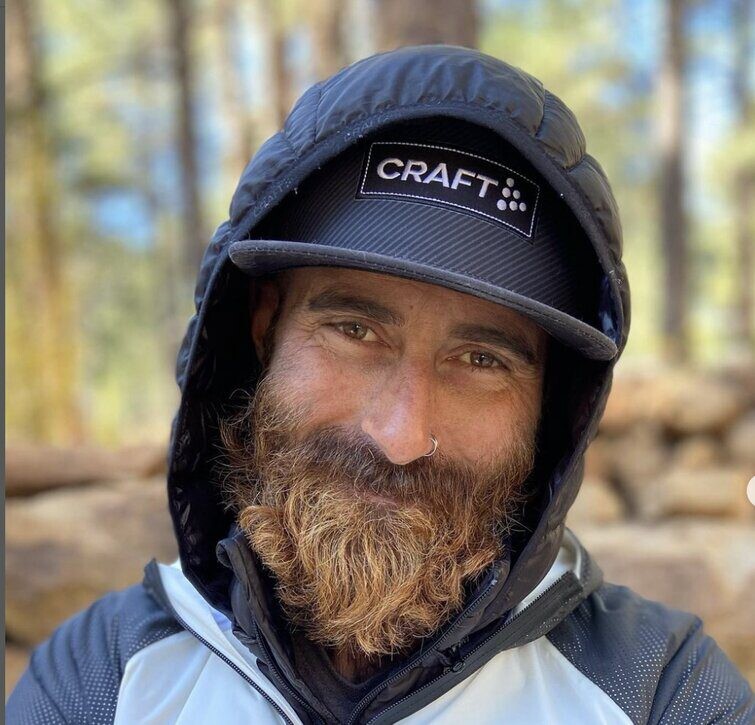
“I just wanted to come out today and, I don’t know, get up in it, stick my nose where it didn’t belong, and just see what I could come away with. I guess that’s a medal.” –Molly Seidel
“The advice I have for beginners is the same philosophy that I have for runners of all levels of experience and ability: consistency, a sane approach, moderation, and making your running an enjoyable, rather than dreaded, part of your life.” — Bill Rodgers
Remember why you do it
“Why do we do this? To feel something. To move ourselves, to ensure that we don’t get stuck. And most of all, we do this to be a part of something. To insert our individual effort into a sea of human energy and force out the other side, hopeful that somehow we’ll be different. Changed in some way.” –Peter Bromka
“Because during every run, for a few seconds or a few minutes, you have a moment where it feels really good. You forget about the discomfort and you find rhythm, maybe some grace, and a feeling of strength and confidence as you move as well as you’ll ever move doing anything. And that’s one of the best reasons to run.” ― Brendan Leonard
“Keep moving. You’re still here. We all are. As long as you’re moving you’re still here.” –Tommy Rivers Puzey
“…For me there has always been a place to go and a terrible urgency to get there.” —Joan Benoit Samuelson
“The reason we race isn’t so much to beat each other… but to be with each other.” –Christopher McDougall
by Keeley Milne
Login to leave a comment
Coach Bill Squires who coached runners like Bill Rodgers has died
The Boston Athletic Association mourns the passing of the legendary coach and athlete Bill Squires, who died today, Thursday, June 30. This is an immense loss for our running community.
William Squires was born November 24, 1932 and was an American track and field coach. He is well known for coaching the Greater Boston Track Club at the height of its marathon success, including marathoners Bill Rodgers, Alberto Salazar, Dick Beardsley and Greg Meyer.
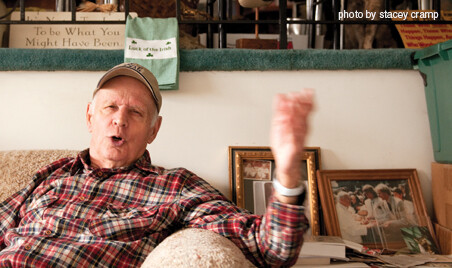
Squires was originally from Arlington, Massachusetts and competed in track and field events for Arlington High School. While a senior there, Squires was chosen as a member of the 1952 Parade All-American team. Squires went on to college at Notre Dame, where he was a two-time All-America in cross-country in 1954 and 1955.
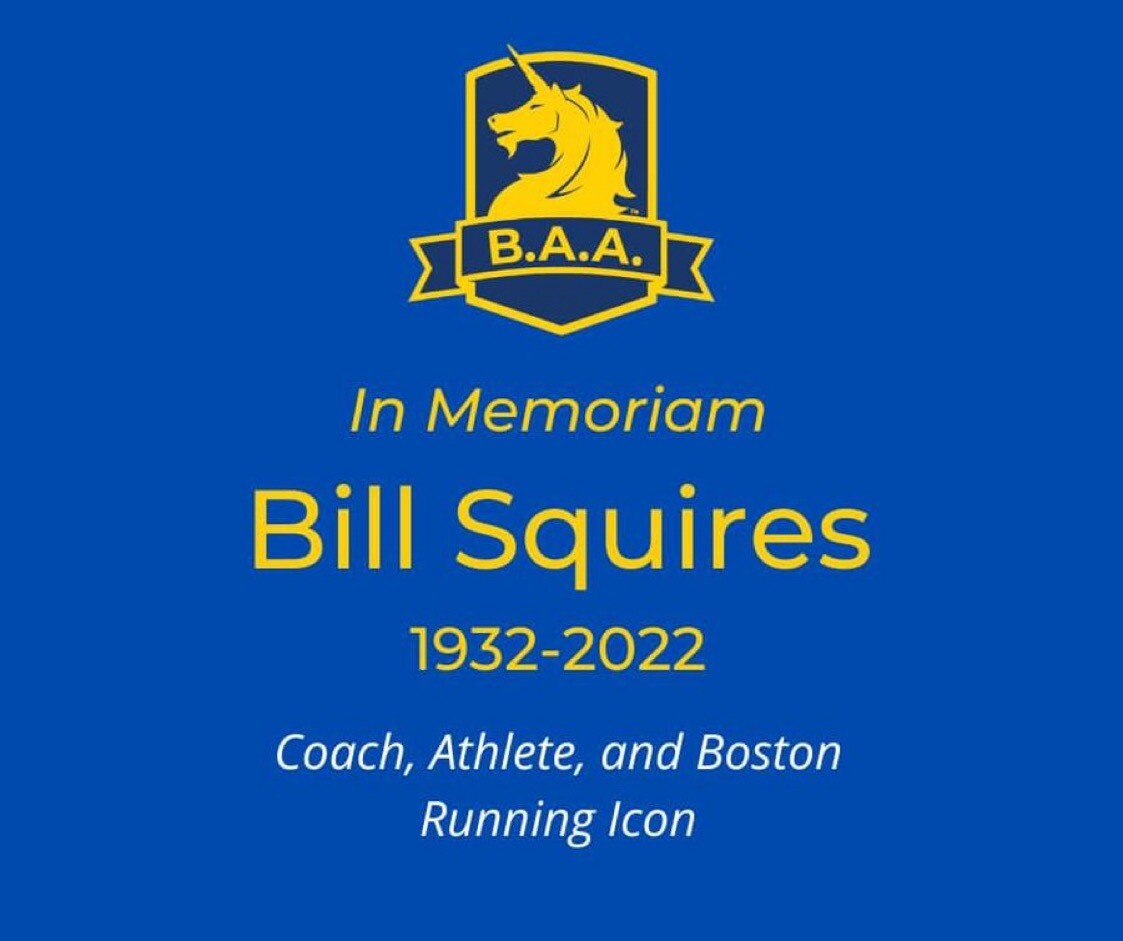
Squires's personal bests according to the MSTCA hall-of-fame induction were 4:21 for the mile in high school and 4:07 in college. He was notable for designing a Heartbreak Hill simulator for training. He was formerly a coach at Boston State College from 1965 to 1978.
In 2002 Squires received the Bill Bowerman award from the National Distance Running Hall of Fame. Squires co-authored the book "Speed with Endurance" with Bruce Lehane.
"Bill Squires was a speaker at our National Running Week in the early 1980's," says MBR publisher Bob Anerson. "He shared his knowledge and we were very impressed. He will be missed."
Login to leave a comment
How to make a running mantra, for when you need a little motivational self-talk to get you to the finish line
Running is as much mental as it is physical. When you reach the inevitable part in a workout or race when your body wants to give up, it’s your mind that gets you to the end. Developing mental strength is no easy task, and requires constant work to maintain.
Creating a running mantra can help silence negative thoughts and encourage you to push through tough spots, but not just any random combination of words will do. Not sure how to create a mantra of your own? We’re here to help.
Why do mantras work?
It’s very easy for negative thoughts to creep in when you’re completing a hard workout or running a race. As you start to fatigue, thoughts telling you you’re too tired, you’re not good enough, you won’t reach your goal or that you should quit can get louder and louder to the point where it’s difficult to hear anything else. That’s when a mantra comes to your rescue. Having a mantra ready and waiting for when you need it most requires very little thinking or mental energy, but repeating it can drown out the negative thoughts going on in your head.
In fact, a 2017 study found runners who were completing a 60-mile (95Km) overnight race reported that using a mantra was helpful both in training and racing, and continued to use their mantras even after the study was complete.

The anatomy of a good mantra
A mantra can be whatever you want it to be, but there are a few things to keep in mind if you want it to be effective. Use these guidelines to create your own personalized motivational mantra:
It should be short. You want your mantra to be easy to remember and easy to repeat, so a long-winded phrase is not a great option here. Usually one or two affirmative words that bolster your confidence is all you need.
Use your struggles as inspiration. Do you lack confidence in yourself in the later stages of a race? Do you get stressed or begin to panic when it starts to get difficult? These are the things you want your mantra to address. If you lack confidence, a simple phrase like “I am strong” or “I can do hard things” can remind you what you’re capable of. If you start to feel stressed during the race, something like “stay calm, stay relaxed” could be exactly what you need to turn those feelings around.
Remind yourself why you’re doing this in the first place. When you get to the hard part of a run, workout or race, you might find yourself asking why you do this at all. In this case, you could use your mantra to remind you why you’re out putting one foot in front of the other. For example, “I’m loving this challenge,” or even simple, “I am a runner,” can remind you that you love the sport, and turn it around in your mind to be a fun experience.
Examples of elite mantras

If you’re having trouble figuring out a mantra that resonates with you, take inspiration from one of these elite runners instead:
Shalane Flanagan: Run without any regrets
Kara Goucher: Fighter
Deena Kastor: Go Faster. Push Harder. Today, Define Yourself.
Bill Rodgers: Relentless
It may take some trial and error for you to find a mantra that works for you. Start practicing them in your harder workouts and runs so that by the time race day arrives, you’re armed with the words to get you to the finish line.
by Brittany Hambleton
Login to leave a comment
Canadian releases Fukuoka Marathon documentary
Brett Larner of the Japan Running News website released his documentary on the iconic Fukuoka International Marathon, which saw its final running (open to locals only) on Dec. 6. Inside the Outside: When the World Came to Fukuoka tells the story of the non-Japanese runners, who, over the race’s long history, turned it into the unofficial world men’s marathon championship.
The film, which is introduced by Larner (and which he produced), does not focus on the 24 Japanese athletes who pushed each other to victory at Fukuoka over the race’s 75-year history, but on the foreigners who came to race there, giving the race an international profile and contributing significantly to its mystique. (Larner himself ran it in 2007 – the year that Sammy Wanjiru of Kenya, who would go on to win Olympic gold the following year, set a course record in his marathon debut.)

The first outsider to be interviewed is Pavel Kantorek of the former Czechoslovakia, who won Fukuoka in 1961. He raced there six times in all and never performed worse than fifth; he also ran in the Olympic marathon in 1956, 1960 and 1964. Kantorek, who was married at the time, comments that he kept getting invited to return because of his exemplary behaviour, unlike some of the runners, who were “more interested in the Japanese geisha than in racing.”
Other notable athletes interviewed include Amby Burfoot, who won the Boston Marathon in 1968 and was fifth at Fukuoka the same year, finishing just shy of the American record; double Olympic medallist Frank Shorter, who won Fukuoka every year from 1971 to 1974, who says “Fukuoka is where I was born as a marathon runner”; and Canada’s own Jerome Drayton, a two-time Olympian who won the Boston Marathon in 1977 and the Fukuoka Marathon in 1969, 1975 and 1976 (and his 1975 winning time, 2:10:09, was the Canadian marathon record for 43 years). Four-time Boston Marathon and NYC Marathon champion Bill Rodgers, who ran in the 1976 Olympics, won Fukuoka in 1977 and was third in 1975.
For many of the early Fukuoka runners, it was the first time they’d been invited to compete at an international marathon, and it became very prestigious on that basis. The meaning the race holds for them is obvious in their words, many of which were delivered via iPhone, thanks to the constraints of pandemic-style filmmaking. Fans of the marathon’s history will find a great deal of value in the film.
by Running magazine
Login to leave a comment
Next up is the Boston Marathon and here is everything you need to know
Wow, so many big time marathons being held over just a few weeks. Next up is the Boston Marathon.
This year’s race on October 11 will be the first fall edition of the Boston Marathon, and first time the race is held outside of its traditional Patriots’ Day date in April. Due to the coronavirus pandemic, the race was postponed from its usual third-Monday-in-April date to October 11. This will be the first in-person Boston Marathon in 910 days, as the 2020 edition was held as a virtual experience in September, 2020. This year’s race falls on October 11, which is International Day of the Girl and also increasingly recognized as Indigenous Peoples’ Day in cities and towns along the marathon route.
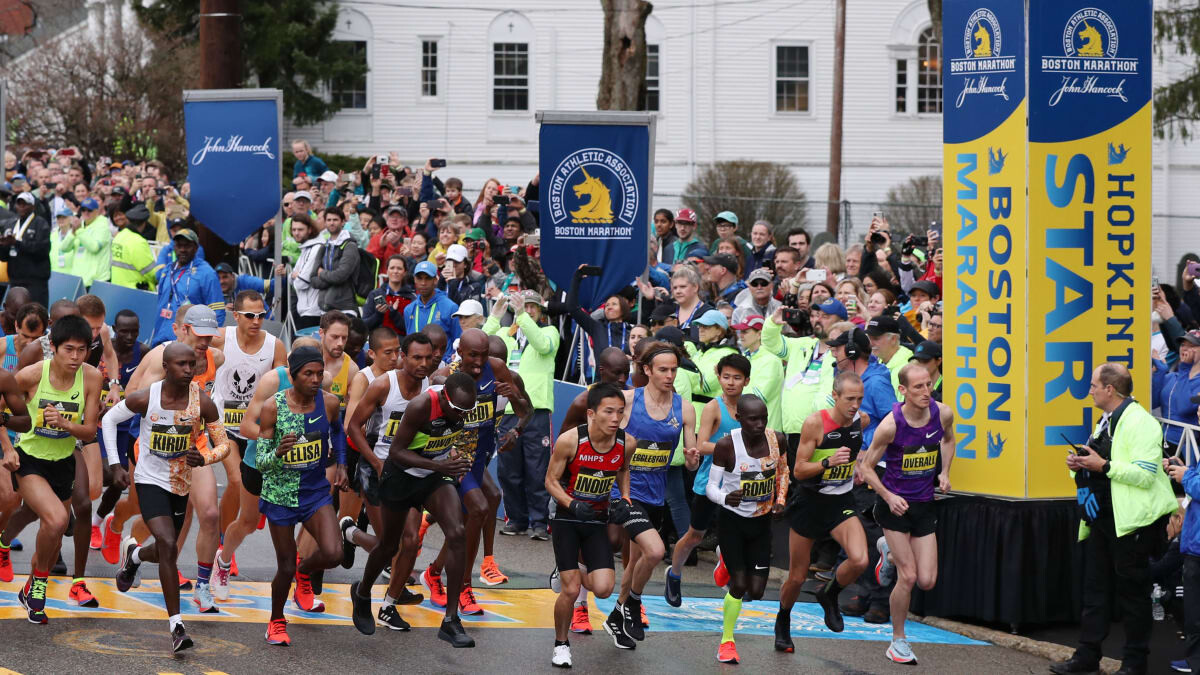
Here is everything you need to know:
COMPOSITION OF THE FIELD
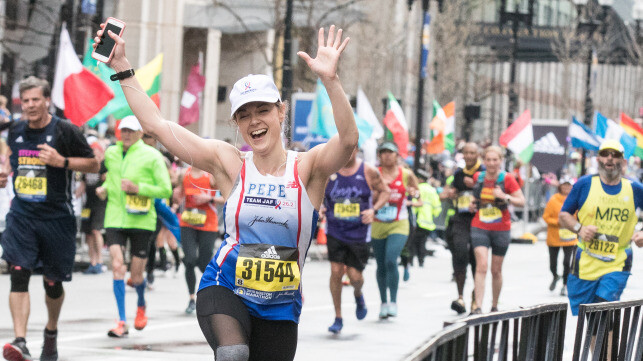
18,252 total entrants of the in-person 125th Boston Marathon
3,492 entrants from Massachusetts
16,441 entrants residing in the United States of America
104 countries represented by participants in the Boston Marathon
All 50 U.S. states represented by participants in the Boston Marathon
Youngest entrants: 18 years old, Enchee Xu, Conor Beswick, Rachel Calderone, and Angel Robles, all of Massachusetts
Oldest entrant: 84 years old, Volkert Bobeldijk of Canada
28,612 total entrants of the Virtual 125th Boston Marathon (October 8-10)
HEALTH & SAFETY
This year’s field size has been reduced by 36% compared to recent years (from 31,500 entrants to 20,000)
In an effort to enhance social distancing and minimize wait times, Athletes’ Village has been eliminated in Hopkinton this year and a rolling start has been introduced for the first time in race history.
95% of all Boston Marathon volunteers are vaccinated.
100% of Boston Marathon medical volunteers are vaccinated.
All participants are required to provide proof of a WHO-recognized vaccination OR a produce a negative COVID-19 test within 72 hours of bus loading.
A health and safety bracelet will be provided after proof of vaccination or negative COVID-19 test results are verified. The bracelet must be worn throughout race weekend and through the finish line.
Masks are required indoors, on event transportation, and within the start area until participants cross the starting line.
BY THE NUMBERS
$876,500 in prize money will be awarded to top finishers by principal sponsor John Hancock. Included among the prize awards is $27,500 for Para Athletes.
8,500 B.A.A. volunteers will contribute to this year’s Boston Marathon and race related events
26.2 miles (26 miles and 385 yards; 42.195 kilometers) will be run through eight cities and towns (Hopkinton, Ashland, Framingham, Natick, Wellesley, Newton, Brookline, and Boston)
An estimated $20 million (USD) will be raised through the 125th Boston Marathon for charities as part of the B.A.A.’s Boston Marathon Official Charity Program and the John Hancock Non-Profit Program
FACES IN THE FIELD
13 Boston Marathon champions will be competing as part of the John Hancock Professional Athlete Team: Des Linden (USA/MI), Geoffrey Kirui (KEN), Edna Kiplagat (KEN), Lemi Berhanu (ETH), Lelisa Desisa (ETH), Atsede Baysa (ETH), Caroline Rotich (KEN), Daniel Romanchuk (USA/IL/Won the Chicago Marathon on Sunday), Manuela Schär (SUI), Marcel Hug (SUI), Tatyana McFadden (USA/MD/Won the Chicago Marathon on Sunday), Ernst van Dyk (RSA), and Joshua Cassidy (CAN). Additionally, 1968 winner Amby Burfoot will be running and serving as an official starter in Hopkinton.
Five 2020 Tokyo Paralympic gold medalists will be competing in Boston: reigning men’s wheelchair champion Daniel Romanchuk (gold in the 400m); two-time Boston winner and wheelchair course record holder Marcel Hug (800m, 1500m, 5000m, marathon); reigning women’s wheelchair champion and course record holder Manuela Schär (400m, 800m); five-time winner Tatyana McFadden (4x100m Universal Relay); and Japan’s Misato Michishita (T12 marathon).
Danica Patrick, NASCAR and Indy Car driver, will run for the Matt Light Foundation
James Develin, former New England Patriots fullback and Super Bowl champion, will run as part of the Joe Andruzzi Foundation
Chris Nikic, the ESPY-award winning Ironman triathlete who in 2020 became the first person with Down syndrome to finish an Ironman triathlon, will race his first Boston Marathon.
Brian d’Arcy James, Broadway star in Shrek the Musical and Hamilton and actor in Spotlight, will race his first Boston Marathon.
Ceremonial 125th Boston Marathon Grand Marshals include Boston Marathon champions Sara Mae Berman, Bill Rodgers, Joan Benoit Samuelson, Jack Fultz, and Meb Keflezighi, as well as healthcare workers from members of the Boston Marathon Official Charity Program and John Hancock Non-Profit Program. Frontline workers being honored include Meg Femino of Beth Israel Lahey Health; Martha Kaniaru of Spaulding Rehabilitation; Loren Aiello of Boston Children’s Hospital; Eric Goralnick of Brigham and Women’s Hospital; Christopher S. Lathan of Dana-Farber Cancer Institute; Mark Mullins of Tufts Medical Center; Anely Lopes of Boston Medical Center; and Susan Wilcox of Massachusetts General Hospital. The Grand Marshals will be driven the entire 26.2 miles in two Boston DUCK Boats, Back Bay Bertha and Catie Copley.
by BAA
Login to leave a comment
Boston Marathon
Among the nation’s oldest athletic clubs, the B.A.A. was established in 1887, and, in 1896, more than half of the U.S. Olympic Team at the first modern games was composed of B.A.A. club members. The Olympic Games provided the inspiration for the first Boston Marathon, which culminated the B.A.A. Games on April 19, 1897. John J. McDermott emerged from a...
more...Asics The New Title Sponsor of Falmouth Road Race
ASICS has committed to a multi-year title sponsorship of the Falmouth Road Race, one of America's most iconic summer running events. The 7-mile road race, held each August on a coastal route from Woods Hole to Falmouth Heights on Cape Cod, had New Balance as its title sponsor from 2011 through 2019. The event was not held as an in-person road race in 2020 due to the pandemic.
"This partnership represents so much more than a sponsorship," explained ASICS Fitness Apps' general manager Alex Vander Hoeven through a statement. "It is a true example of how a world class event such as the Falmouth Road Race can collaborate with ASICS's global suite of products and digital services. We look forward to being on the course come race day and are honored to be part of the greater Falmouth Road Race community."
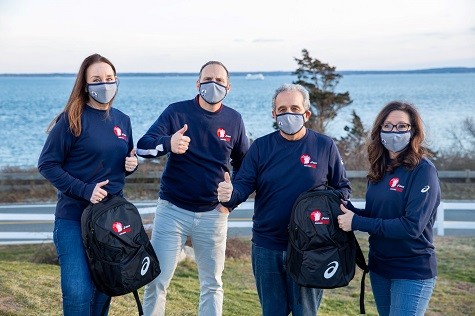
The Falmouth Road Race was founded in 1973 by the late Tommy Leonard, a bartender at the old Eliot Lounge in Boston. About 100 runners started that year in front of the Captain Kidd restaurant in Woods Hole and finished at old the Brothers 4 club in Falmouth Heights adjacent to Falmouth Heights Beach. Organizers use the same course today.
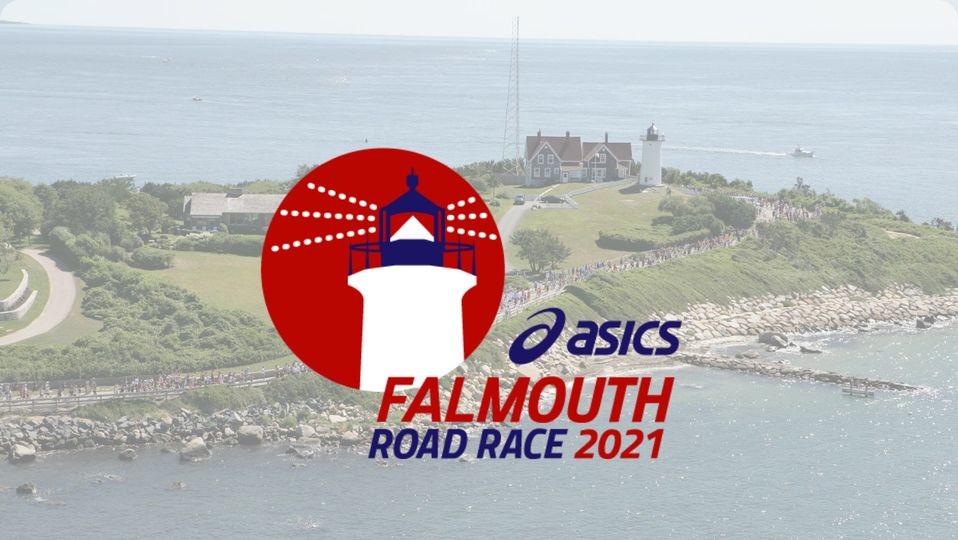
Some of the greatest distance runners in history have won the Falmouth Road Race including Khalid Khannouchi, Catherine Ndereba, Lynn Jennings, Benson Masya, Joan Samuelson, Bill Rodgers, Frank Shorter, and Grete Waitz. The 2019 champions were Leonard Korir of Colorado Springs, Colo., and Sharon Lokedi of Kenya. The 2019 race had 11,534 finishers.
"Our partnership is new, but we have long played host to ASICS athletes who have added much to our events," added Scott Ghelfi, president of the Falmouth Road Race, Inc., board of directors. "We look forward to having ASICS as a title partner that shares our commitment to health, wellness, and giving back to our community."
The 2021 ASICS Falmouth Road Race is scheduled for Sunday, August 15, pending approval from the Town of Falmouth.
by David Monti
Login to leave a comment
Falmouth Road Race
The Falmouth Road Race was established in 1973 and has become one of the premier running events of the summer season. Each year the race draws an international field of Olympians, elite runners and recreational runners out to enjoy the scenic 7-mile seaside course. The non-profit Falmouth Road Race organization is dedicated to promoting health and fitness for all in...
more...The Runner Statue-COVID-19 Mask Movement
Over the weekend, famous runner statues from Boston to Boulder donned a new look to support solidarity in slowing the coronavirus.
Runners are among the healthiest people. We prize and appreciate our good fortune, and want to encourage the same in others. We’d like everyone to be health—to follow federal guidelines, both for exercise and for disease prevention.
That was the thinking behind the Runner Statue-COVID-19 Mask movement. It began Saturday morning in Mystic, CT. By Sunday afternoon, it had spread to Cape Elizabeth, Maine, Hopkinton, Massachusetts, Central Park in New York City, Davenport, Iowa, and Boulder, Colorado.
In each location, a well-known runner statue is now wearing a low-tech protective face mask. The message: Do your part to prevent the spread of COVID-19.
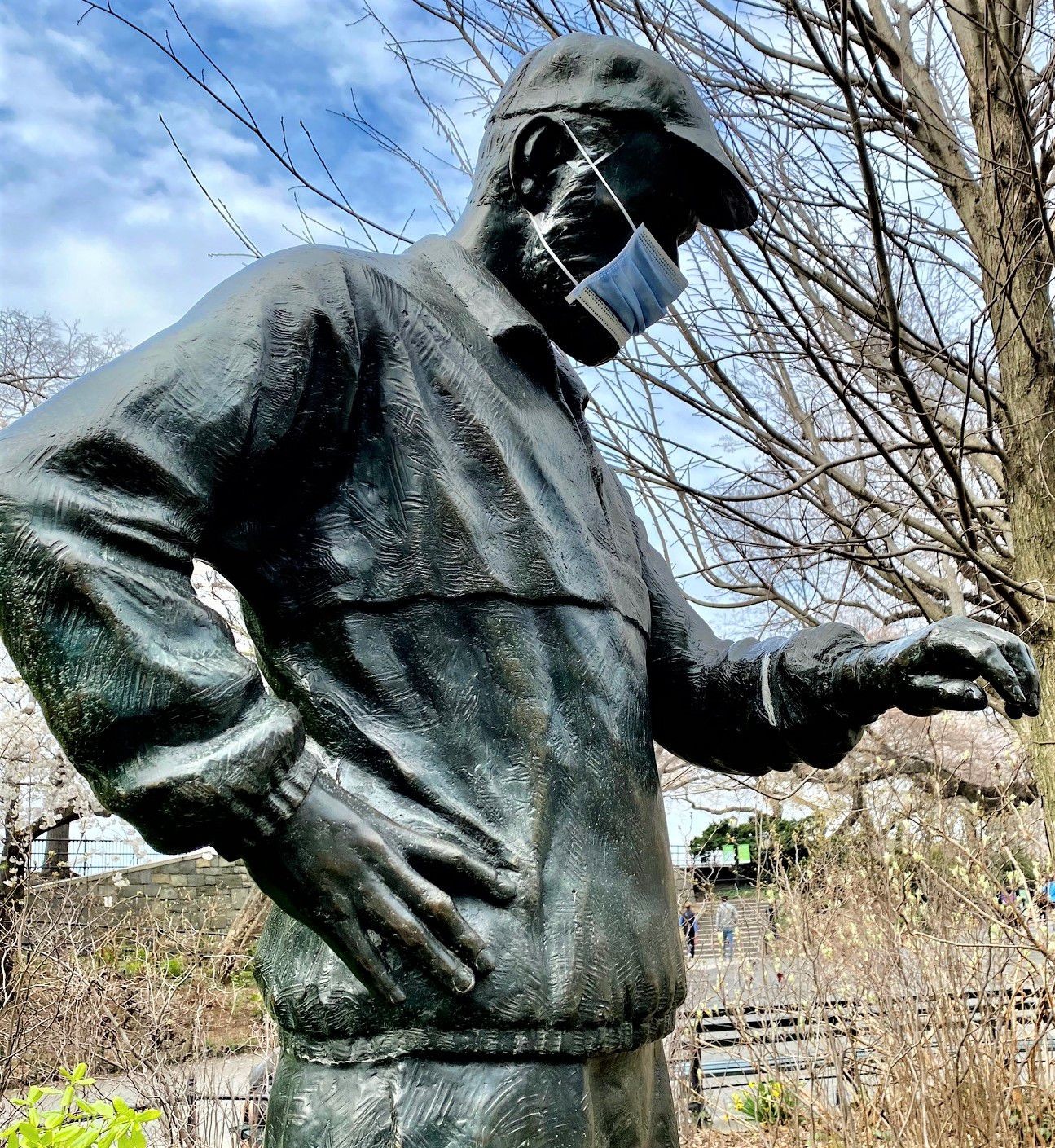
The Boston Marathon course has three such mask-wearing statues. In Hopkinton, “The Starter” George V. Brown wears a mask immediately adjacent to the Boston Marathon start line. Nearby, the statue of Rick and Dick Hoyt shows off their colorful masks.
Near the Marathon’s 19-mile mark in Newton, the double statue of “Old John” Kelley and his younger self shows them both wearing bandanna masks. These were fashioned by Ray Charbonneau from recycled road race t-shirts.
Born on a Morning Run
The story starts, like many, with a morning run. On Saturday morning, my wife, Cristina, and I met my brother, Gary, for an easy 3-mile jog on the banks of the meandering Mystic River in Connecticut. We had barely begun when Gary said, “You know what might be cool—to put a COVID mask on the Kelley statue.”
Mystics’s statue of John J. Kelley, 1957 Boston Marathon winner, has been a favorite local landmark for about five years now. It has a sparkling location in a tiny parklet that overlooks Mystic Pizza, made famous by the 1988 Julia Roberts movie. Before our biggest annual road races, Kelley is often attired in that’s year’s t-shirt.
Gary’s idea seemed so perfect that Cristina and I rushed home post-run to complete the mask project. To be honest, I merely “supervised,” since I have no sewing or crafting skills. Fortunately, Cristina is one of those creative types. She was even smart enough to realize that a statue mask would have to be larger than the bright masks she had already turned out for family members. Most statues are literally larger than life.
We rushed back to downtown Mystic to give Kel’ his new facemask. It was made of green shamrock material to honor his Irish roots. No one asked what we were doing, though several families strolled by and gave us an enthusiastic “thumbs up.”
Back home a few minutes later, I was ready for a nap. Then it hit me. I knew of a half-dozen other runner statues, and I knew runners who lived in those communities. What if I could get all those statues to wear covid masks?
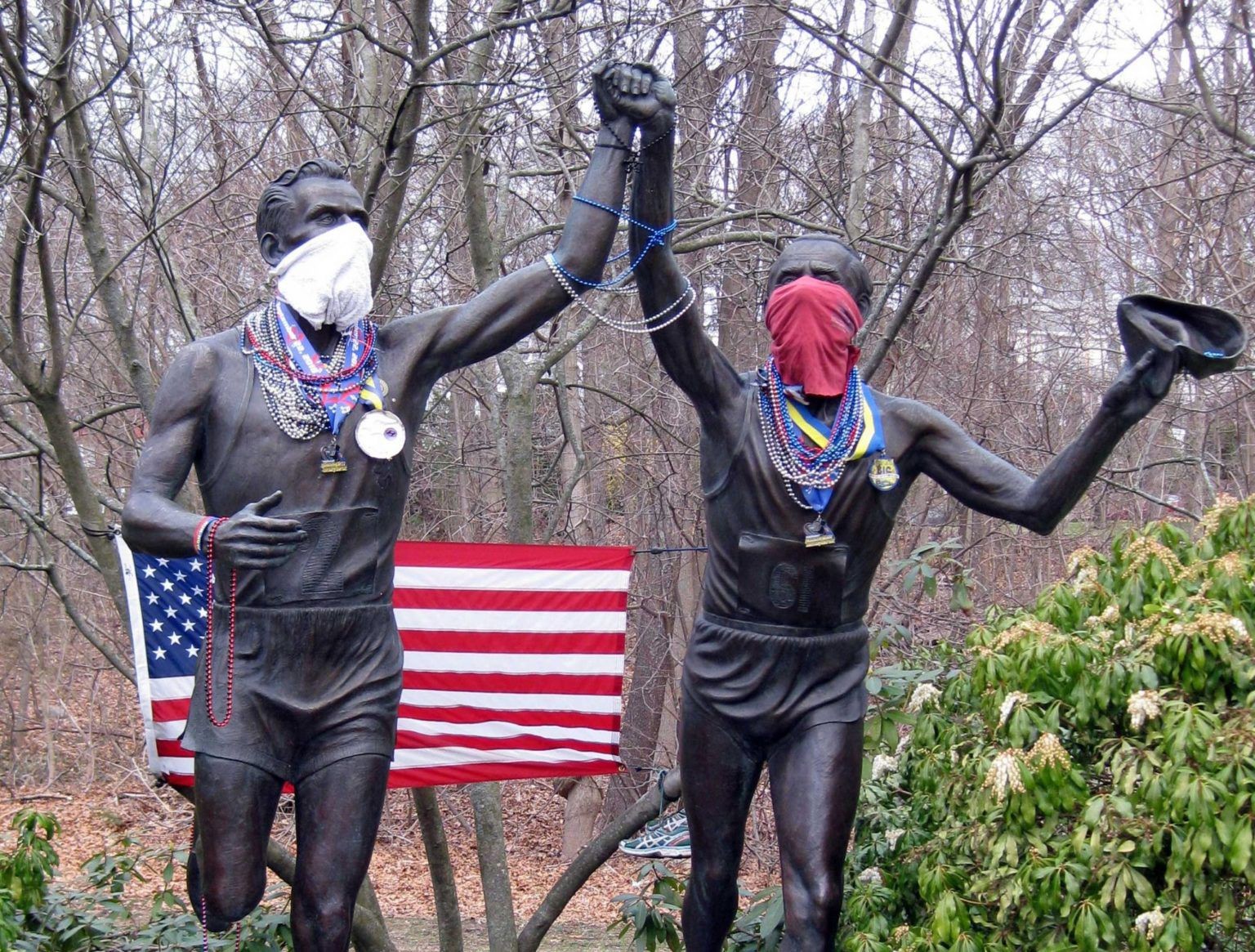
Idea Runs Across the Country
Honestly, it took little effort on my part. A handful of friends, both new and old, “ran” with the suggestion. In Central Park and Cape Elizabeth, police quickly descended on my mask-placing co-conspirators. Moments later, having heard an explanation for the masks, the very same officers volunteered to help.
My buddy in Cape Elizabeth needed it. Marty Clark was struggling on crutches to give Joan Benoit Samuelson a facelift. Now we’ll let you in on one of Joanie’s secrets: She has no ears. (Makes you more aerodynamic.) Or maybe she just has hair over her ears. In both Cape Elizabeth and Davenport, IA, where the Bix-7 has erected statues of Samuelson and Bill Rodgers, my friends had trouble keeping the mask in place.
But Bix race director Michelle Juehring persisted until she achieved success. “I love the solidarity of this project—the way it says we’re all in this together,” she observed.
Rodgers was a big fan from the get-go. “I’m so glad to be wearing a mask next to Joan Samuelson in Davenport,” he said. “If others see us, and then they wear a mask also, we’re going to beat this disease in America.
At Central Park’s reservoir, thronged with walkers and runners, a socially-distanced crowd gathered around the Fred Lebow statue. When the onlookers realized what was going on, they broke into applause. “I was stunned,” said Scott Lange, who once worked for Lebow at New York Road Runners.
In Boulder, Rich Castro got a mask onto Frank Shorter only a couple of hours after we began with Kelley in Connecticut. Castro had already worn a mask around town on his morning errands. “I hope more people help us spread the message,” he said. “There are too many nonbelievers around.”
Shorter concurred. “Any and all expressions of solidarity are a good thing,” he said.
In Hopkinton, where the Boston Marathon begins, Tim Kilduff found a talented high schooler, Emily Karp, to make masks and corralled a Hopkinton Board of Selectmen member (John Coutinho) and photographer (Bruce MacDonald) for the effort. Today, Monday April 6, this team plans to mask 1946 Boston winner Stylianos Kyriakides at the marathon’s 1-mile mark. (Look hereto see why this requires a special effort.)
“This has been fun,” Kilduff said. “It’s a good thing. I think it might really catch on.”
by Amby Burfoot (Podium Runner)
Login to leave a comment
Manchester Road Race director Jim Balcome Gets Major National Award
The director of the Manchester Road Race has been recognized nationally for his efforts to coordinate the Thanksgiving Day event.
Jim Balcome, the director and backbone of the Manchester Road Race for about four decades, has been recognized nationally for his efforts to coordinate the annual Thanksgiving Day run.
Balcome is known for his meticulous — and personal — approach to the annual Thanksgiving Day event and, last weekend, he was awarded the "Marathon Foto/Road Race Management RaceDirector of the Year Award," which is presented by MYLAPS Sports Timing.
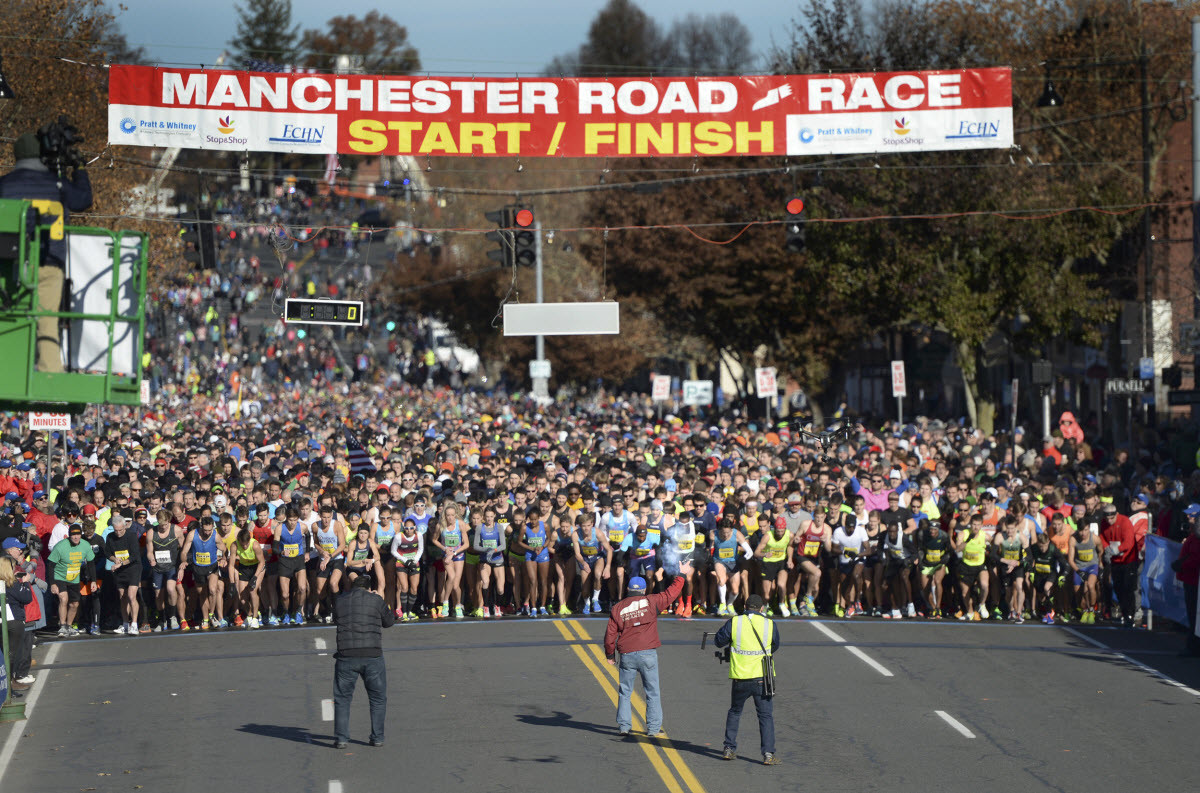
The honor has been described by Boston Marathon champion Bill Rodgers as "the goldmedal of race directing," has been presented annually since 1987 to the nation's best race director. It is considered to be one of the most prestigious awards in the sport of road racing.
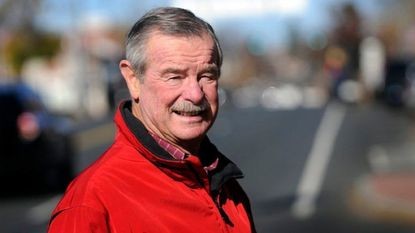
A committee comprised of race directors, athletes, media representatives, corporate executivesand club officials selected Balcome from a group of nominees who were judged on several factors,including overall ability, the reputation of the race, creativity, and organizational ability.
Balcome, 76, coined the race day phrase, "This is Thanksgiving in Manchester," and is known for making Manchester "a runners race" from the elite athletes kicking toward the tape down Main Street to the guy in the back of the 11,000-strong field kicking back in a bunny suit.
Balcome has served as the MRR's race director for 40 years. He's a past president of the Silk City Striders Running Club and competed in the road race for several years before being asked to lead its operations.
He's an Air Force veteran and retired Rockville High School teacher, guidance counselor and track coach who spends between 500 and 600 hours each year performing the "countless tasks" that are necessary to stage a major road race like the MRR, other race officials said.
by Chris Dehnel
Login to leave a comment
Manchester Road Race
The Manchester Road race is one of New England’s oldest and most popular road races. The 86th Manchester Road Race will be held on Thanksgiving Day. It starts and finishes on Main Street, in front of St. James Church. The Connecticut Sports Writers’ Alliance recently honored the Manchester Road Race. The CSWA, which is comprised of sports journalists and broadcasters...
more...Three-time Bix 7 men’s champion Silas Kipruto is coming back to the Quad-City Times Bix 7 in hopes of making a little more history
The three-time Bix 7 men’s champion will be joined in the 45th annual race through the streets of Davenport by a deep women’s field that includes two former champions, the second fastest female runner in the race’s history and a world record-holder in two events.
Kipruto already is among the most successful runners in the history of the race, which is scheduled this year for July 27. The 34-year-old native of Kenya not only won the Bix 7 in 2011, 2012 and 2016, but he has finished in the top five on three other occasions.
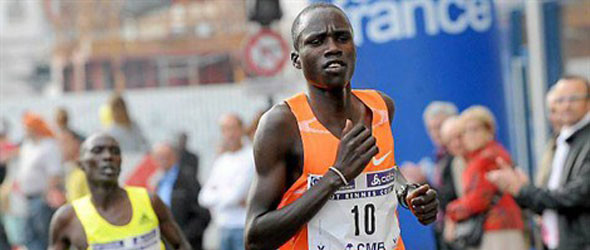
His half dozen top-five finishes equal the most ever by a male runner in the race, tying Meb Keflezighi, Bill Rodgers, John Korir and Lazarus Nyakeraka.
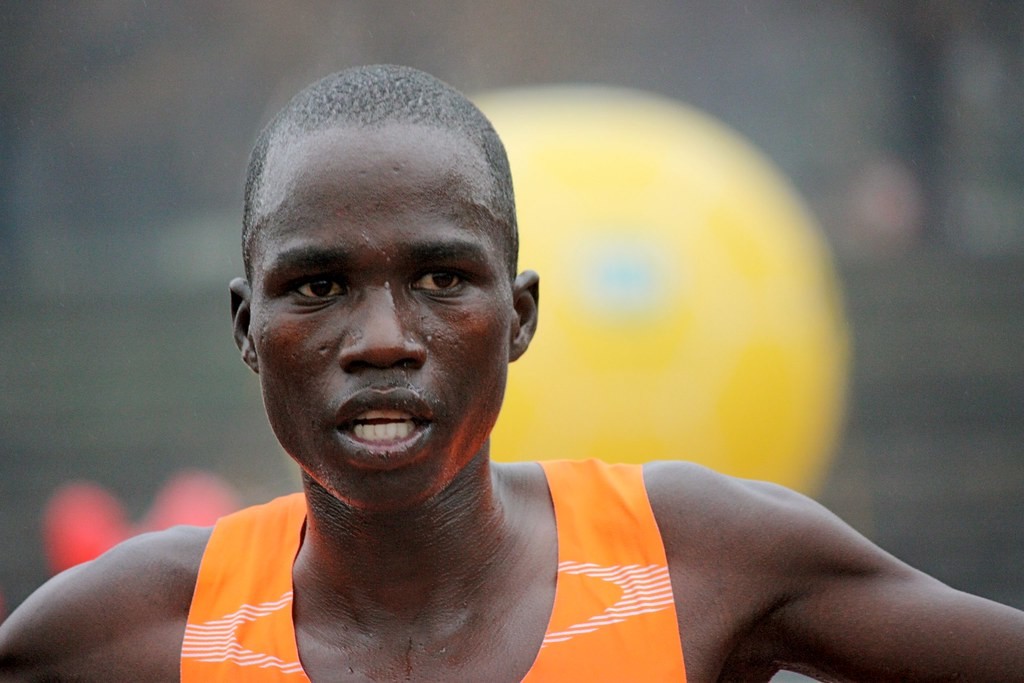
Kipruto is one of 17 African runners in the preliminary men’s elite field assembled by elite athlete coordinator John Tope — 13 from Kenya and two each from Eritrea and Tanzania.
Besides Kipruto, male runners to watch include Tanzania’s Gabriel Geay, who won both the Lilac Bloomsday 12k and the Bay to Breakers 12k in May; Kenya’s Edwin Mokua, a top-three finisher at both Bloomsday and Bay to Breakers; Kenya’s Leonard Barsoton, who was first in the African Cross Country championships in 2014 and second in the African Games 10,000 meters in 2015; and Emmanuel Kiprono, Kenya’s 10,000-meter champ in 2013.
by Kevin E. Schmidt
Login to leave a comment
Bix 7 miler
This race attracts the greatest long distance runners in the world competing to win thousands of dollars in prize money. It is said to be the highest purse of any non-marathon race. Tremendous spectator support, entertainment and post party. Come and try to conquer this challenging course along with over 15,000 other participants, as you "Run With The Best." In...
more...Shelter Island 10K is celebrating it's 40th year this weekend honoring some of the country's Best Runners
Over the course of 40 years, the Shelter Island 10K has stood out from the ever increasing number of summertime charity road races on the East End, and this year, as it marks a milestone, it will be even more special. Some of the biggest names in long-distance racing will be on hand, along with recreational runners of all ages and abilities, to commemorate the 40th year of the race, which raises money for several local charities.
The 10K and 5K run/walk are set for this Saturday, June 15, at 5:30 p.m. It promises to be as popular as ever, with 1,000 runners signed up to participate. The Shelter Island 10K is an event that has always paid homage to the history of road running and will certainly have the star power to prove it this weekend. The race always attracts top talent, with some of the best young Kenyan and Ethiopian runners making the trek to participate, but race organizers also made a special effort this year to honor older runners, many of whom were in the prime of their careers during the race’s inaugural season 39 years ago.
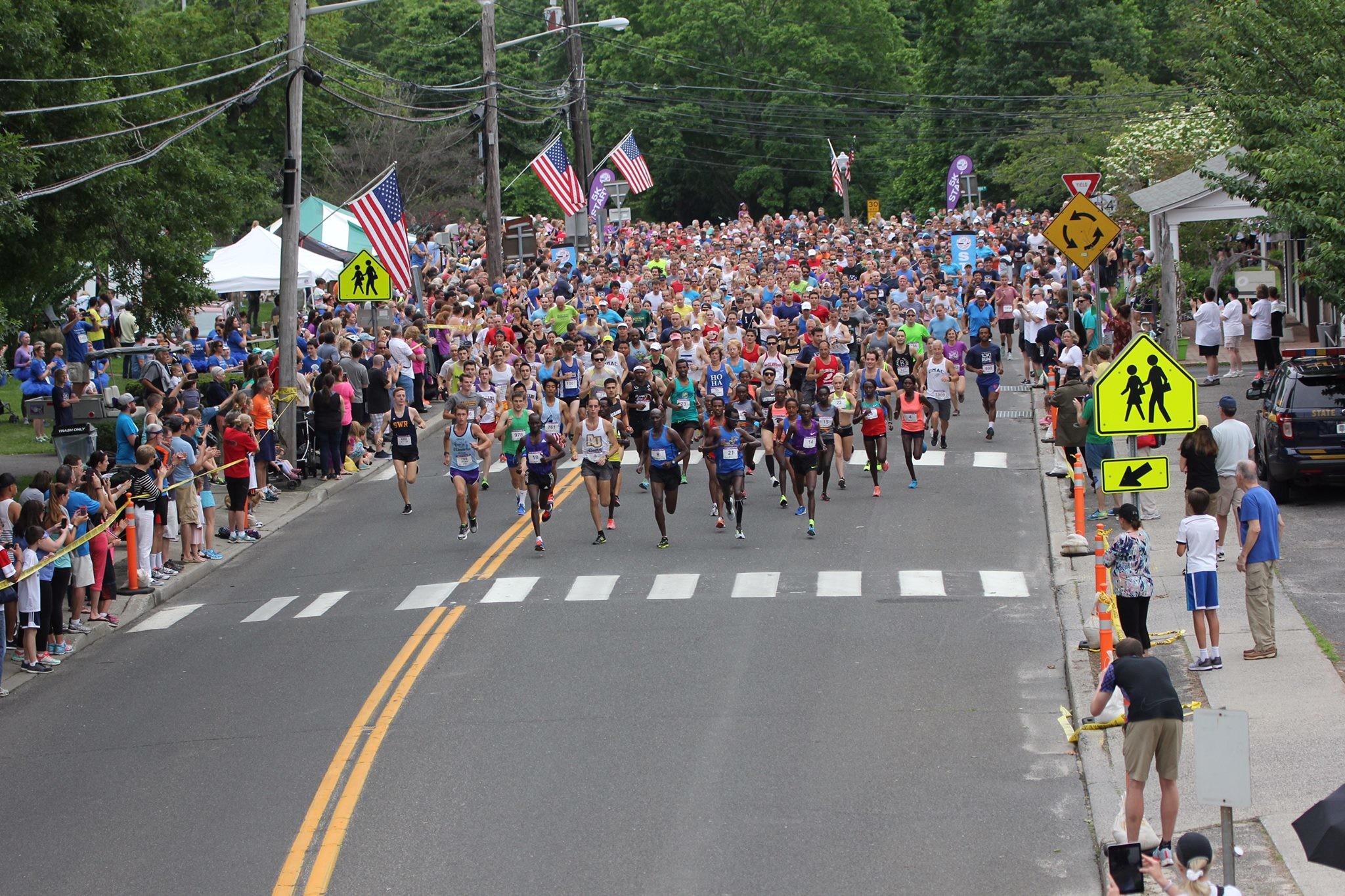
Some of them have become Shelter Island 10K regulars over the years, including former Olympian Bill Rodgers, a four-time winner of both the New York City and Boston marathons, and Joan Benoit Samuelson, an Olympic gold medalist and first-ever women’s Olympic marathon champion.
Veteran marathon runner George A. Hirsch, who is the chairman of the board of the New York Road Runners and previous publisher of Runner’s World, will also be on hand, along with Amby Burfoot, an author, motivational speaker and winner of the 1968 Boston Marathon.
Jon Sinclair and his wife, Kim Jones, are scheduled to attend, along with Keith Brantley. Sinclair is one of the winningest long-distance runners in the country’s history, and Jones is a former elite marathon runner.
New to the race this year will be Benji Durden and Kyle Heffner, and their presence is a nice homage to what was going on in the running world at the time the Shelter Island race was created. Heffner and Durden both qualified for the U.S. Olympic team in 1980 but were unable to compete at that year’s games in Moscow because of the U.S. boycott.
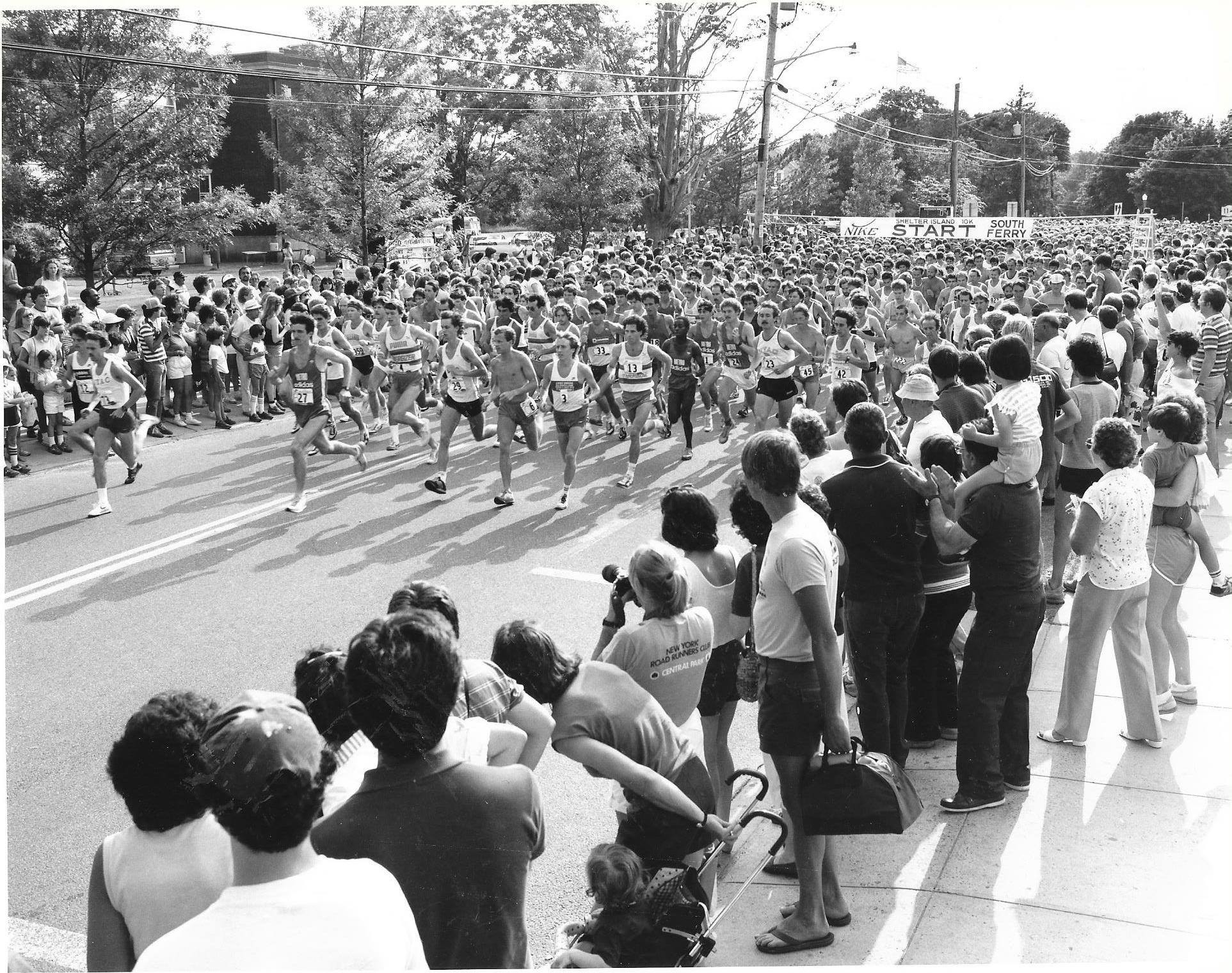
Race director Mary Ellen Adipietro said the tradition of honoring world-class runners has been part of the Shelter Island race since it was founded by Cliff Clark, John Strode and Jack Faith, who were all collegiate runners. Adipietro and her husband, Frank, continued and built on that tradition when she became the race director in 2000, taking over for longtime director Jimmy Richardson.
In keeping with the theme of honoring older runners, this year’s race will include a Masters category, with prize money for men and women in the 40-and-over age group. Anyone who finished the race in less than 40 minutes will receive a complimentary “I broke 40 at the 40th” T-shirt sponsored by Harry Hackett, of Merrill Lynch.
by Cailin Riley
Login to leave a comment
Shelter Island Run
This course has been ranked among the top ten most beautiful courses in the country by Runner’s World Magazine, with areas of the course that allow runners to peer over Dering Harbor, look out at the Orient Point Lighthouse and run through one of the most exclusive private communities in the country. The non-profit Shelter Island Run, Inc. founded in...
more...Two defending champions Risper Gesabwa and Brendan Gregg, are returning for the 43rd annual Bellin Run
Risper Gesabwa and Brendan Gregg have signed on to the 10K on June 8.
Gesabwa broke the tape last year, setting a record sixth Bellin Run title, followed closely by 2017 champ Kaitlin Gregg Goodman.
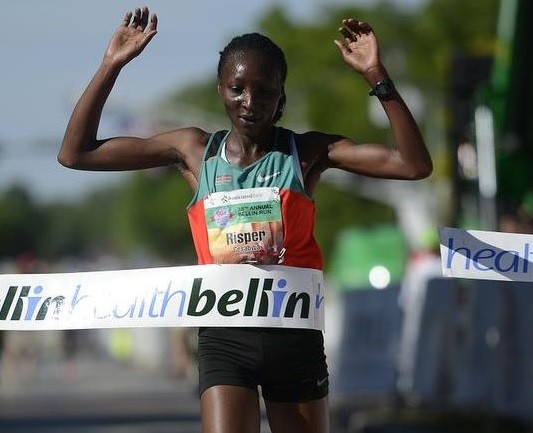
Goodman and Gesabwa have history. Goodman also finished a close second to Gesabwa in 2016, meaning their 2019 rematch will be one to watch.
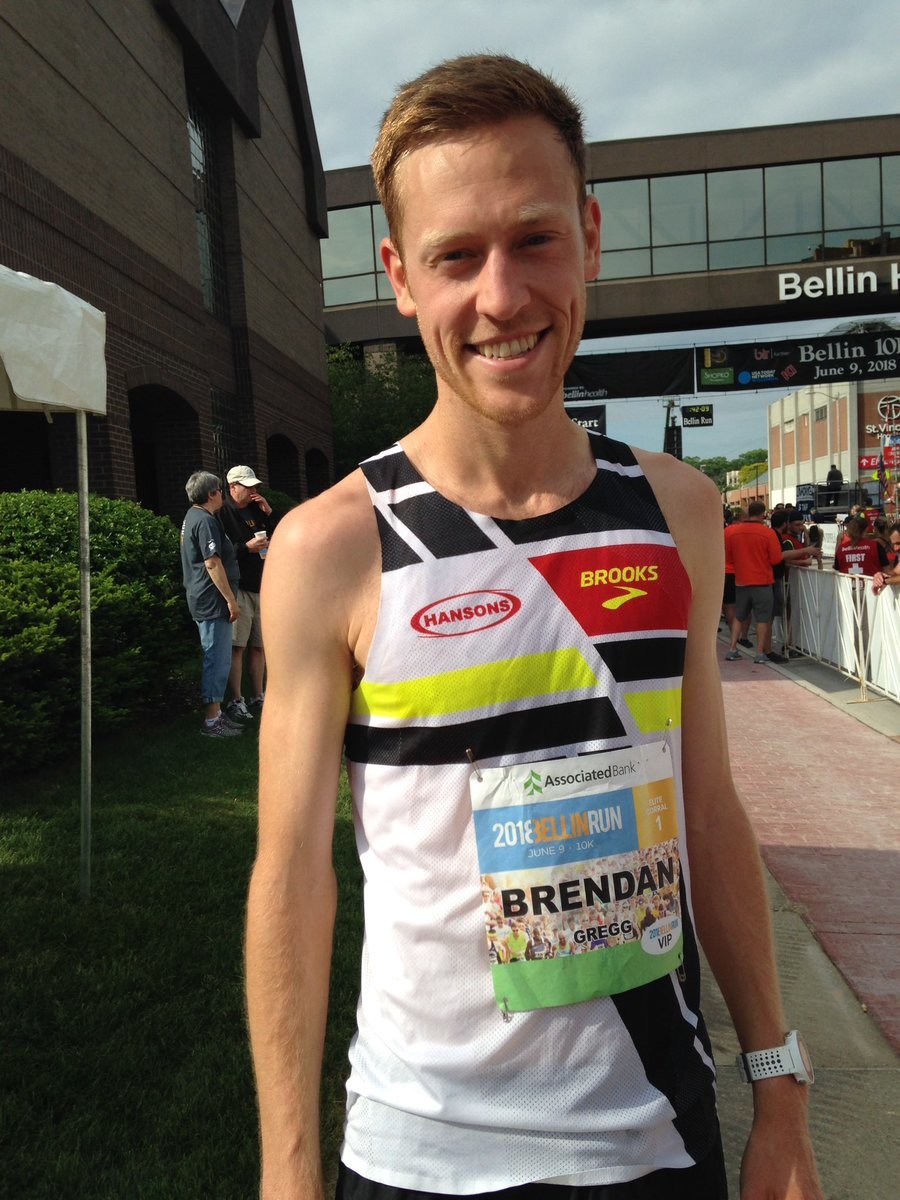
Kaitlin's brother, Brendan will try to get a second consecutive Bellin Run victory after winning last year's run. He will be up against former Bellin Run champ, Meb Keflezighi and 2016 Olympic marathoner, Jared Ward.
Other notable veteran athletes to participate this year are Uta Pippig, Joan Samuelson and Bill Rodgers.
The last of the 12,050 Bellin Run entrants had barely crossed the South Webster Avenue starting line Saturday morning when Brendan Gregg arrived at the finish.
Gregg finished the 42nd annual 10-kilometer race through Green Bay and Allouez in an impressive 29 minutes, 52 seconds. Meb Keflezighi, the 2016 Bellin winner, finished second with a time of 31:06. Jared Ward, at 31:19, was third for the second straight year.
Risper Gesabwa won a record sixth women's elite division title, finishing in 33:24; 2017 champ Kaitlin Goodman — Gregg's sister — was second at 33:30. Dawn Grunnagle was third at 35:29.
Saturday's event began under partly-cloudy skies, with a temperature of 62. More than 12,000 runners registered; 13,892 took part a year earlier.
The first Bellin Run, in 1977, had 881 participants. It grew to 1,100 in year two.
"I remember the days where you could stand on Greene Avenue and see groups of runners, and see the street in-between," said Green Bay resident Bob Cramer, who began running the Bellin in 1984. "Now, it's wall-to-wall people."
Joseph Kimani retains the men’s course record of 27:46, set in 1997. Tegla Loroupe holds the women’s course record of 31:48, set in 1999.
Login to leave a comment
Bellin 10k Run
The Bellin Run, a 10K held annually in Green Bay, Wisconsin on the second Saturday in June, is one of the region’s premier sporting events and has grown to be one of the largest 10K races in the nation. The event was first held on June 12, 1977, and was known as the Bellin Heartwarming Run, to promote cardiovascular fitness....
more...A Long Run the movie tells one man's story, but it's every runner's journey. Bob Anderson's life connects us to many icons...by the end, you're left with a runner's high without the sweat says Dan Brown
Over 100,000 people have already watched A Long Run the movie with good reviews. Now you can watch the full length movie...compliments of MyBestRuns.com with speical arrangments with it's production company Around Town Productions.
Actor Sean Astin who narrated the film wrote, "I loved A Long Run. Thank you so much for letting me be a part of your wonderful journey Bob." Boston Marathon director Dave McGillivray wrote," In watching A Long Run, you readily see the impact and influence Bob has had on our sport over the years. This story is inspiring, motivational, educational and simply makes you want to go out the door and do a run..and a real 'long run' at that."
Joe Henderson writer and former Runner's World editor wrote, "I’ve always known Bob Anderson as a man of Big Ideas, one with a knack for making these dreams come true. He conceived a little magazine called Distance Running News, which grew into the biggest one, Runner’s World.
"He created a book division that published some of the sport’s best-selling titles...This all happened before Bob turned 30, but his idea-generating didn’t stop then. At more than twice that age, he dreamed up Double Racing and then to celebrate his 50th anniversary as a runner, Bob plotted a tough year-long course: 50 races, averaging better than seven minutes per mile overall, concluding the week he would turn 65."
A Long Run tells one man's story, but it's every runner's journey. Bob Anderson's amazing life connects us to icons like Bill Rodgers, Billy Mills and Paula Radcliffe but also to the low-budget thrill of a community 5k. The gorgeous cinematography captures The Avenue of the Giants, the beauty of Central Park in New York City, the San Francisco landscapes, resort cities like Cancun and Cabo, the lush island of Kauai and the vistas of Fort Bragg.
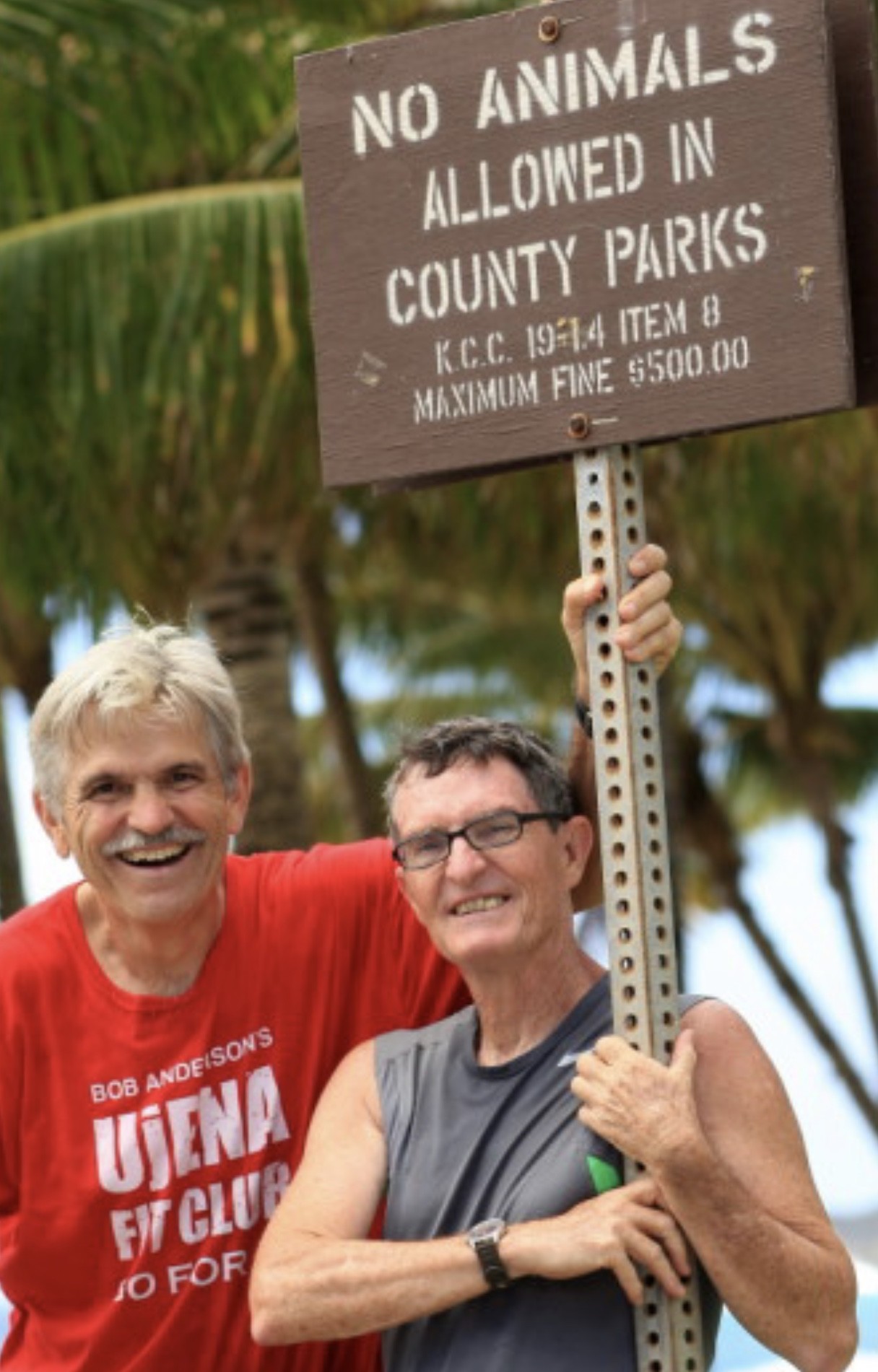
And the smoothly intertwined stories - his 50-race challenge, the magazine, the running boom - are handled with Olympic-caliber pacing. By the end, you're left with a runner's high, without all the sweat.
This is an inspirational life long journey that takes you across the United States, into Mexico and introduces you to some amazing runners.
A Long Run features Bob Anderson who started Runner's World magazine when he was 17 with $100. He grew the magazine to nearly a half million circulation with monthly readership of nearly 2.5 million before selling it to Rodale Press in 1984. How did he do it and why did he sell the magazine he loved?
50 years after he started running, he started his 50 race challenge... one year - 50 races - 350 miles.
His goal - Average under a 7 min/mile average pace at 64-years-old. That's fast for any age!
In the running formula known as age-grading, Anderson’s mile pace is the equivalent of a 30-year-old running an average pace of 5:24 for 50 races covering 350 miles.
“I wanted to do something special, something that would be very positive for running,” Anderson said. “But I also wanted to do something that would not be easy.”
Did he reach his goal? How did he cope with injuries? Weather? Hills? How did he recover each week?
Bob Anderson first run took place Feb. 16, 1962. His first race was May 7 that year, when he covered 600 yards at Broadmoor Junior High in 1 minute, 39 seconds. By 1963 at age 15 he placed first at the Junior Olympics in Missouri clocking 2:08.5 for 880 yards.
By 17, Anderson wanted to tackle a marathon. He wanted to run the Boston Marathon. But neither he nor his high school coach (coach McGuire) knew how to prepare. So Anderson did the 1965 equivalent of a Google search: He sent letters around the country asking for advice.
Coaches and top athletes replied not just with training tips, but also with addresses of other people Anderson should try. Soon he had a network of running experts at his disposal.
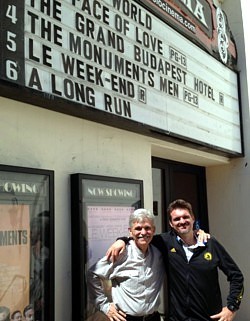
Recognizing the value of this collected wisdom, he turned to teammate David Zimmerman while on a bus trip to a cross-country meet for their Shawnee Mission West team. “I’m going to start a magazine,” Anderson declared.
With $100 from baby-sitting and lawn-mowing jobs, the 17-year-old launched Distance Running News. The magazine debuted in January 1966 with a 28-page issue that Anderson collated, stapled and folded himself.
The publication created a stir among a previously unknown army of foot soldiers. Thirsty runners plunked down the $1 subscription price (for two issues) — and often enclosed an additional $5 just to make sure the magazine stayed afloat.
“Until then, I wasn’t even aware that there was a running community,” said SF Bay Area runner Rich Stiller, who had been running with Anderson since the early 1970s. “I always think that Runner’s World was part of the jet-propulsion that really made the running boom take off and made people realize, ‘Oh, gee, I’m not doing this alone.’ ”
The magazine grew so quickly that Anderson dropped out of Kansas State University. He recruited a SF Bay Area writer and runner named Joe Henderson to be his editor, and moved the magazine headquarters to Northern California.
Anderson’s 50-for-50 goal was in jeopardy after he stumbled out of the gate or, more specifically, down a trail in Mountain View.
While on a training run in December, Anderson awoke to find his head streaming with blood and two people standing above him looking alarmed.
“There were no marks at all on my hands, which means I must not have even realized I was going down,” he said.
The fall required over 60 stitches and plastic surgery. But determined not to cancel the first race in his 50-race quest, Anderson limped to the starting line in San Francisco on New Year’s Day with a ruddy forehead and an eggplant of a bruise on his left knee. He finished that first race and then 49 more that year.
When Bob was publishing Runner's World he got so consumed managing a staff of 350 and was not able to train enough to run the Boston Marathon. However he did run ten marathons between 1968 to 1984 but none with enough training. He would not run Boston until 2013 when at age 65 he clocked 3:32:17.
A Long Run the movie covers a lot of ground. The year long event finished over six years ago but the story is fresh and a movie all runners and even non-runners will enjoy. You will want to watch it over and over again.
Some of the runners besides Bob Anderson featured in the film include: Bill Rodgers, Paula Radcliffe, Joe Henderson, George Hirsch, Rich Benyo, Amol Sexena, JoAnn Dahlkoetter, Rich Stiller, Hans Schmid, JT Service, Pina Family, Wall Family, Billy Mills, Gerry Lindgren, Dave Zimmerman, Dean Karnazes, Monica Jo Nicholson, Coach Lloyd McGuire, Katie McGuire, Mary Etta Blanchard, John Young, Roger Wright and more...
It was produced by Around Town Productions and directed by Michael Anderson (third photo at one of the showings in a theater in Monterey).
To watch the movie click on the link or go to: www.alongrun.com
by Dan Brown
Login to leave a comment
John Hancock today announced its Elite Athlete Ambassador Team for the 2019 Boston Marathon
Boston Marathon champions Meb Keflezighi, Tatyana McFadden, Bill Rodgers, Joan Benoit Samuelson, Greg Meyer and Uta Pippig will join Shalane Flanagan, Ryan Hall, Deena Kastor, Becca Pizzi and Team Hoyt as ambassadors for this year’s race.
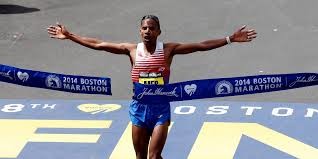
“As Patriots’ Day nears, we welcome our 2019 Elite Ambassador Team for the Boston Marathon,” said John Hancock Chief Marketing Officer Barbara Goose.
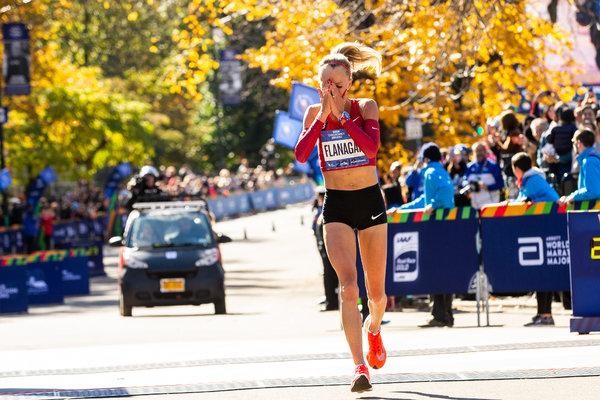
“Through their mentorship and inclusiveness, these accomplished athletes inspire runners of all ages and abilities during race week and throughout the year at John Hancock sponsored events.
The team has become an integral part of our community.”
Ambassadors will cheer on the 30,000 participants racing from Hopkinton to Boston on Patriots’ Day and attend media, community and race week events, including making appearances at the Runner’s Seminar at the Expo, surprise “meet and greets” near the finish line, and at the John Hancock Elite Athlete press conference on April 12 at 10 a.m. at the Fairmont Copley.
Login to leave a comment
Boston Marathon
Among the nation’s oldest athletic clubs, the B.A.A. was established in 1887, and, in 1896, more than half of the U.S. Olympic Team at the first modern games was composed of B.A.A. club members. The Olympic Games provided the inspiration for the first Boston Marathon, which culminated the B.A.A. Games on April 19, 1897. John J. McDermott emerged from a...
more...Gary Allen, founder of the Mount Desert Island Marathon and the Millinocket Marathon named race director of the year
Login to leave a comment
Bill Rodgers never misses the Bix 7 even with lingering achilles tendinitis
Login to leave a comment
Global Run Challenge Profile: Phil Camp is a lifetime runner with plenty of cool stories to tell
by Bob Anderson
Login to leave a comment
Elite Field is set for the 42nd Bellin 10K in Green Bay Wisconsin
Login to leave a comment
Boston narrated by Matt Damon on the big screen April 12-19 in Boston
Login to leave a comment
Happy 70th Birthday to Bill Rodgers!
Login to leave a comment
Matt Damon Has Fond memories of Boston Maraton
Login to leave a comment





